After 4 days of modern Japanese city life in Osaka, I was excited to experience & see a more traditional side of Japan in Kyoto. Memoirs of a Geisha, which takes place in Kyoto, is one of my all-time favorite historical fiction novels, so having the opportunity to be in Kyoto was surreal for me. There were many moments on my visit where I felt like I had been transported back in time. In this blog post, I’ll be sharing my perfect 2-day itinerary in Kyoto, Japan which features a nice mix of wandering, visiting famous sites, sampling lots of flavors, and getting a feel for the local life (and local art!) So if you’re short on time but want to get the most out of your visit to Kyoto, then this itinerary is for you!
But first, are 2 days in Kyoto enough?
Although I am sure you could spend much more time than just 2 days, I personally felt very satisfied with a full 2 days in Kyoto. If you are short on time, I would say that 2 days will work just fine, as it certainly did for us!
2-Day Itinerary in Kyoto: DAY 1
Highlights: Bamboo Forest, Kimono Forest, Nishiki Market, Pontocho Alley, Gion
1. Make your way to the Bamboo Forest first thing in the morning
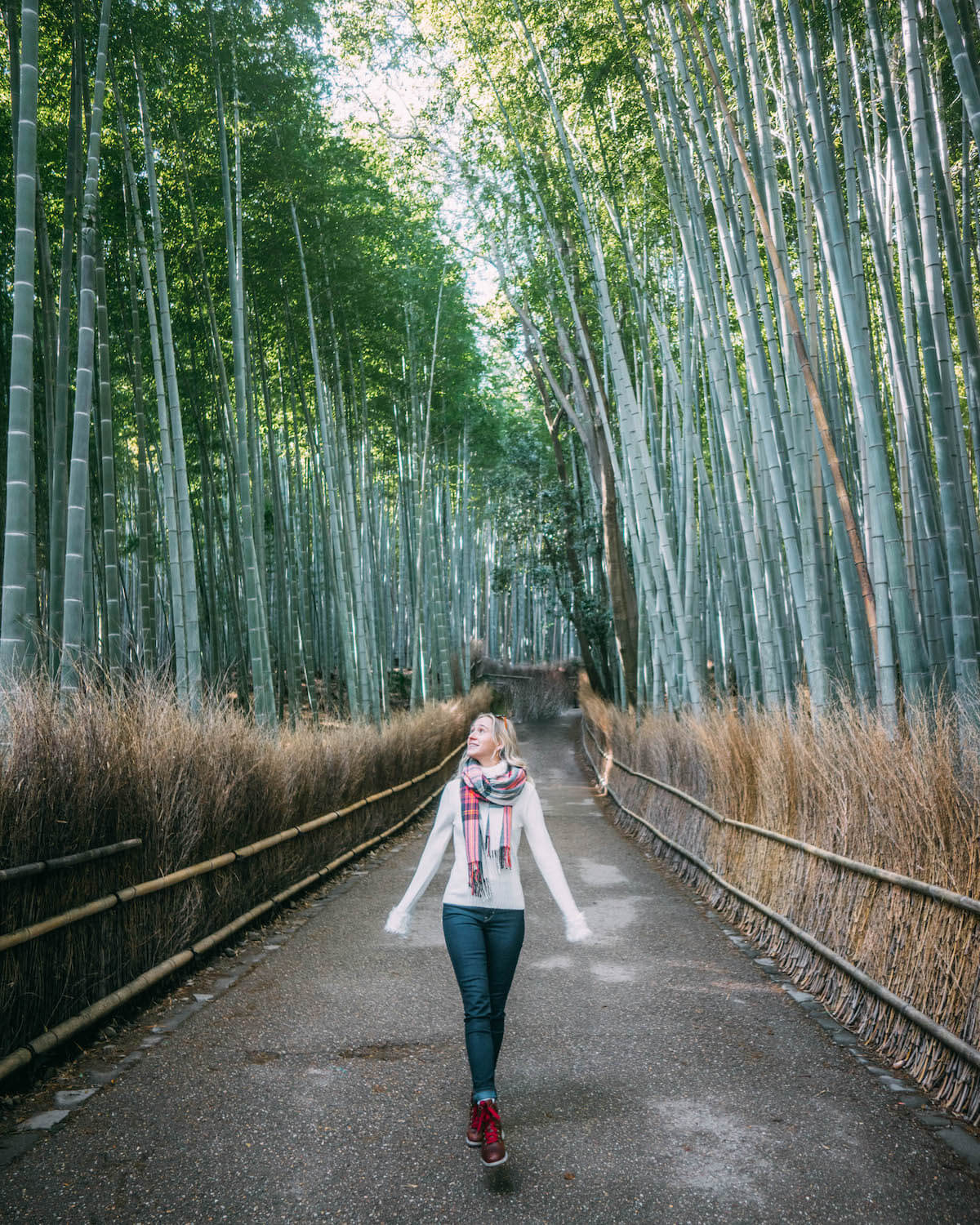
Okay, so the reason I am putting the Bamboo Forest as the first thing to do on the 2-day itinerary in Kyoto is that if you happen to sleep in and have less time than you anticipated, this would be the first thing I would cut out. You’re probably thinking, well then why even put it on your list at all? Here’s why: The Bamboo Forest definitely is beautiful and mysterious, but you have to travel an hour each way by bus (or train) in order to get there. Those who have seen a lot of bamboo in their life may not find this worth the journey.
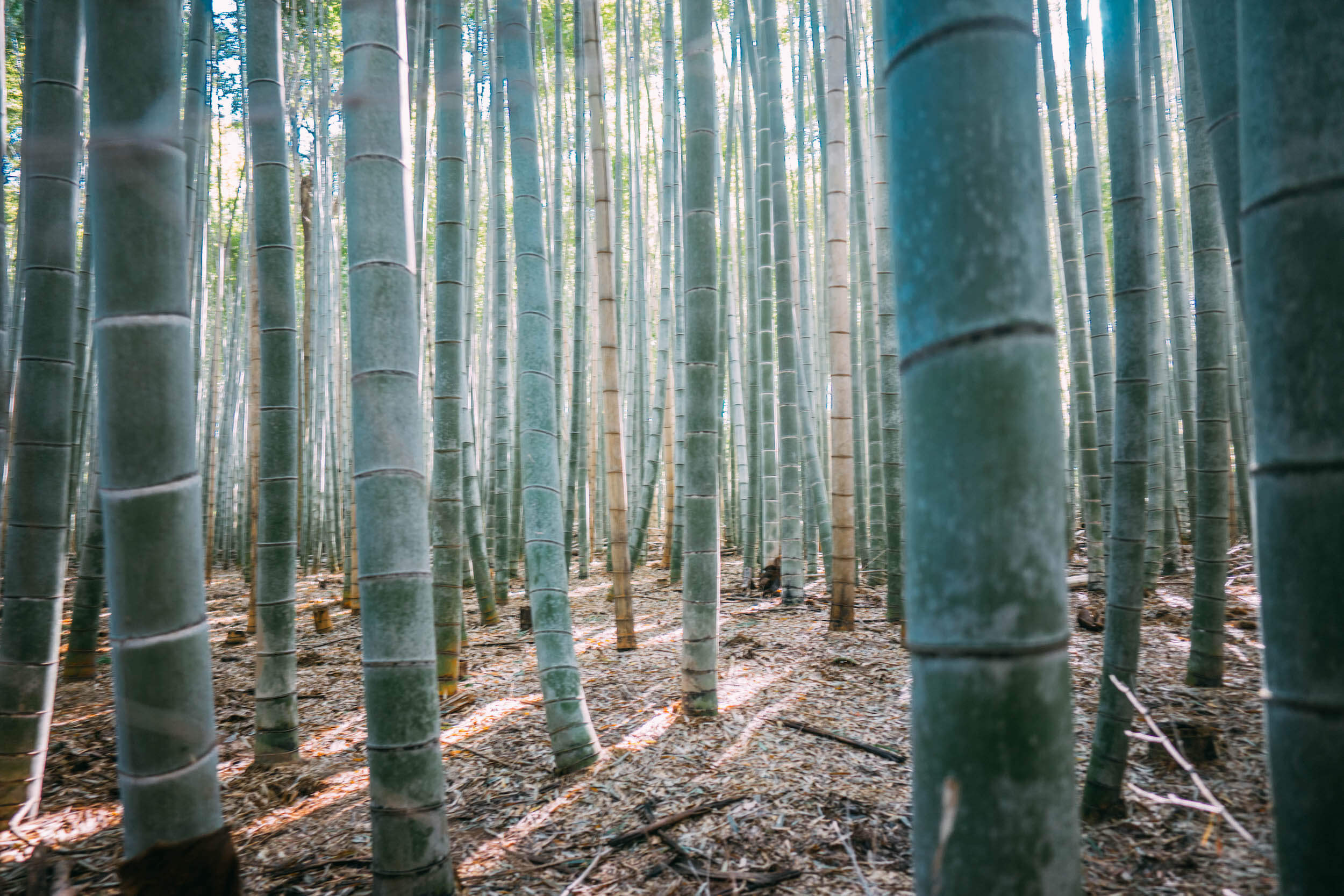
However, if you haven’t seen much bamboo in your life, this is definitely a cool place to check out! The other reason I recommend going early is to avoid crowds. This is a very popular tourist destination and the pathways that look empty in these photos quickly turn into traffic jams of tourists!
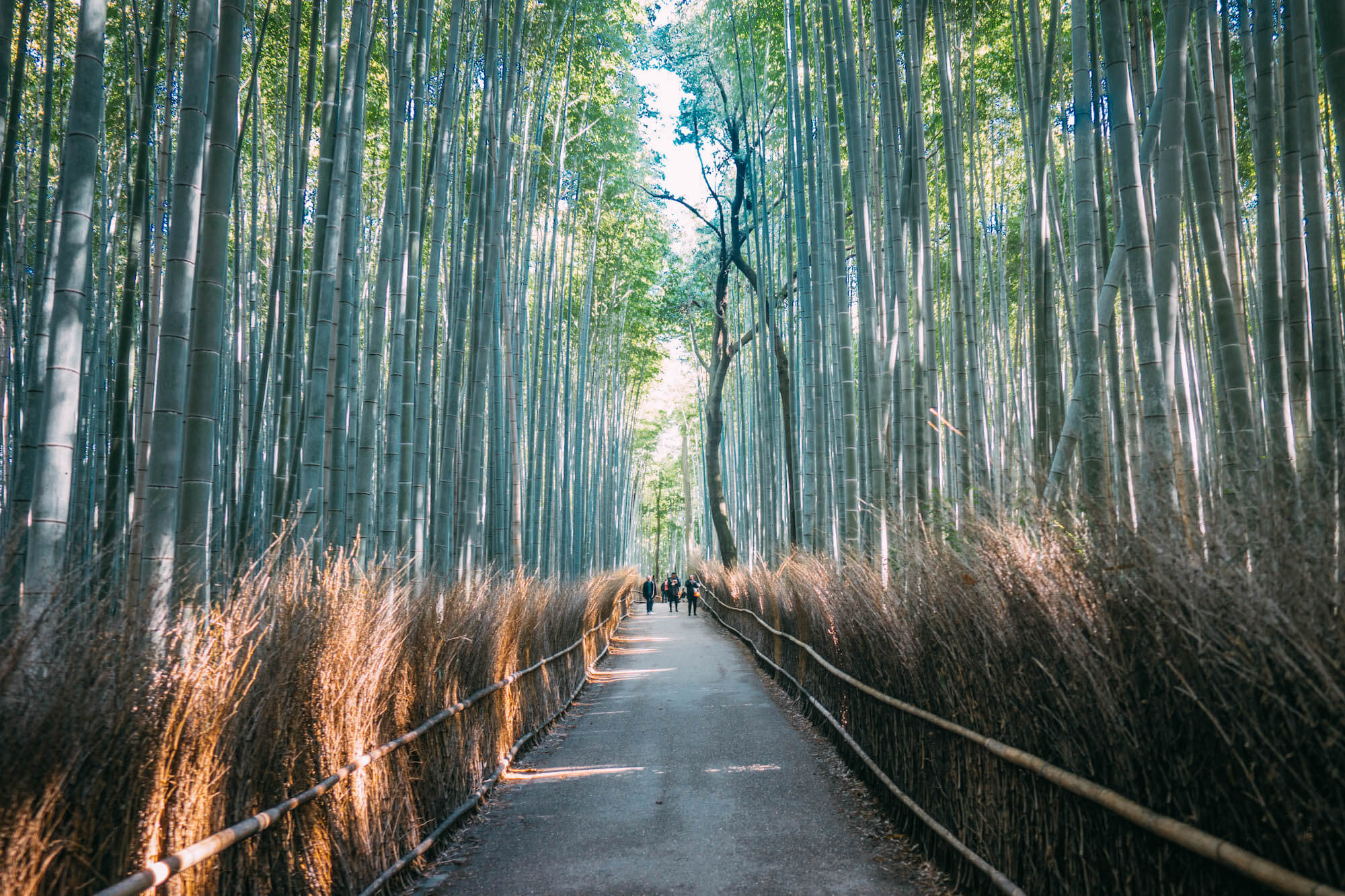
The Bamboo Forest is also a lot smaller than I expected, so you probably won’t spend more than 30 minutes walking along the pathways. Nearby, there are many beautiful temples to see (Tenryu-ji Temple is one of the most famous), but most of them cost an entrance fee to enter. The Bamboo Forest, however, is free to enter.
Getting here: Coming from BnA Alter Museum which is where we were staying, you can take the #11 bus from the Shijokawaramachi Bus Stop 27 stops to the Nonomiya Bus stop which is right outside of the Bamboo Forest (these buses leave every 20 minutes and are pretty much exactly on time, so check Google Maps for timing and when the next one is arriving).
2. Make a stop at Nonomiya Jinja Shrine
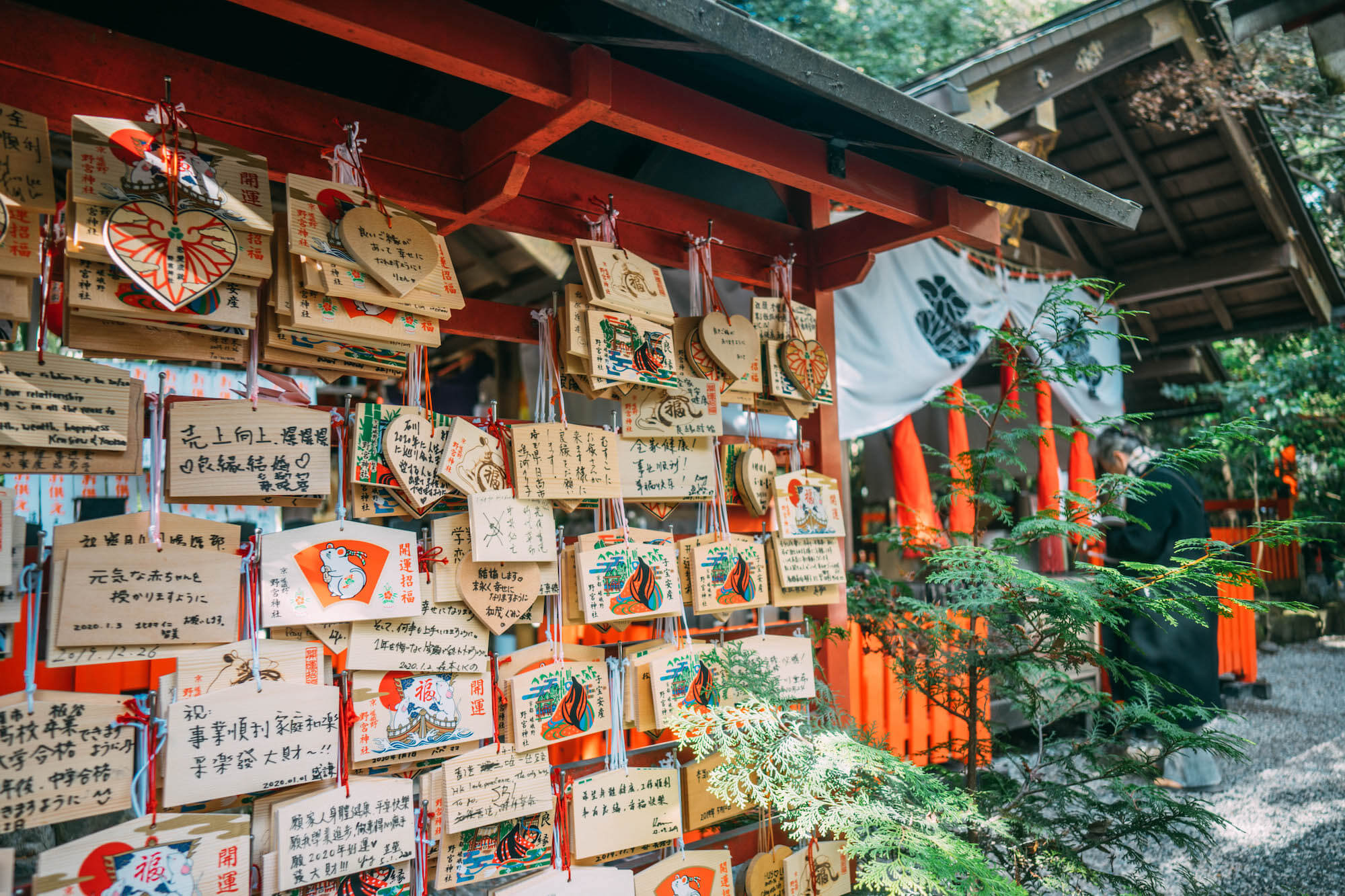
Inside the Bamboo Forest is Nonomiya Jinja Shrine which is free to enter and is a perfect spot to stop and observe Japanese people engaging in traditional rituals. We happened to be in Japan just after the New Year, so it seemed that there were extra celebrations going on. In the photo above you can see a few ornaments with a rat painted on them – 2020 is the year of the rat!
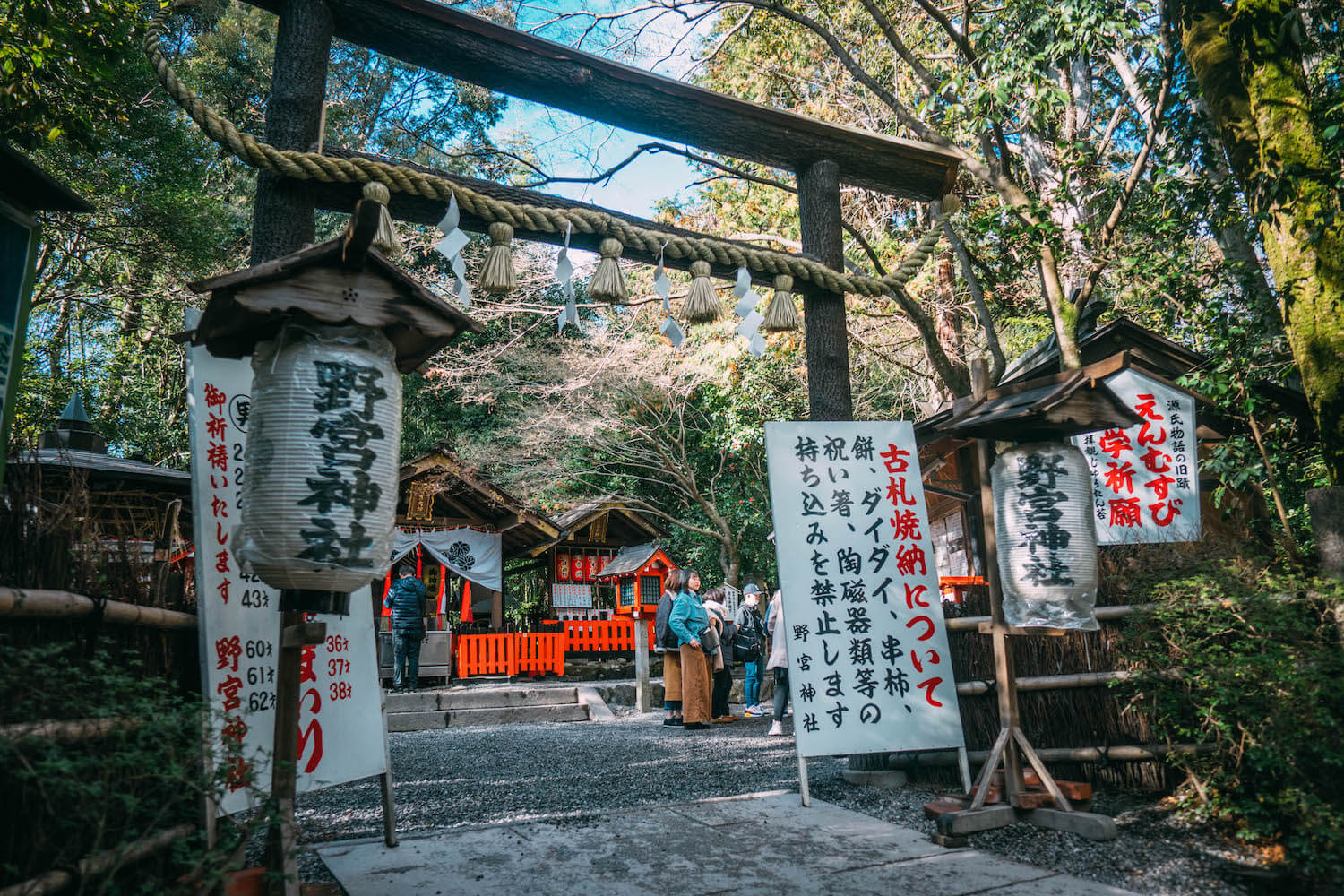
3. Admire the Kimono fabrics at Kimono Forest
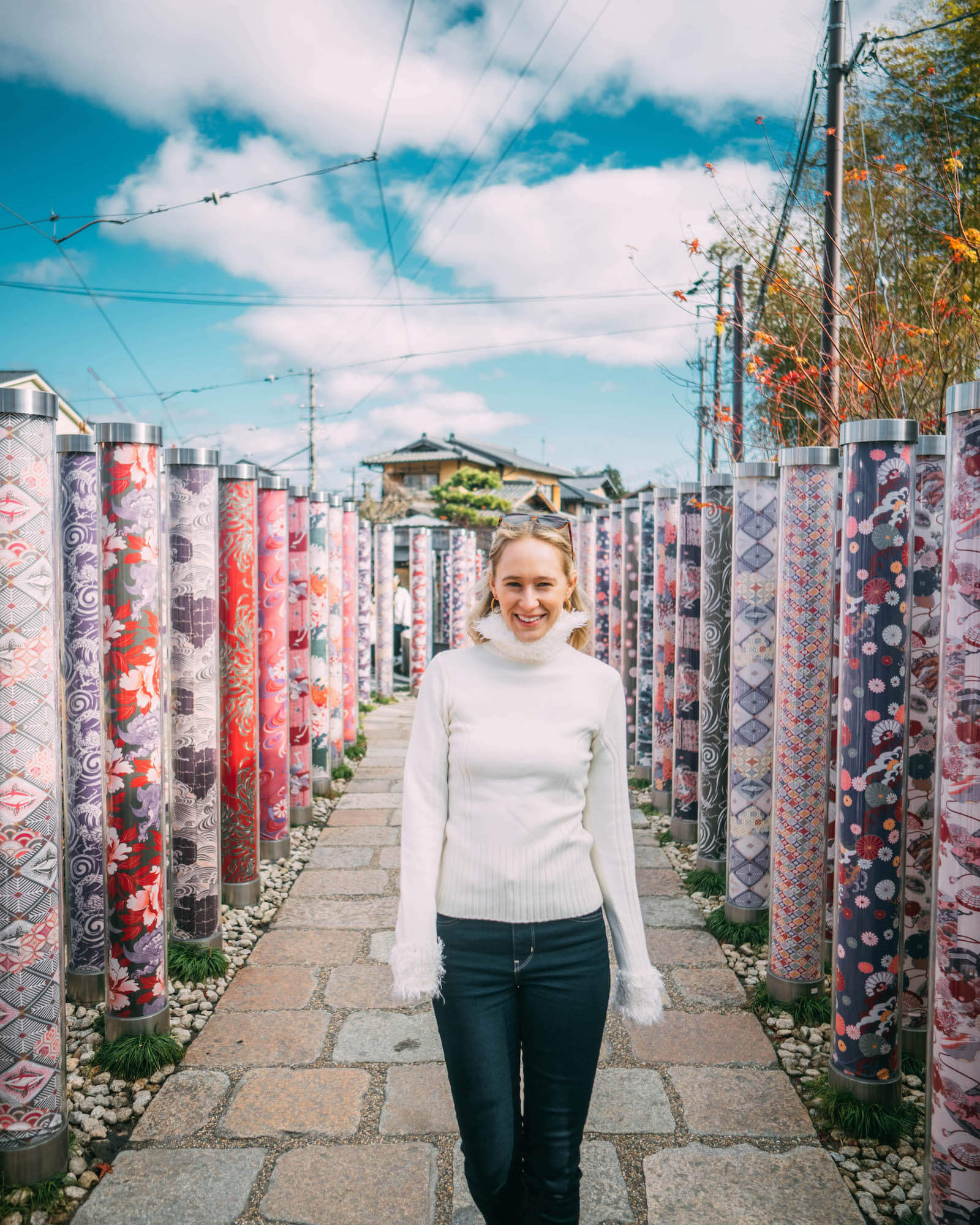
Just down the street from the Bamboo Forest is the Kimono Forest, which is a train-stop art installation with 600 backlit pillars adorned with vibrant kimono textiles. I am fascinated by Kimono and its importance within Japanese culture, so this was an extra special surprise to have stumbled upon while visiting the Bamboo Forest.
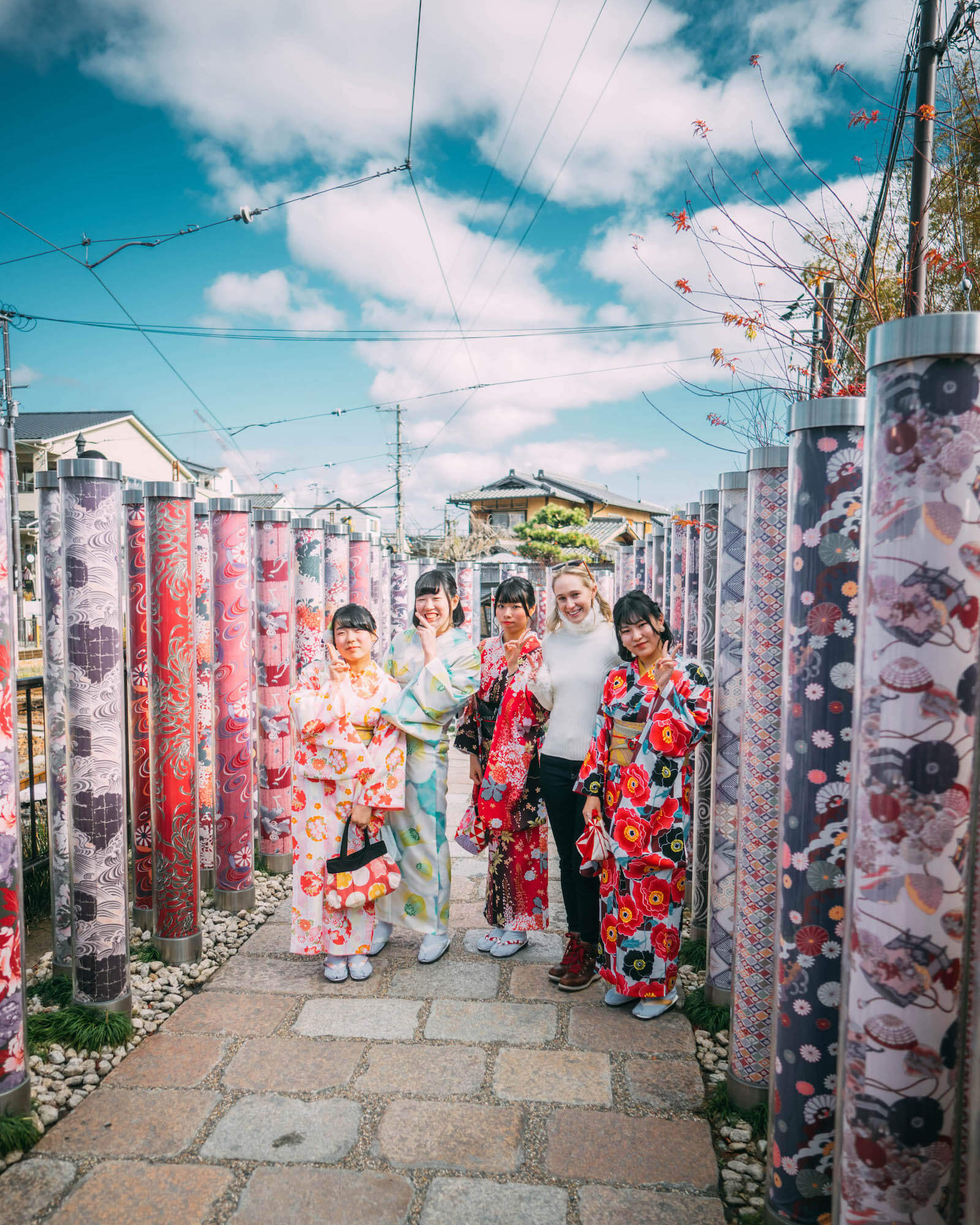
As you can see, I made a few friends along the way! A really popular thing to do while in Kyoto is to dress up in Kimono. These girls I met went to a Kimono rental shop to dress up for the day. I did not opt to do this for a few reasons, one of them being it IS COLD in Japan in January – these girls must have been freezing!
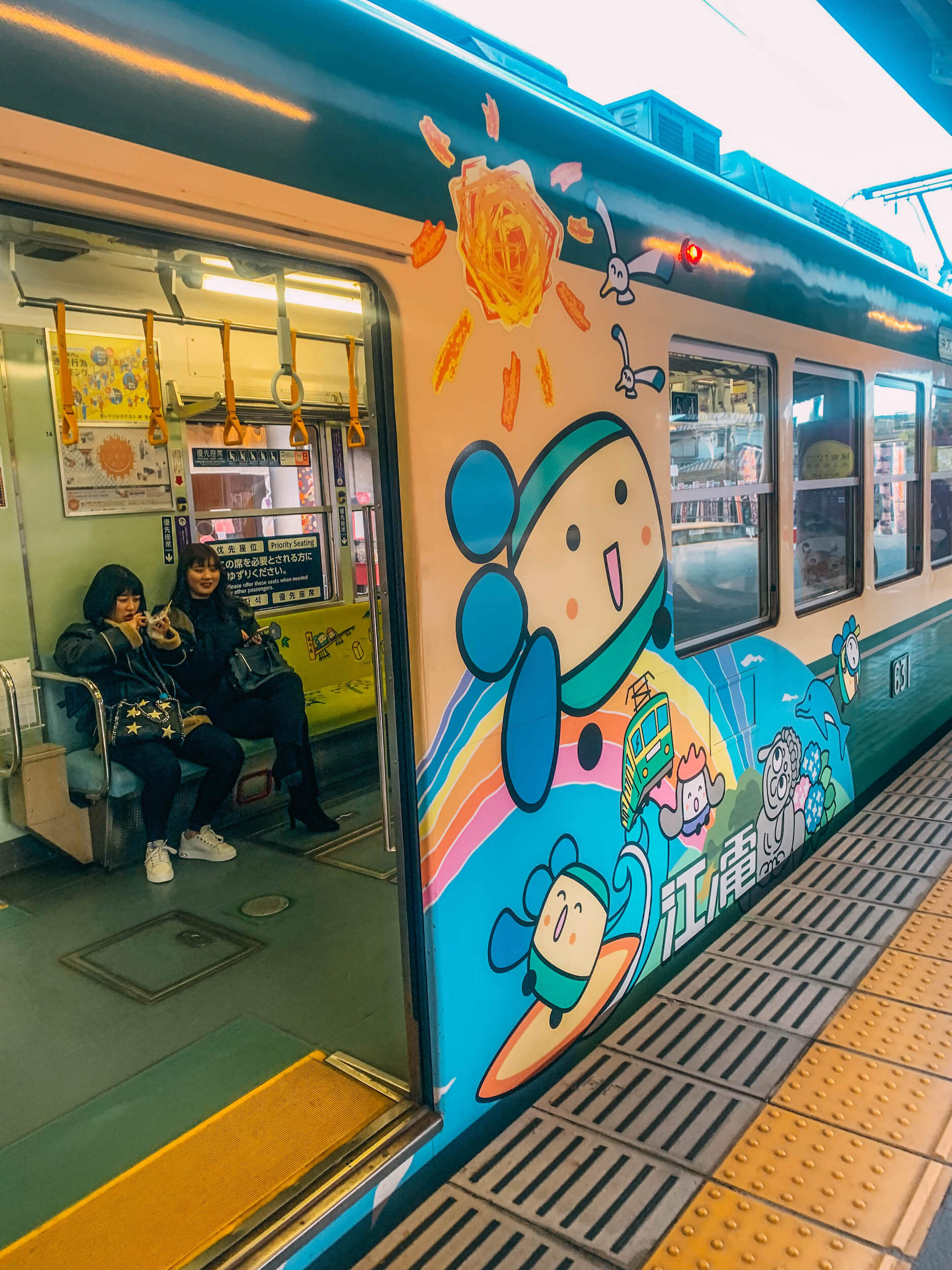
Once you’re done checking out the Kimono Forest art installation, you can hop on this colorful train at Arashiyama Station train to get back to Kyoto. It is literally right next to the art-installation and is a really easy way to make your way back to the city.
4. Take a walk down Pontocho Alley
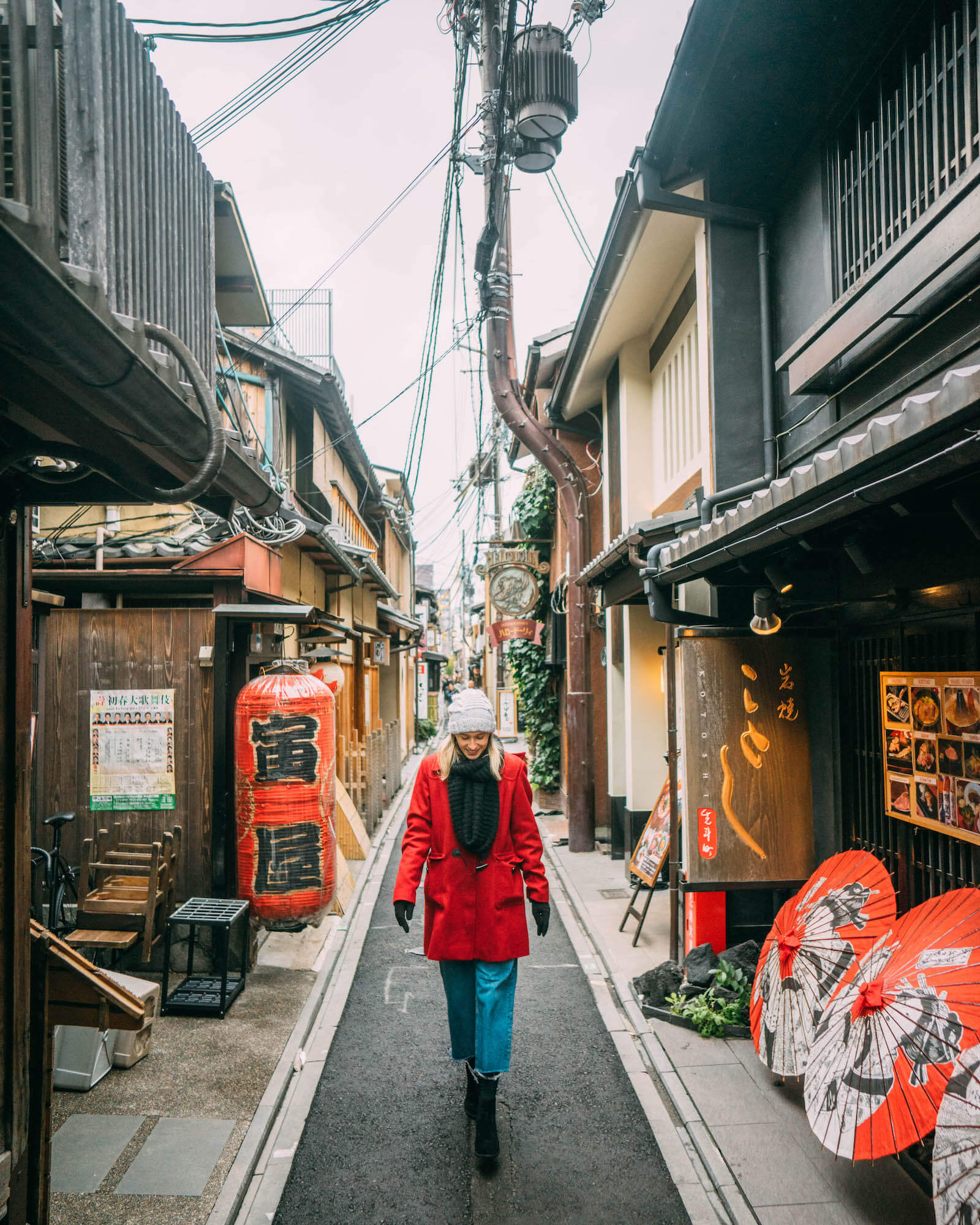
This 2-day itinerary in Kyoto would simply not be complete without a visit to Pontocho Alley. Pontocho Alley is specifically known for its preservation of traditional tea houses and Japanese architecture, but above all, it’s known for being a place to spot Geisha if you’re lucky!
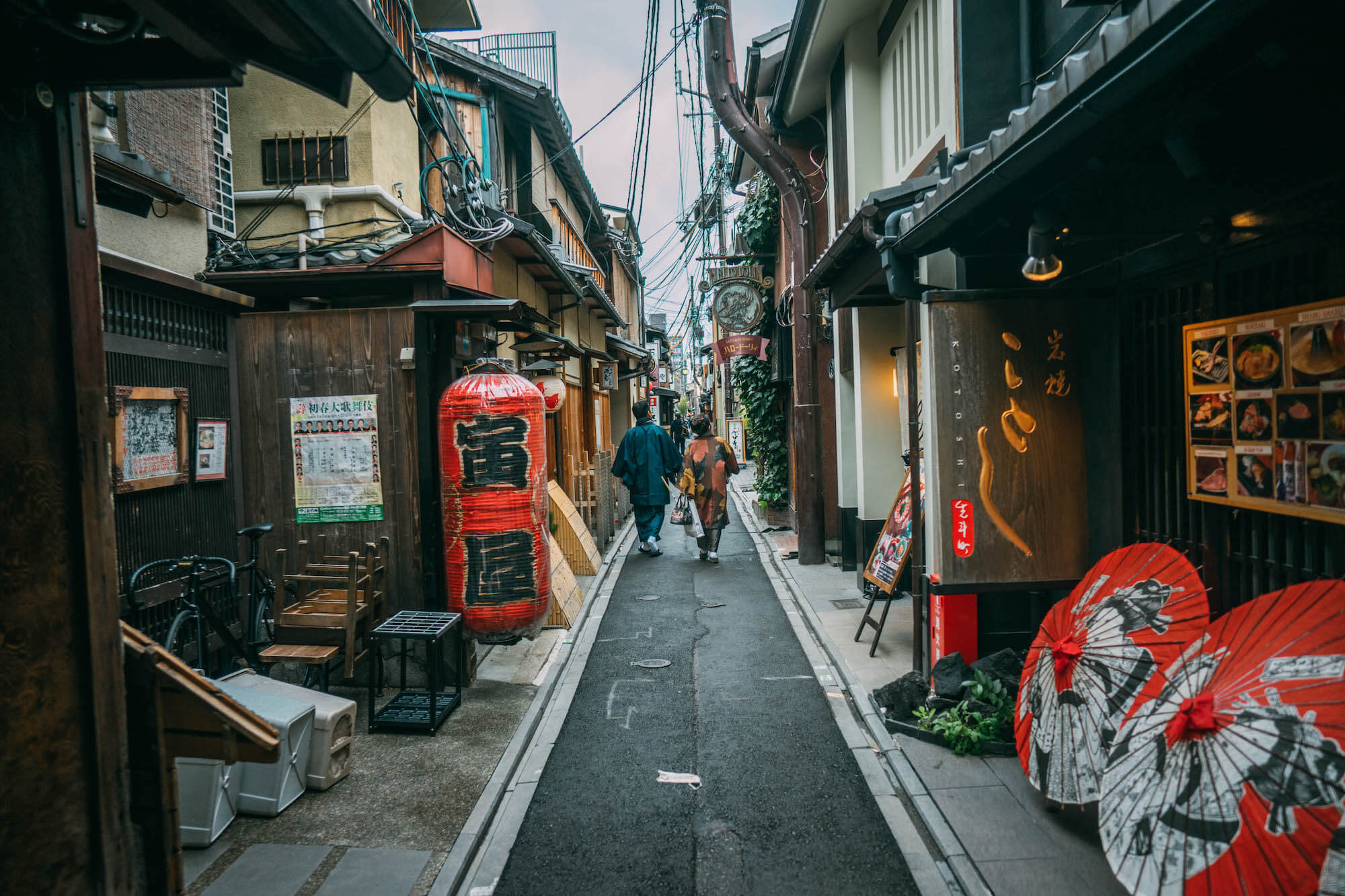
Although you absolutely MUST visit Pontocho Alley at night to feel its true ambiance and mysteriousness, I also recommend having a little jaunt down this alley during the day! You will probably notice some details you may miss in the nighttime.
As mentioned earlier, Memoirs of a Geisha is one of my all-time favorite books, and I said that if I saw a real-life Geisha by chance (not at a dinner/performance for tourists, but down an alley going to entertain for real) my trip to Japan would be MADE. Well, one evening after leaving a whiskey bar on Pontocho Alley, I SPOTTED A GEISHA LEAVING ONE TEA HOUSE TO GO TO ANOTHER (pictured below)!
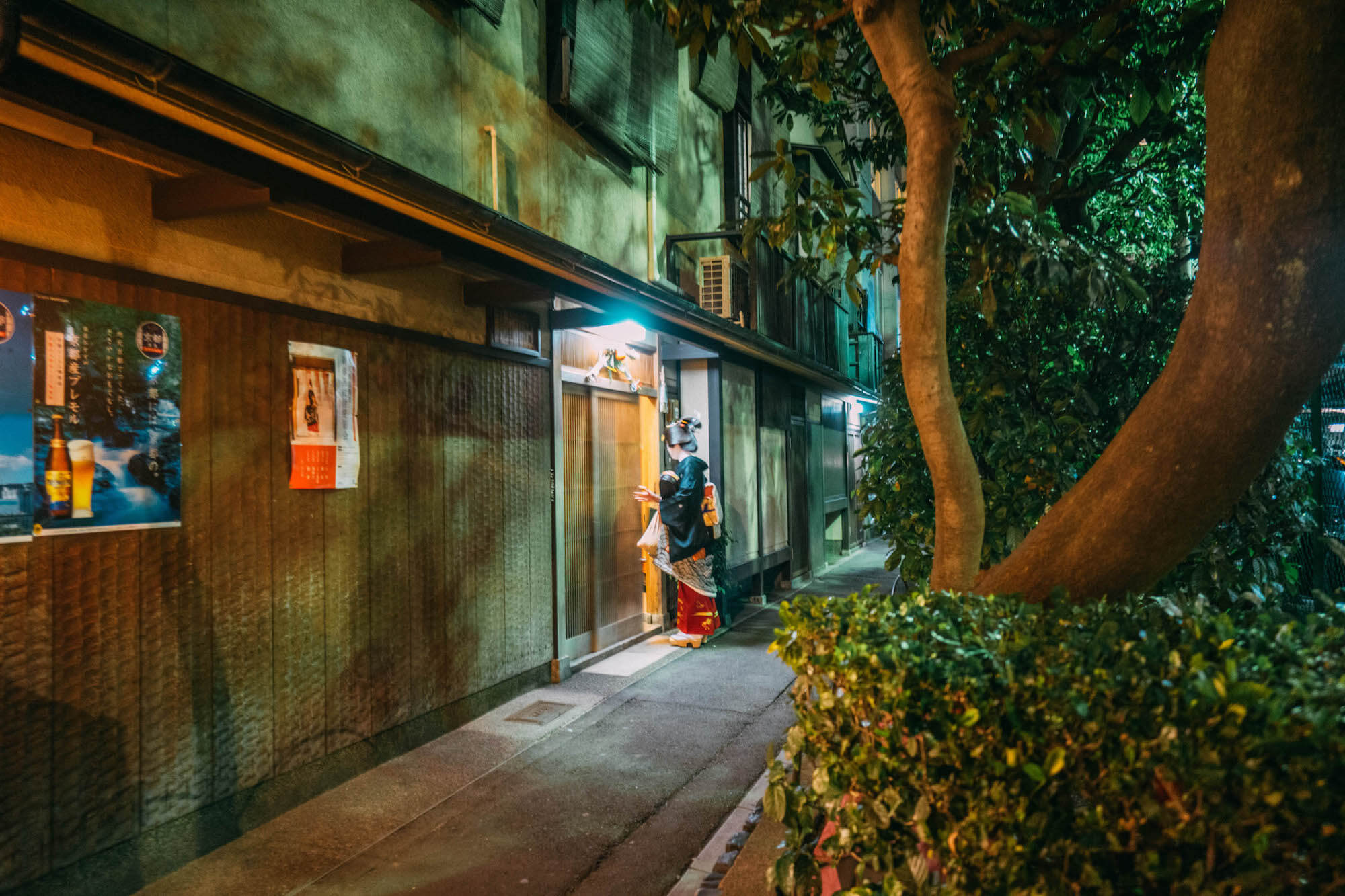
So, long story short, I caught a tiny glimpse of heritage, tradition, and a part of this culture that is still so complex and complicated – TRIP TO JAPAN MADE!
5. Head to Nishiki Market to check out the Kyoto food scene
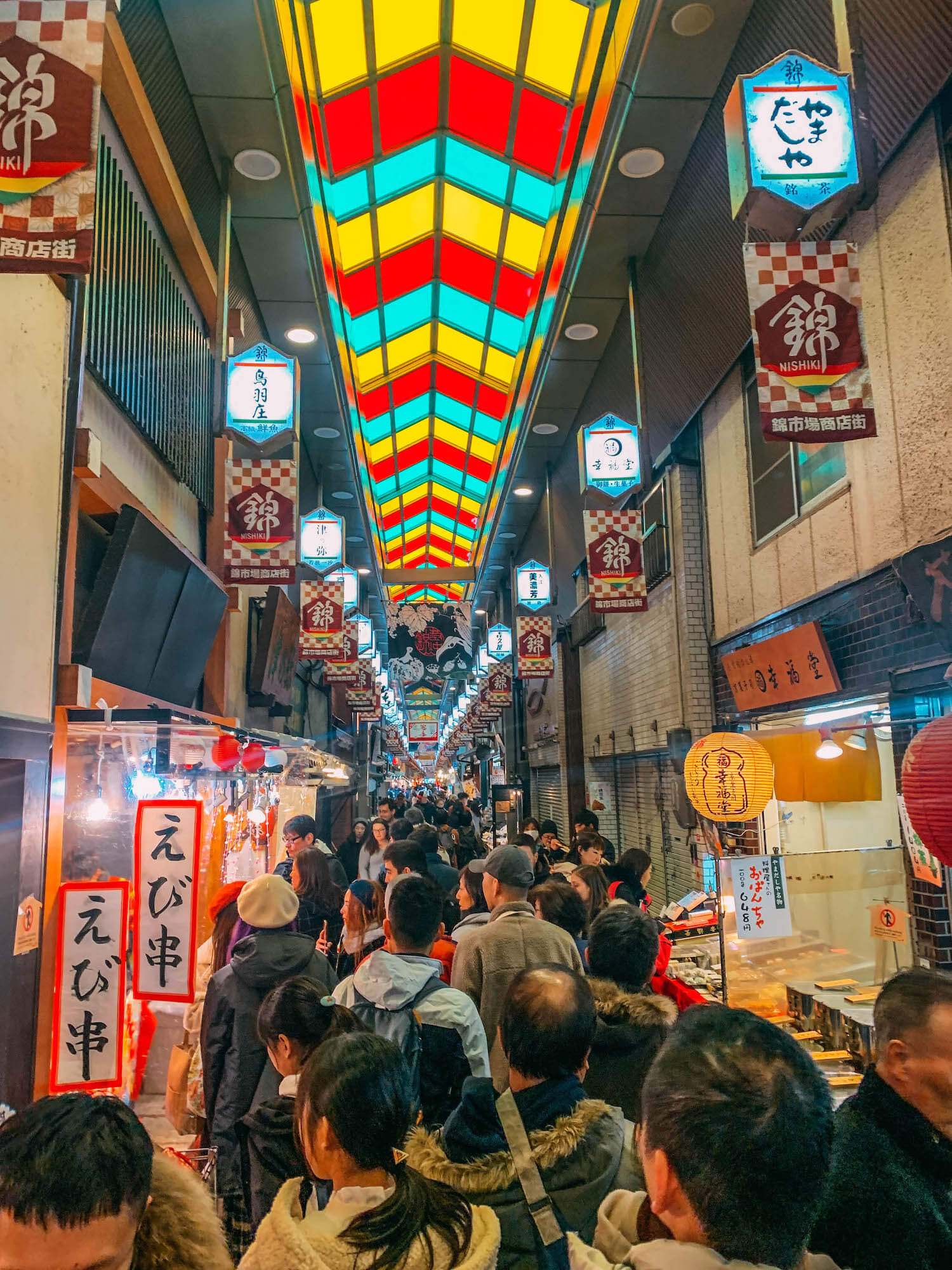
So after you’ve visited the Bamboo Forest, Nonomiya Jinja Shrine, the Kimono Forest, and taken a walk down Pontocho Alley, you will probably be ready for a bite to eat. I recommend walking over to Nishiki Market for an opportunity to sample some of the local flavors!
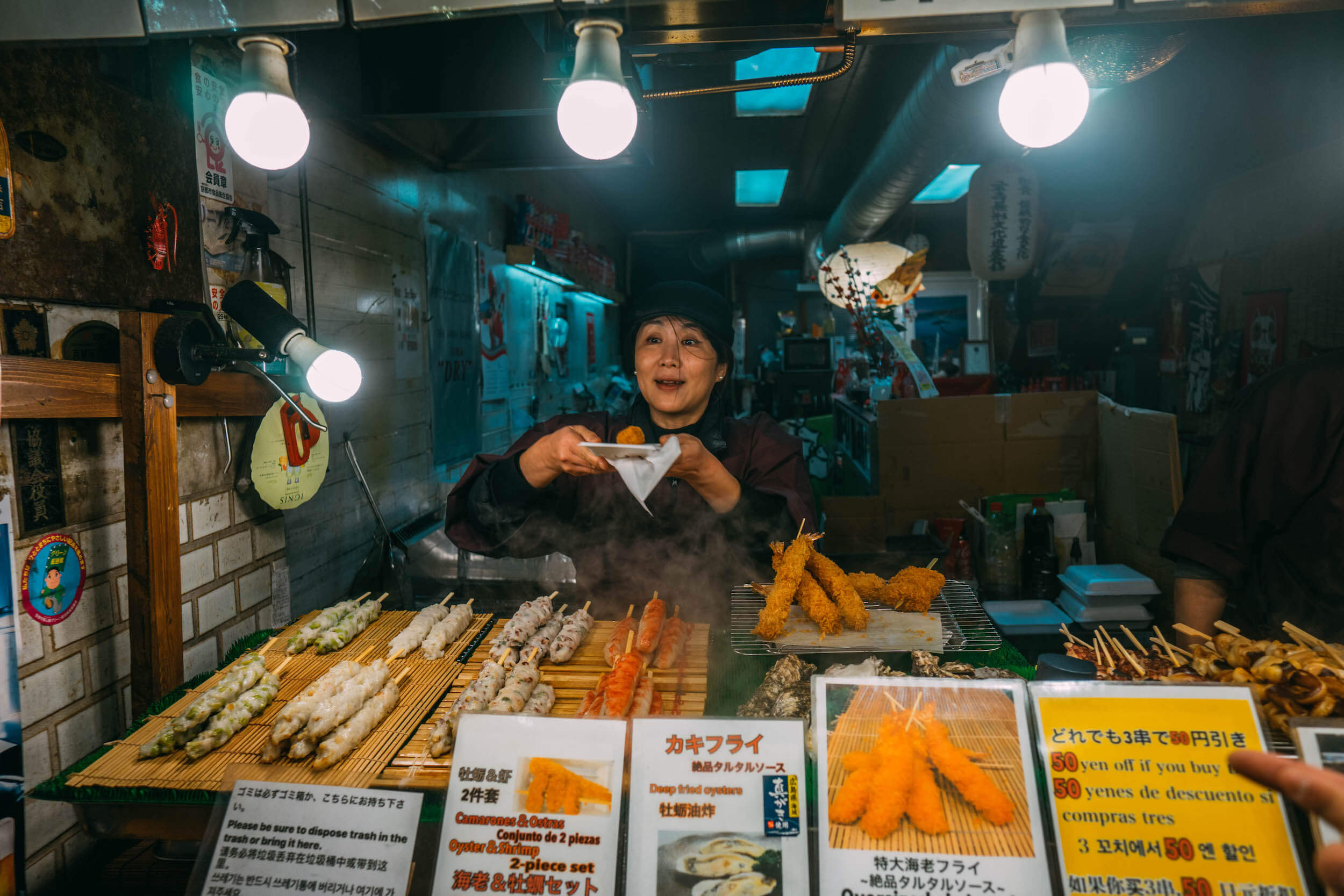
Here you’ll find everything from tempura, to gyoza, fresh seafood, and everything in between. Similar to how Kuromon Ichiba Market is the kitchen of Osaka, Nishiki Market is the kitchen of Kyoto.
But don’t get too full, because I’ve got a lunch spot and a dessert for you next!
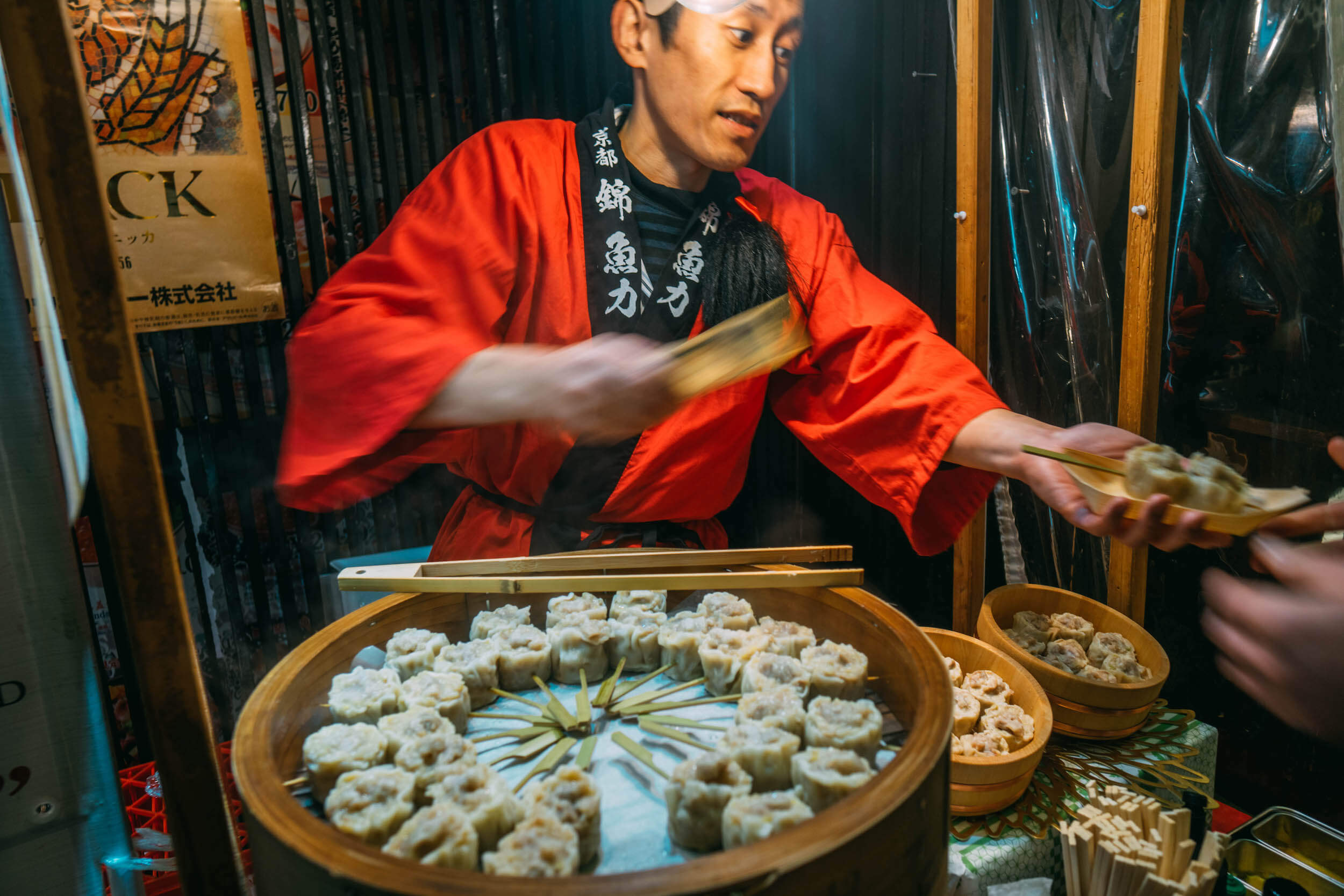
6. Sit down for some incredible Udon at Omen Udon
Omen Udon is up there for some of the best udon we had in Japan (and there were many bowls of udon consumed…) We both ordered the lunch set that came with tempura and we were not disappointed! Try asking if you can sit upstairs – there’s a cozy dining area up there to enjoy your bowl of noodles.
7. Enjoy some post-lunch matcha tiramisu at Maccha House
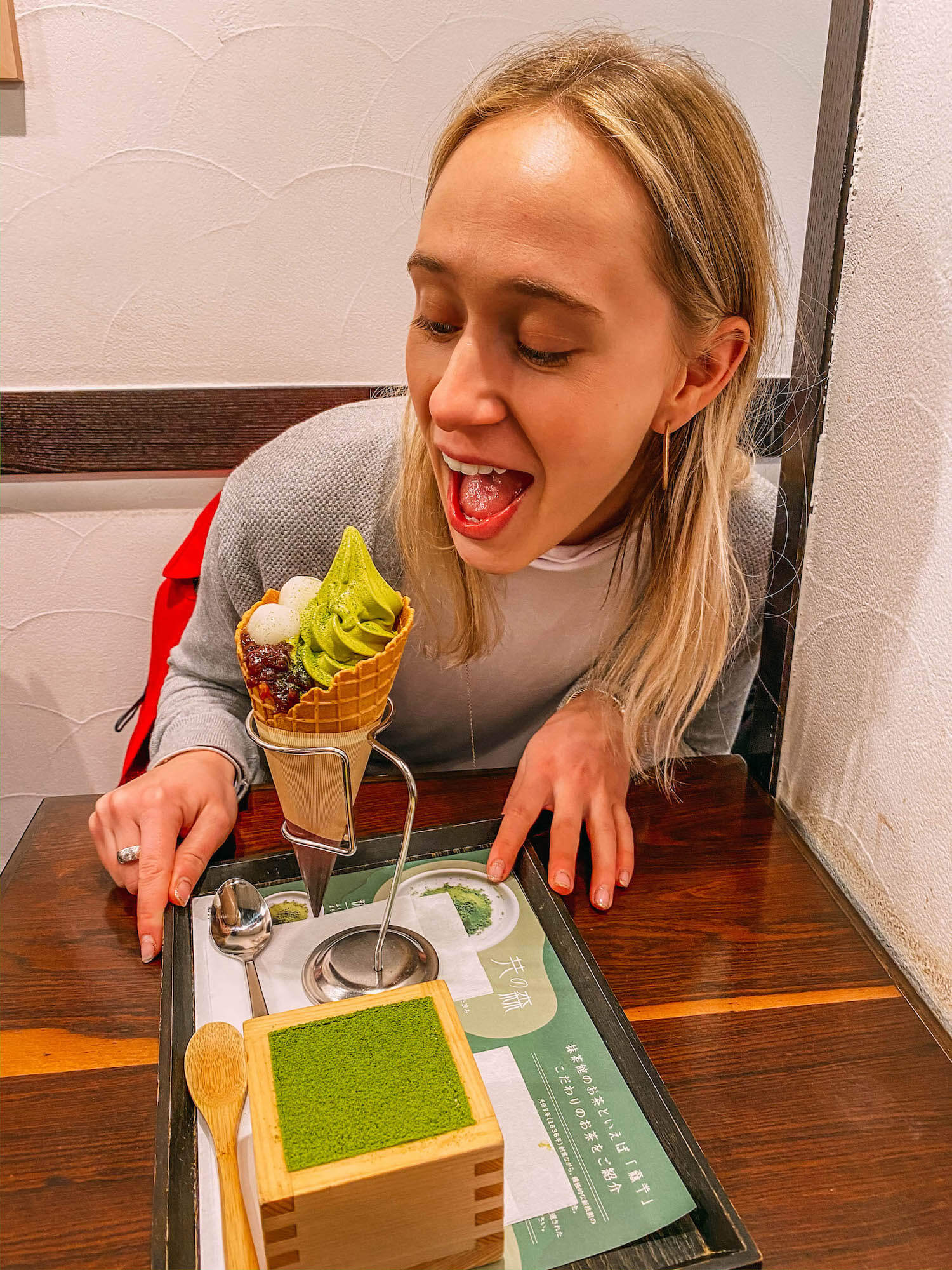
At this point you may be saying, Lauren, really?! More food?! And to that, I say, yes, more food!!! When in Japan, eat everything you possibly can. Trust me, you will not regret it.
So after you enjoy your bowl of udon, make your way down the street to Maccha House, a famous dessert spot for their inventive matcha desserts. And if you’re feeling too full, don’t worry, you’ll have plenty of time to digest as you will most certainly need to wait in line! This place is EXTREMELY popular and usually has a line out the door. We waited for over 3o minutes to get a seat inside the restaurant (they do not allow takeout.)
We ordered the famous matcha tiramisu and the matcha ice cream cone. My only regret is that we didn’t get 2 matcha tiramisus! The moral of this story is that if you see a line, I really do recommend waiting in order to try the matcha tiramisu – it is so worth the wait!
8. Stroll down Hanamikoji street in the historic Gion District
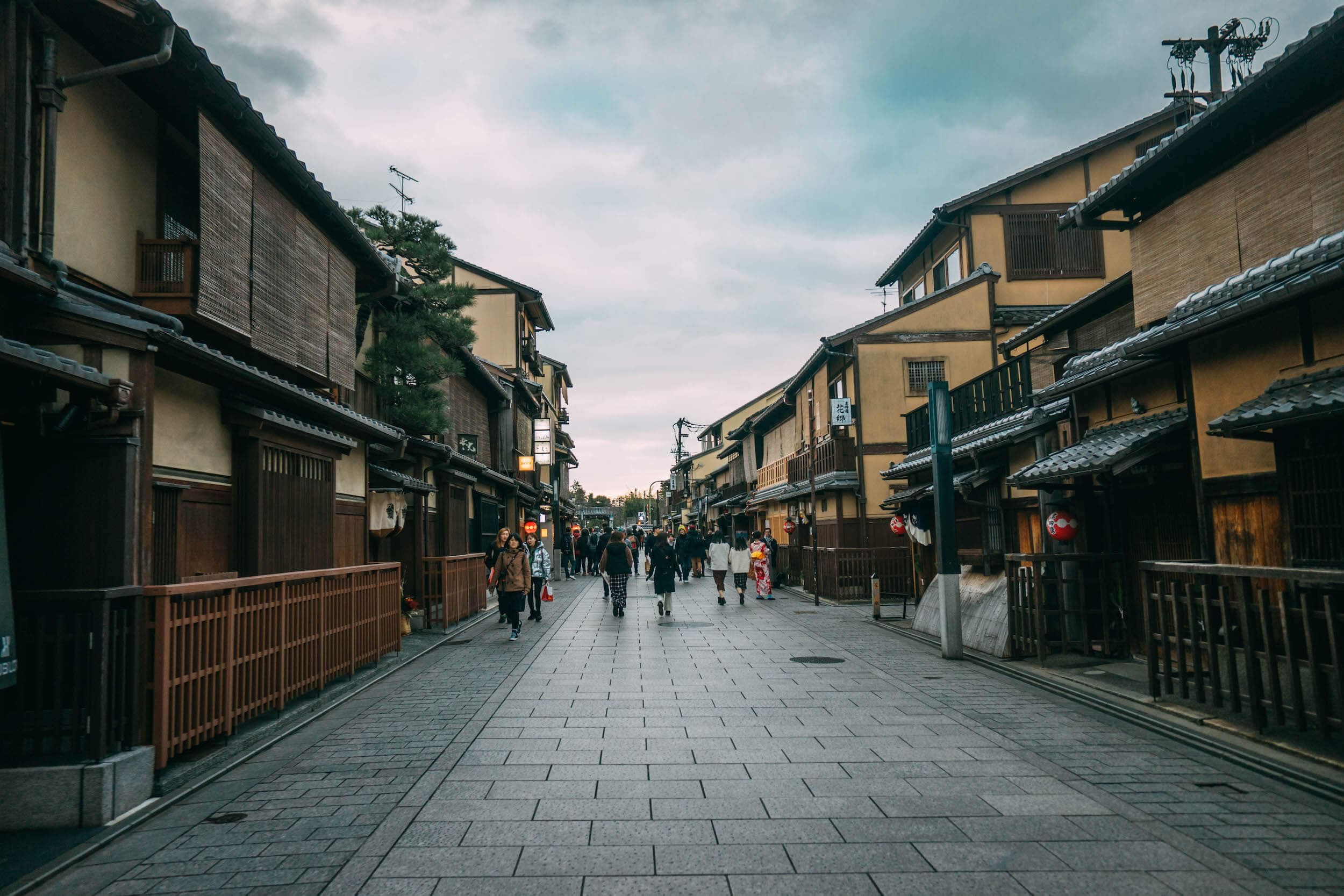
Time to walk off all the food you just ate… Head across the Shijo-Ohashi-Bridge towards Hanamikoji Street. This street is located in the historic Gion district which is known for its traditional wooden buildings, kimono shops, restaurants and again, if you’re lucky, a geisha spotting!
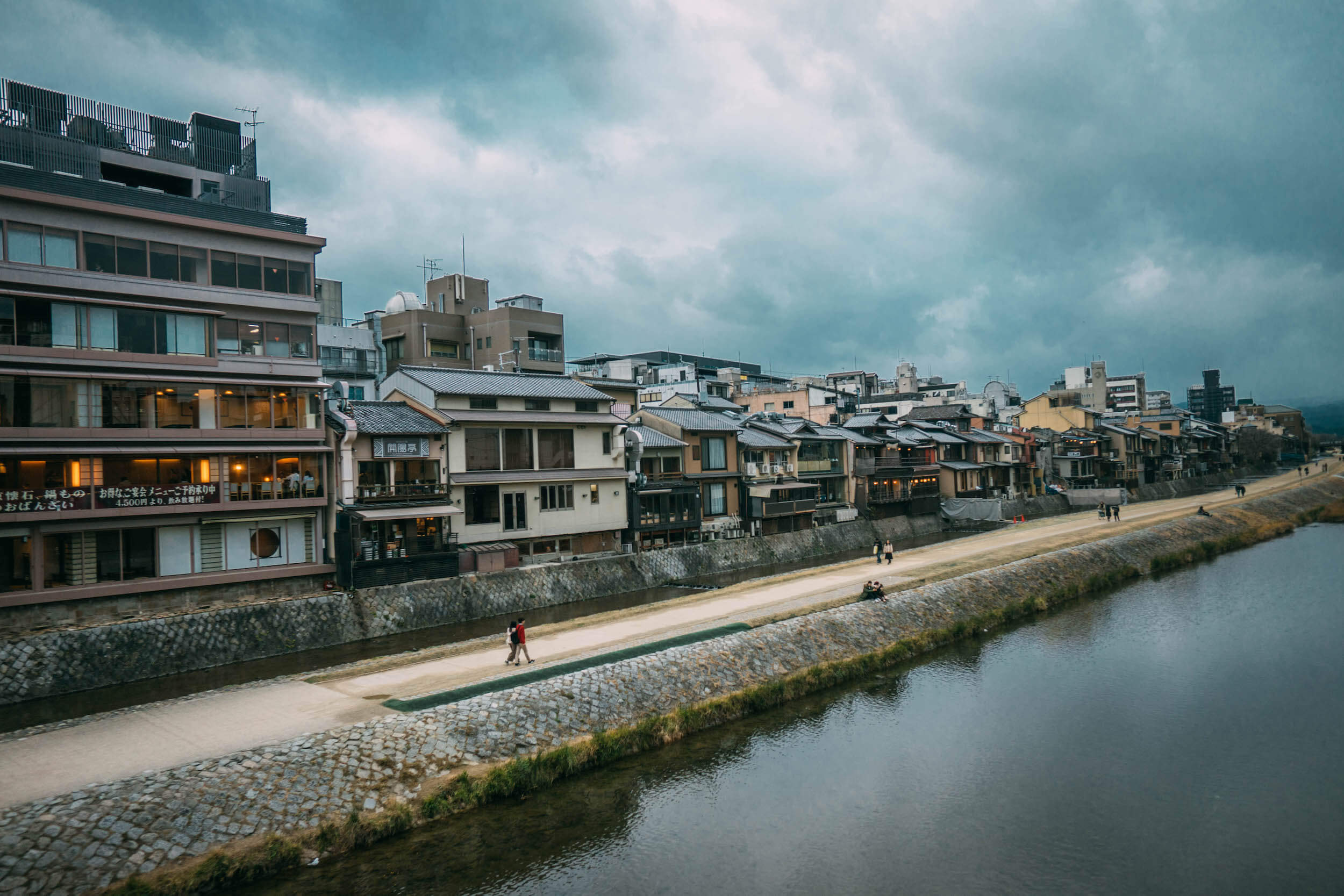
Take your time strolling along the river and taking in the beautiful atmosphere of this traditional city
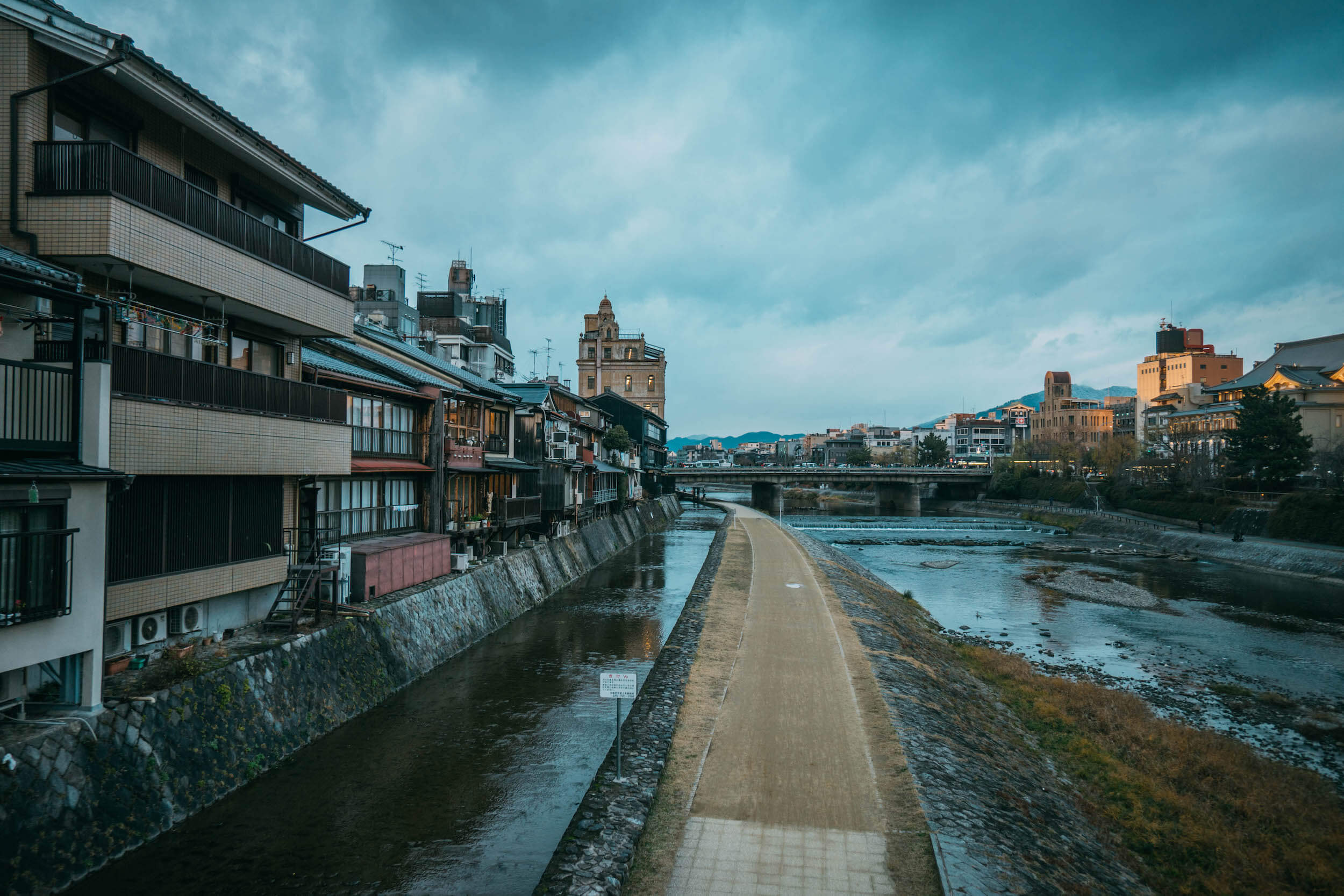
9. Go back to your hotel for a rest
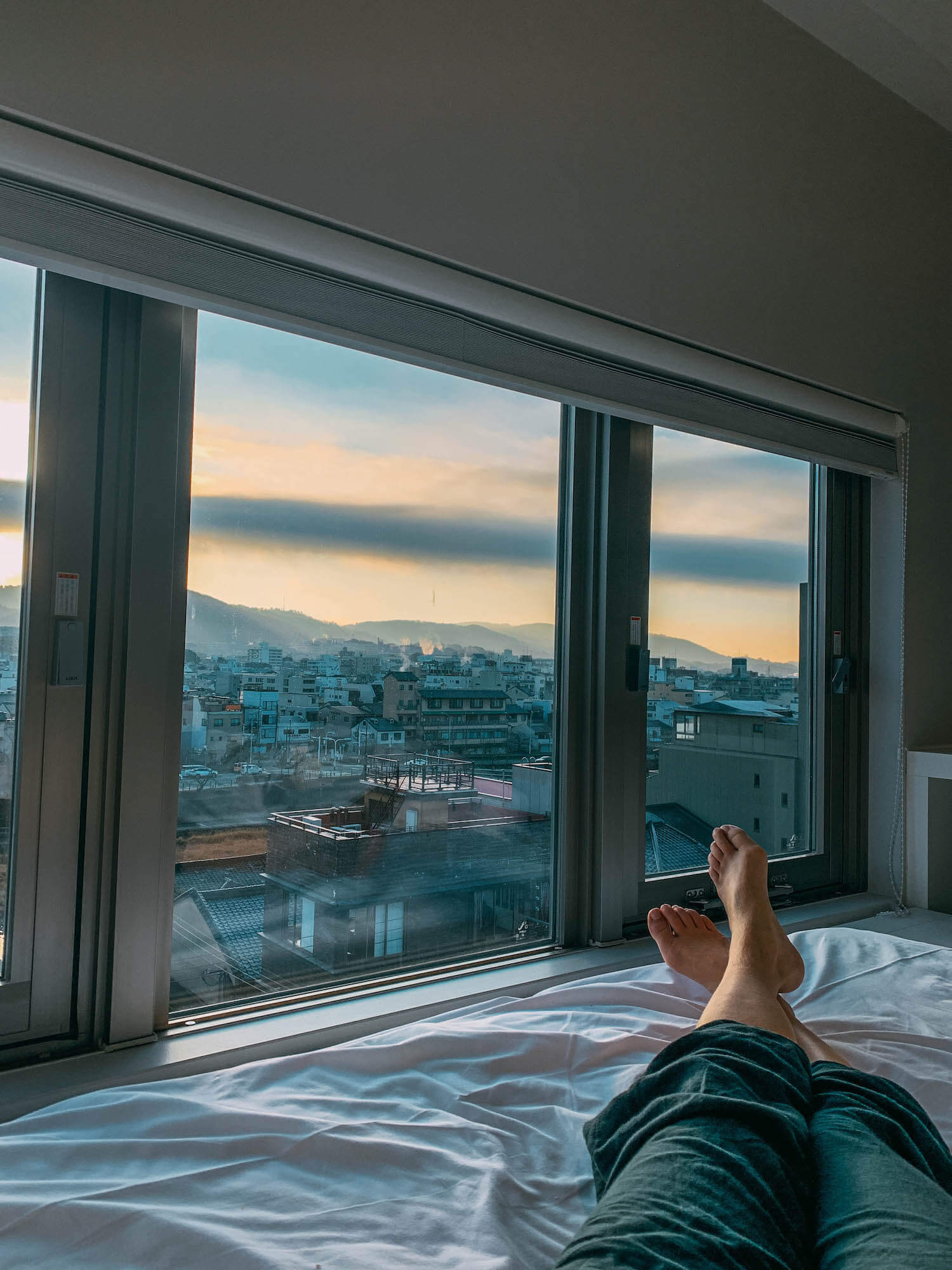
After an activity-filled day, I recommend heading back to your hotel for a rest before going out for the evening. We stayed at BnA Alter Museum Hotel and loved it for the perfect location, interesting artwork, and unique accommodations. Keep reading this post or scroll down to read more about my stay with BnA Alter Museum! (Ps. you can find their boutique art hotels on Instagram here.)
10. Treat yourself to dinner at Morimoto
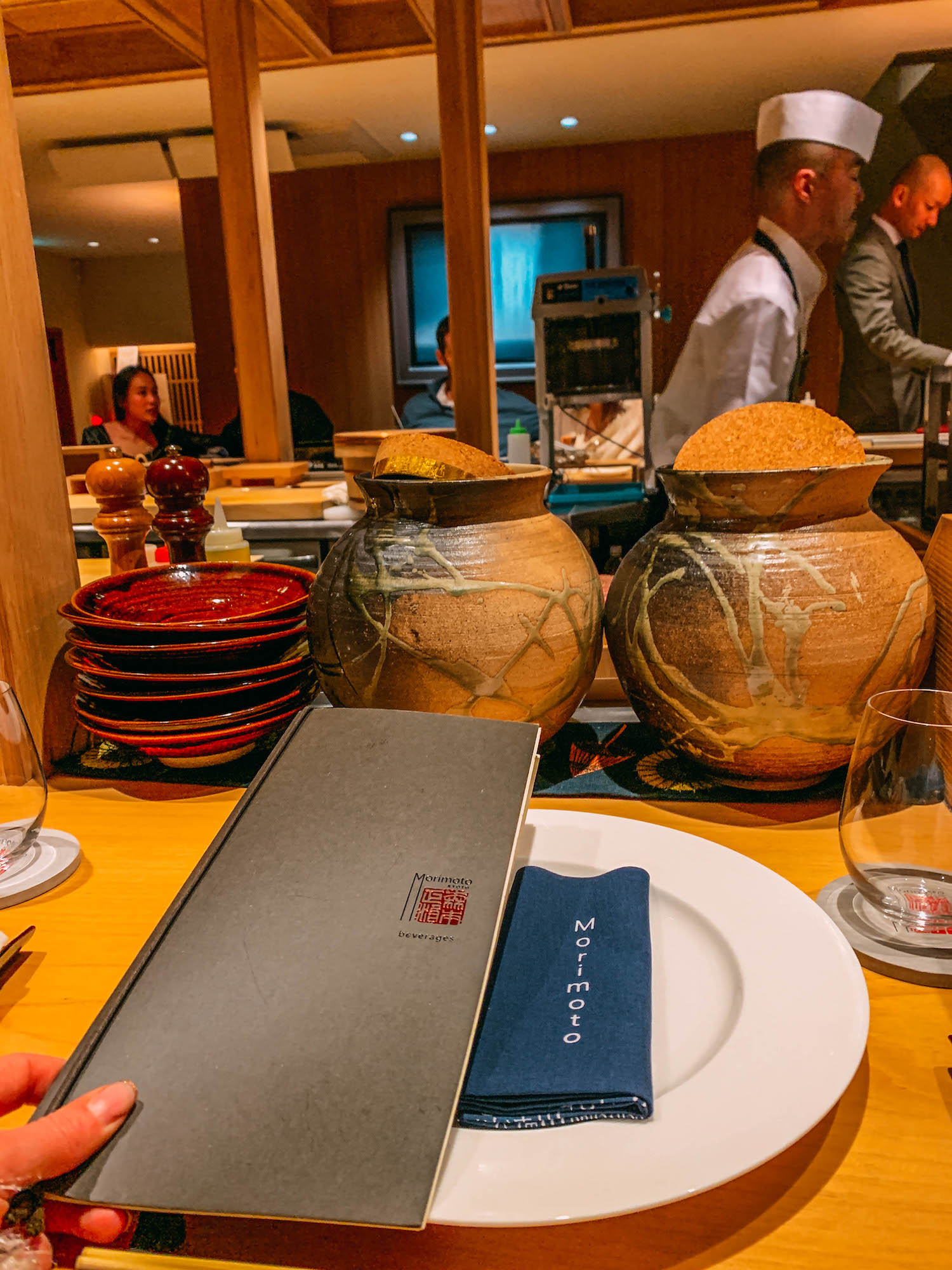
Located between Pontocho Alley and the Kamogawa River, this special dining spot is the perfect place to sample one-of-a-kind selection of dishes featuring premium Omi beef and other choice wagyu prepared in Chef Morimoto’s signature style.
Morimoto was definitely a bit pricey but the quality offered is unmatched and you can even watch the chefs prepare everything right out in the open. We had the “Today’s 3 Kinds” Wagyu Japanese BBQ, Spicy Salmon Roll, and a house salad – and even the salad blew us away!
11. End your night with a self-led Japanese whiskey tour!
Can you really go to Japan and not sample Japanese whiskey?! We LOVE whiskey so this was a no-brainer for us, but even if you are not a whiskey fan, it’s worth a try as Japanese whiskey is world-renowned! We took it upon ourselves to create our own whiskey-bar crawl and it was a blast to say the least. Check out my top recommendations below:
Hello Dolly
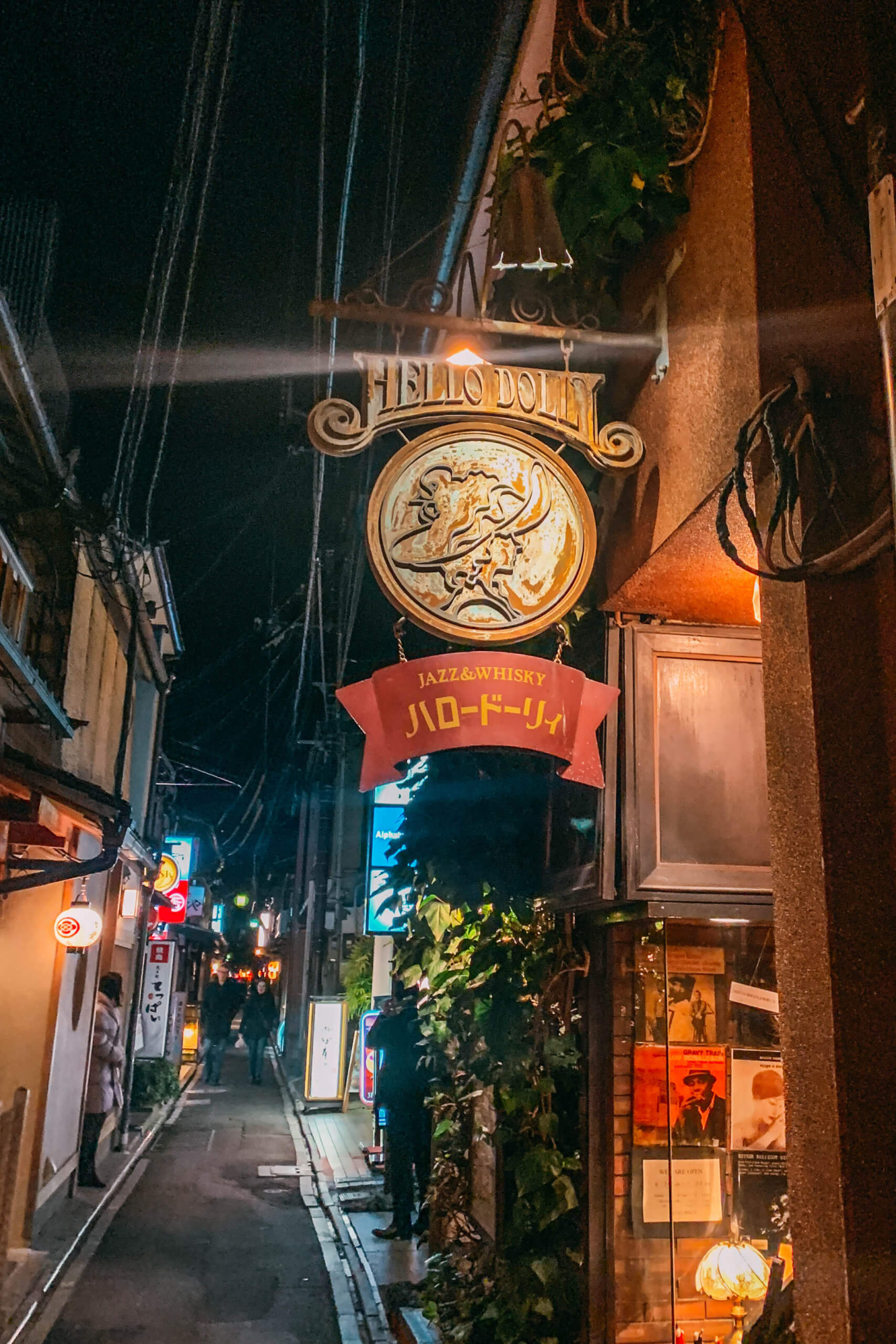
They had me at “Jazz & Whisky.” For a cool roarin’ 20’s vibe and jazz on vinyl (or a live jazz band if you’re lucky!) Hello Dolly is definitely the spot to visit. Think lost of velvet, fringe-lamps, and of course a great selection of whiskey.
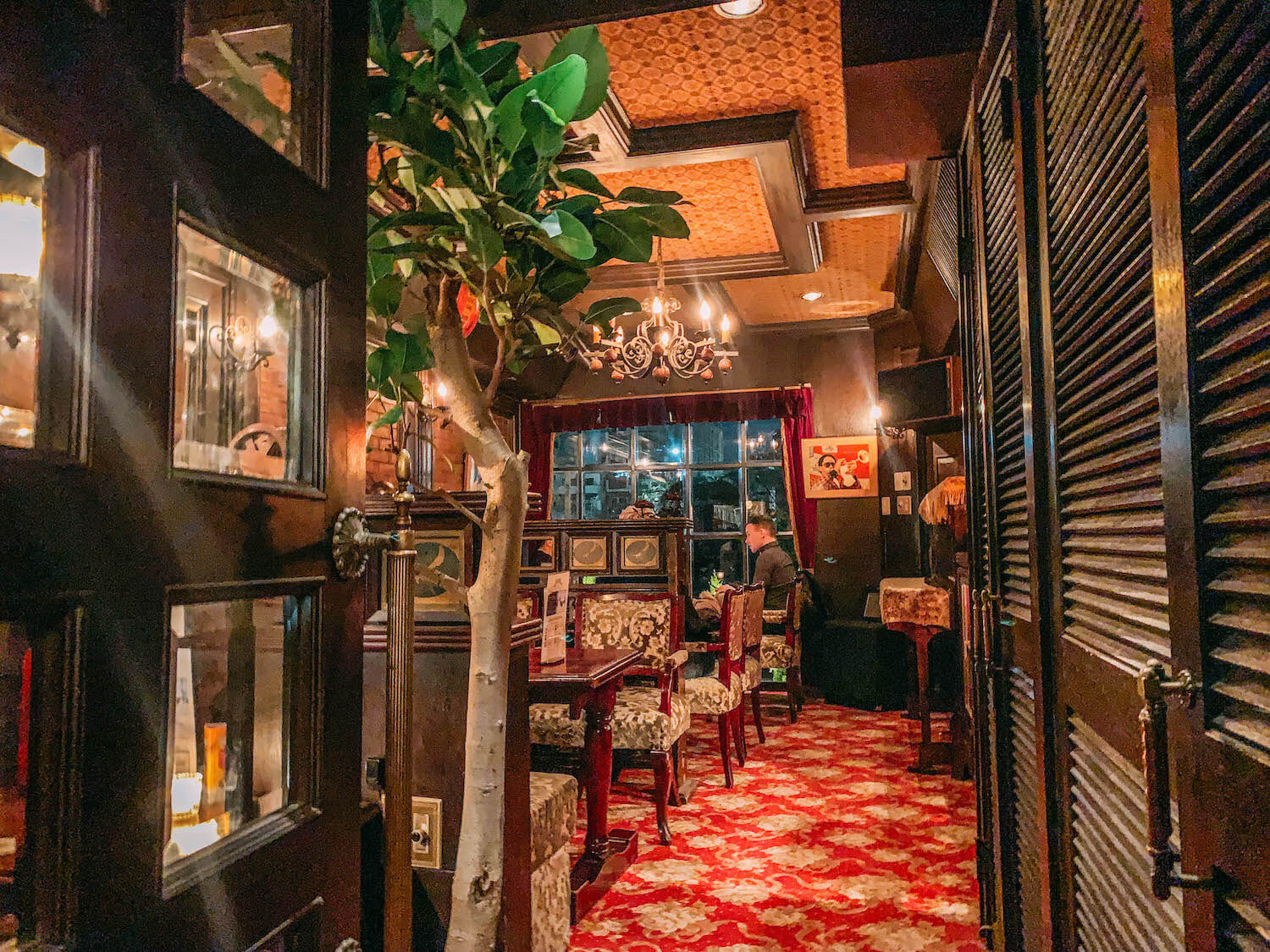
Bar K6
This high-class whiskey bar had the best and most extensive Japanese Whiskey selection – by far. If you’re a real Japanese whiskey fan then you’ll definitely want to make your way to Bar K6. Make sure to dress upscale, as this is definitely a fancier establishment. The waiters wear black suits and most of the patrons were in suits and kimono.
Untitled – the BnA Alter Museum hotel bar
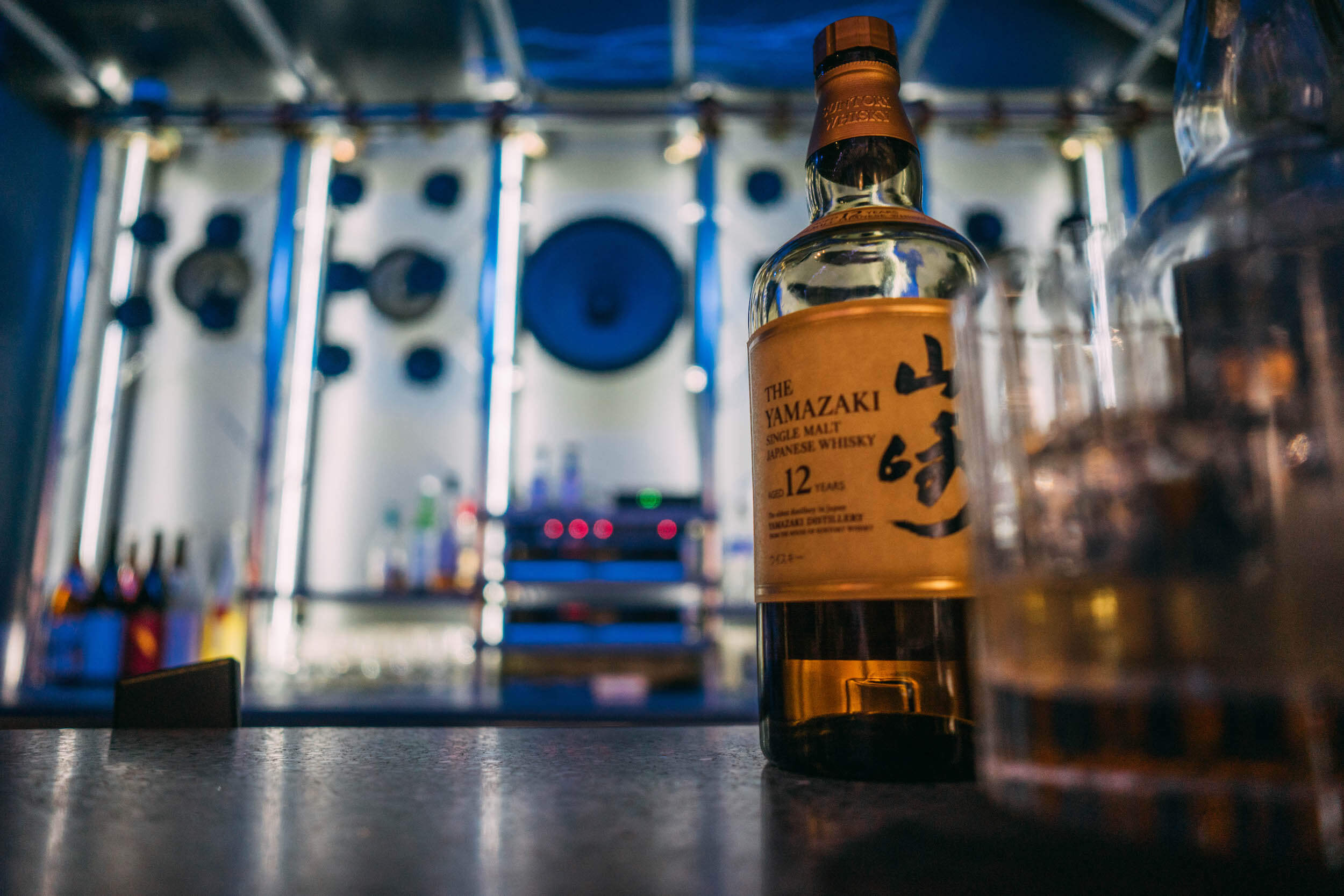
For an ultra-modern vibe, make sure to check out the BnA Alter Museum bar, Untitled. Not only do they often host live Dj’s but it’s located inside an art gallery! They also have a few unique Japanese whiskeys to try and some other Japanese liquor you can sample.
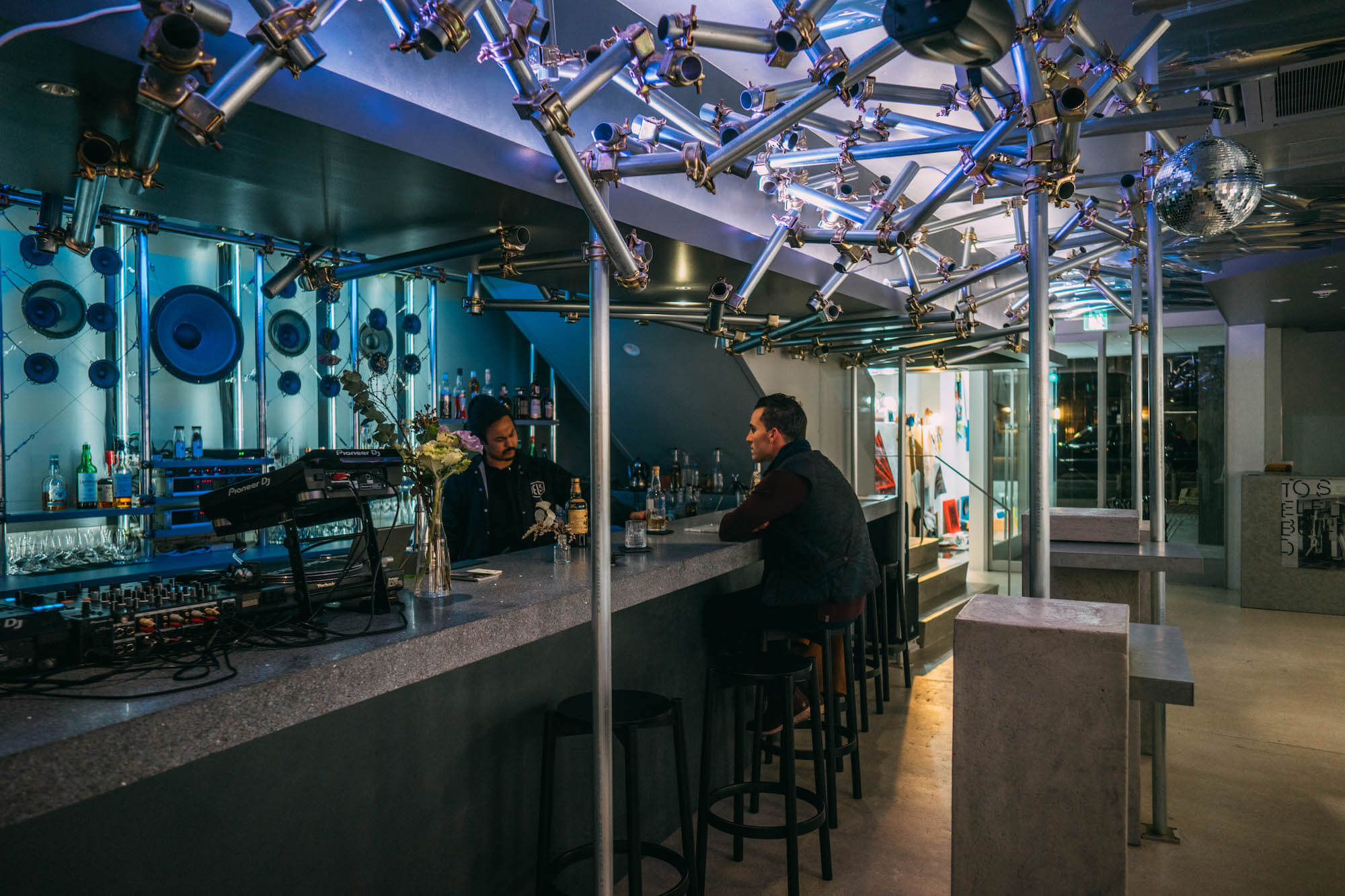
2-Day Itinerary in Kyoto: DAY 2
Highlights: Higashiyama District, Ninenzaka Street, Sanneizaka Street, Kiyomizu Temple, Fushimi Inari Shrine
1. Make your way towards iconic Ninenzaka Street in the Higashiyama District
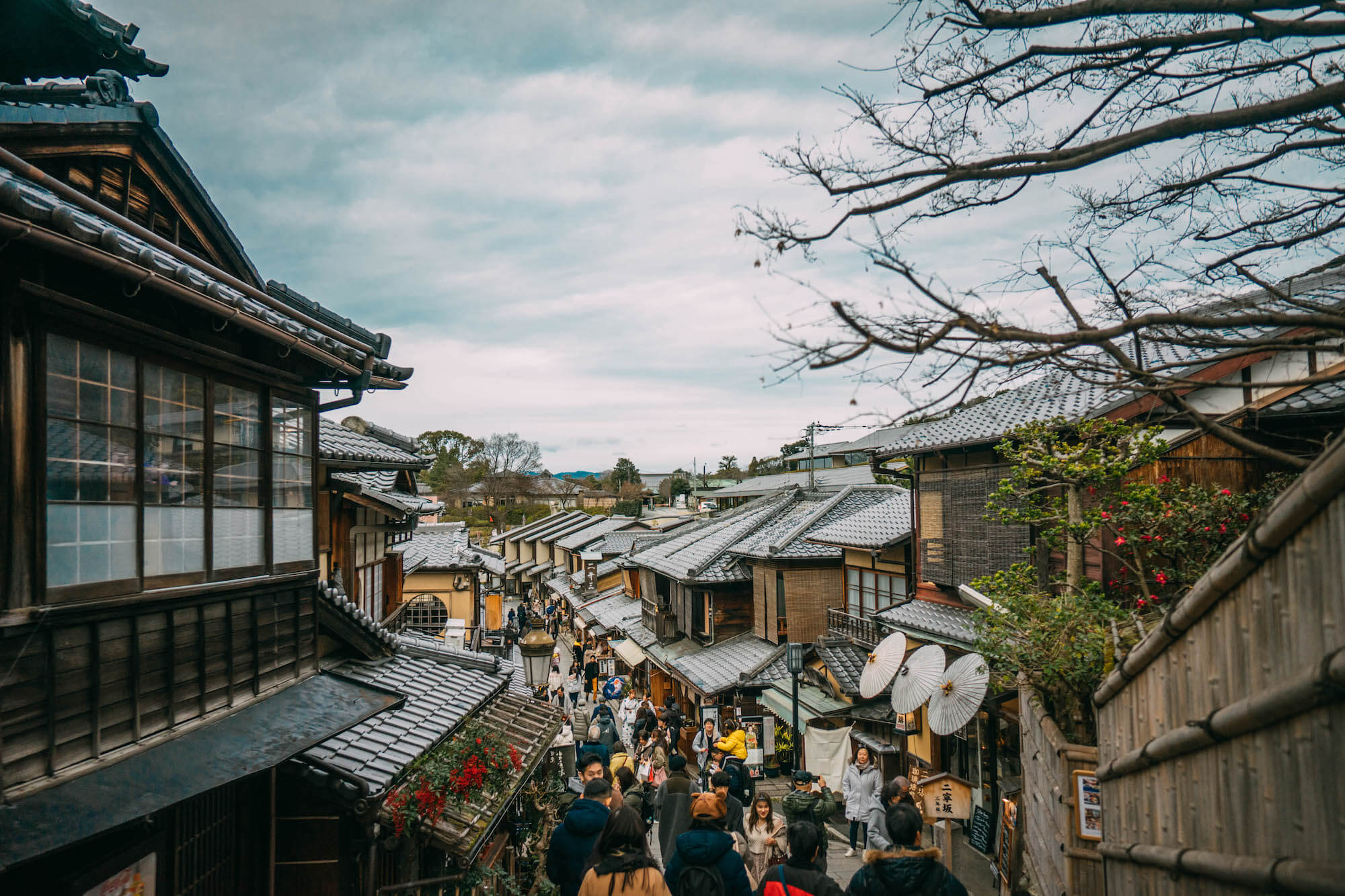
When picturing Kyoto, Ninenzaka Street is most likely the street that you are picturing!
This iconic street is located in the Higashiyama District which is a network of narrow lanes lined with tea houses and Japanese pottery stores, and preserves the traditional style wood-buildings from centuries ago.
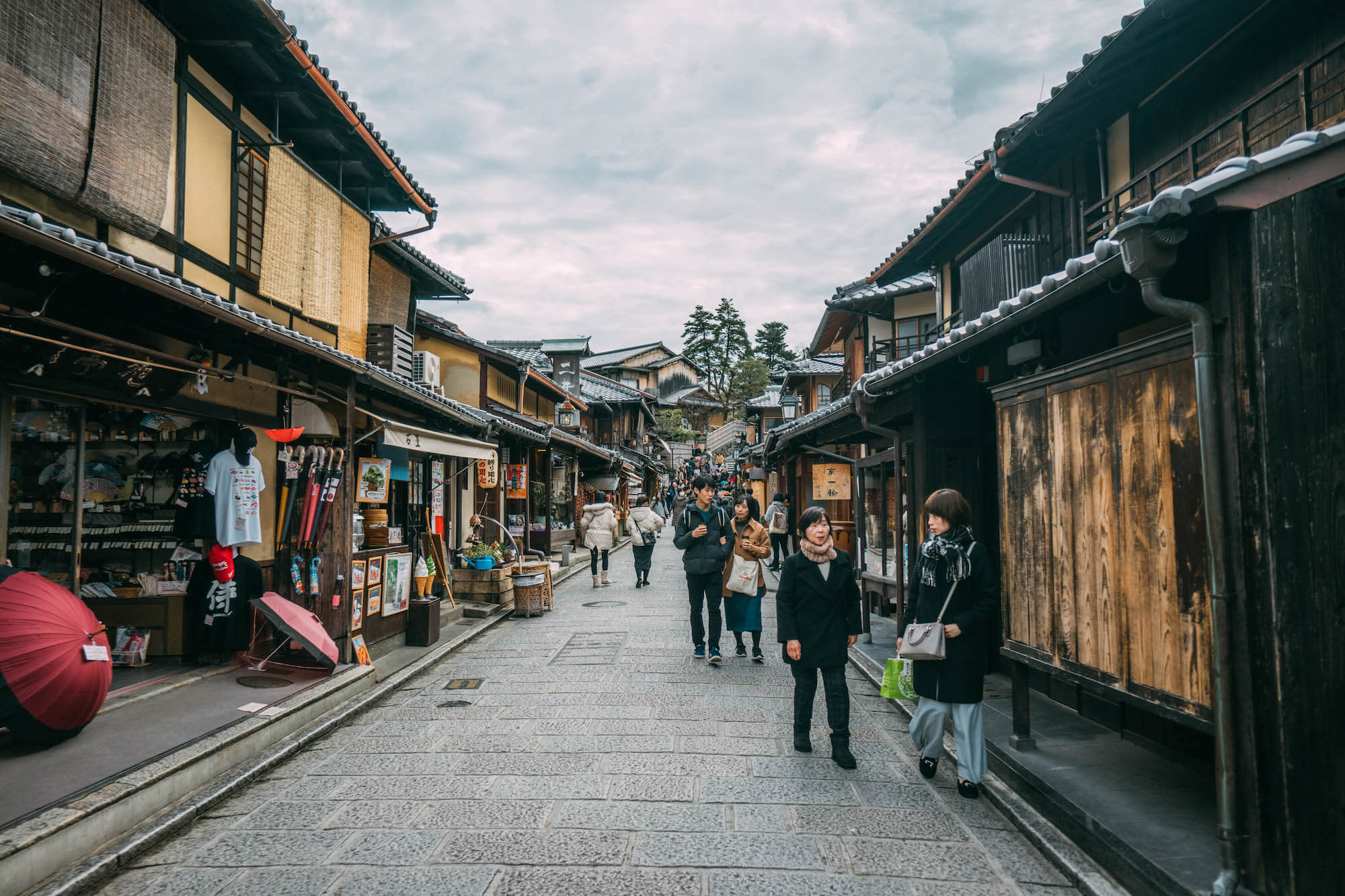
2. Stop at Starbucks Coffee Kyoto Ninenzaka Yasaka Chaya & start your day with a coffee and a treat
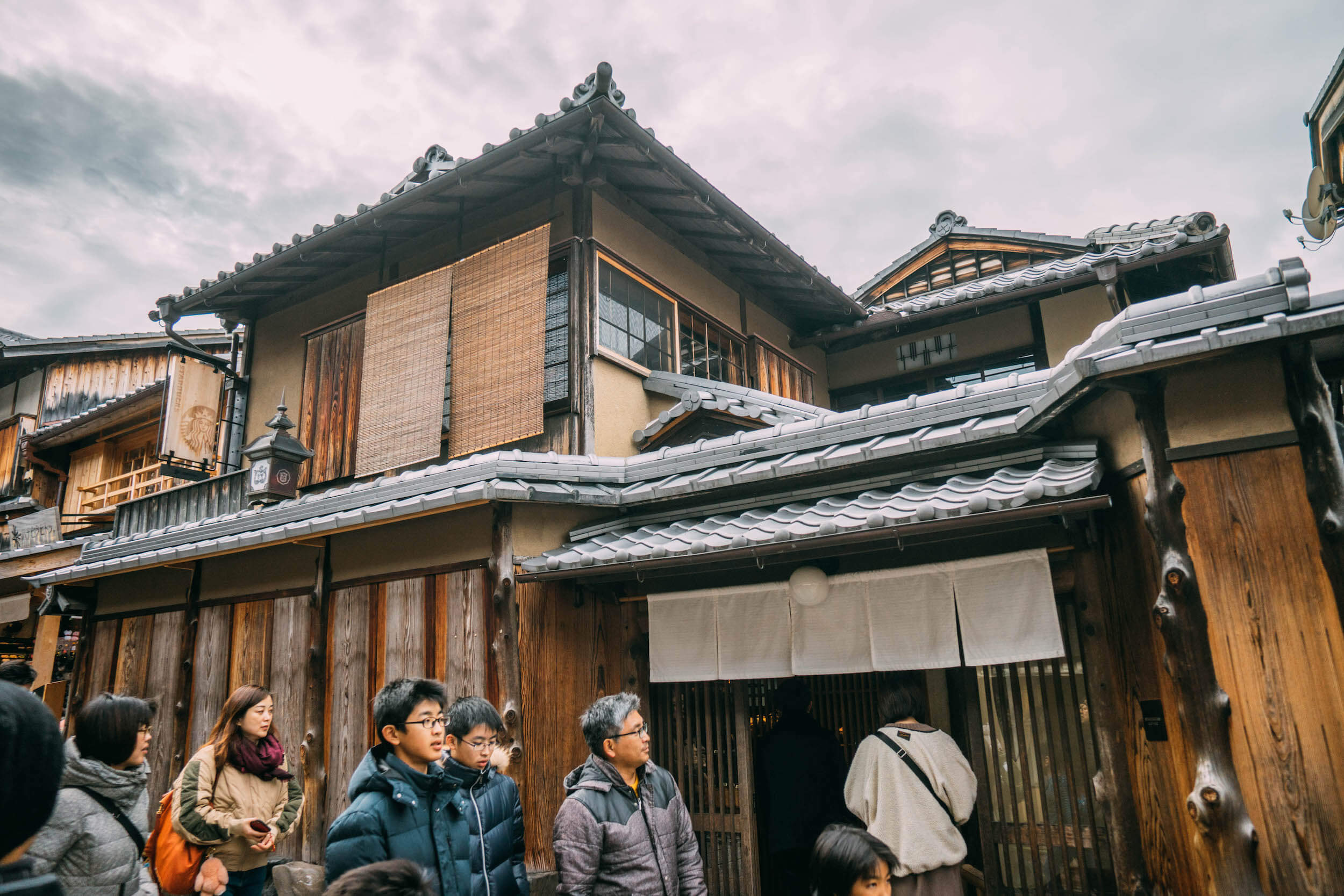
Located on Ninenzaka Street you will find a Starbucks, but only if you really look for it! This is no ordinary Starbucks, as it is located in a traditional Japanese tea house, and even preserves that traditional feel inside the cafe as well. Instead of sitting at a cafe table and chairs, you will need to take your shoes off and enjoy your treats while sitting on a pillow on a tatami mat floor!
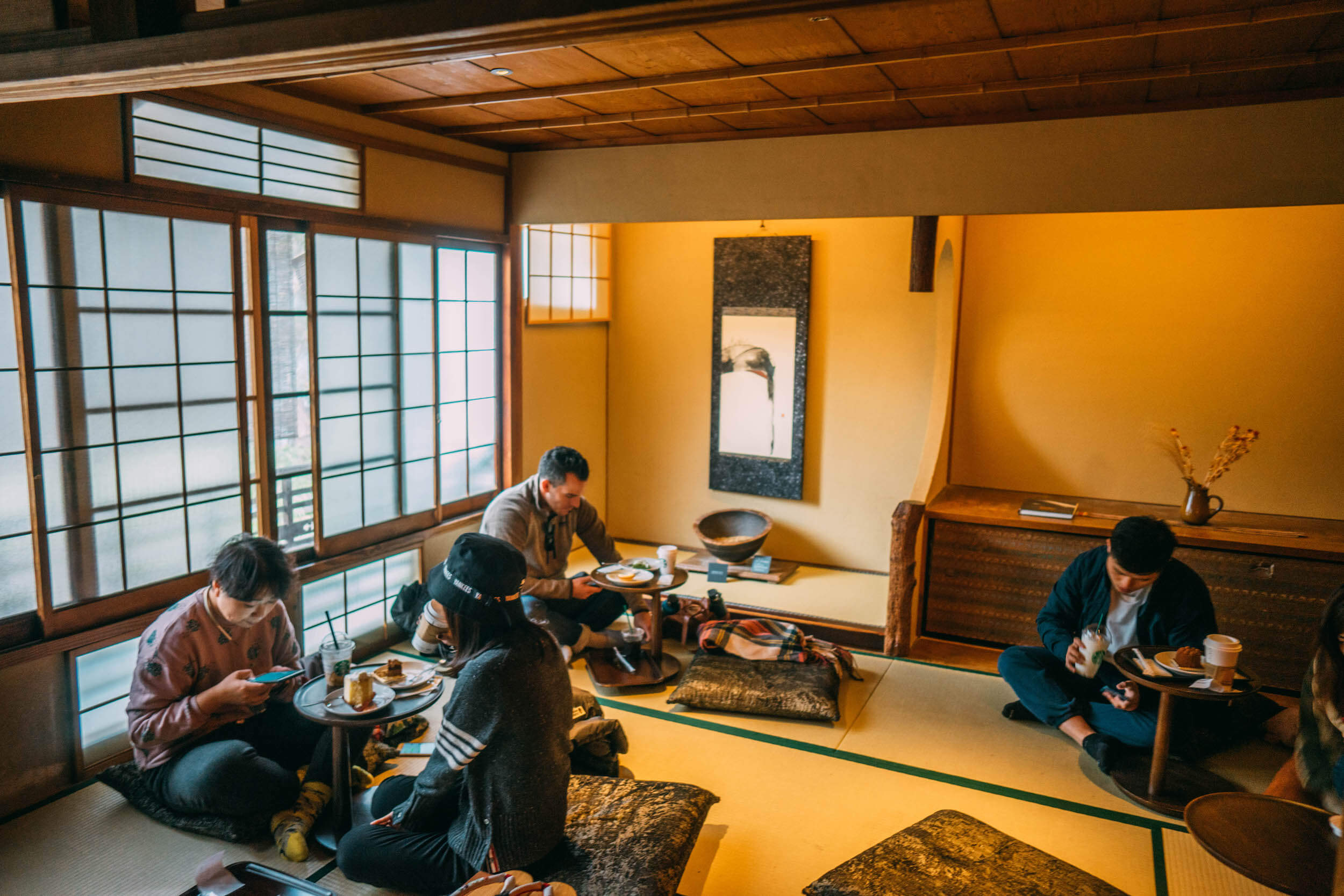
I bet you would have never thought that this as a Starbucks from the outside, would you?! I love how they embraced the traditional Japanese style to create this one-of-a-kind Starbucks.
3. Do some shopping on Sanneizaka Street
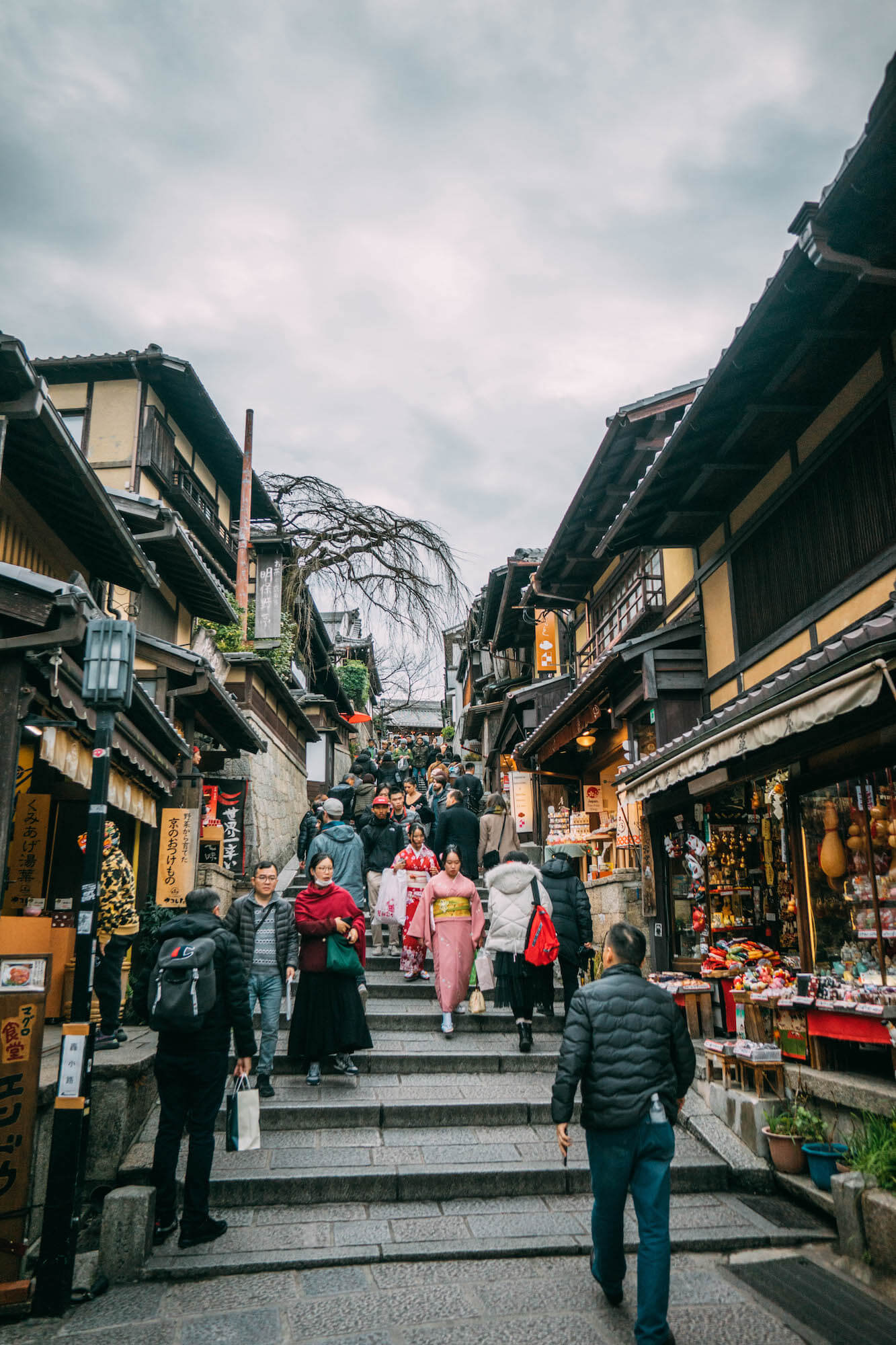
Sanneizaka Street is another narrow alleyway located in the Higashiyama District, which is just about as iconic as Ninenzaka Street! The main difference I found was that Sanneizaka Street seemed to have a lot more trinket and souvenir-type shops which made it a great place to look for gifts.
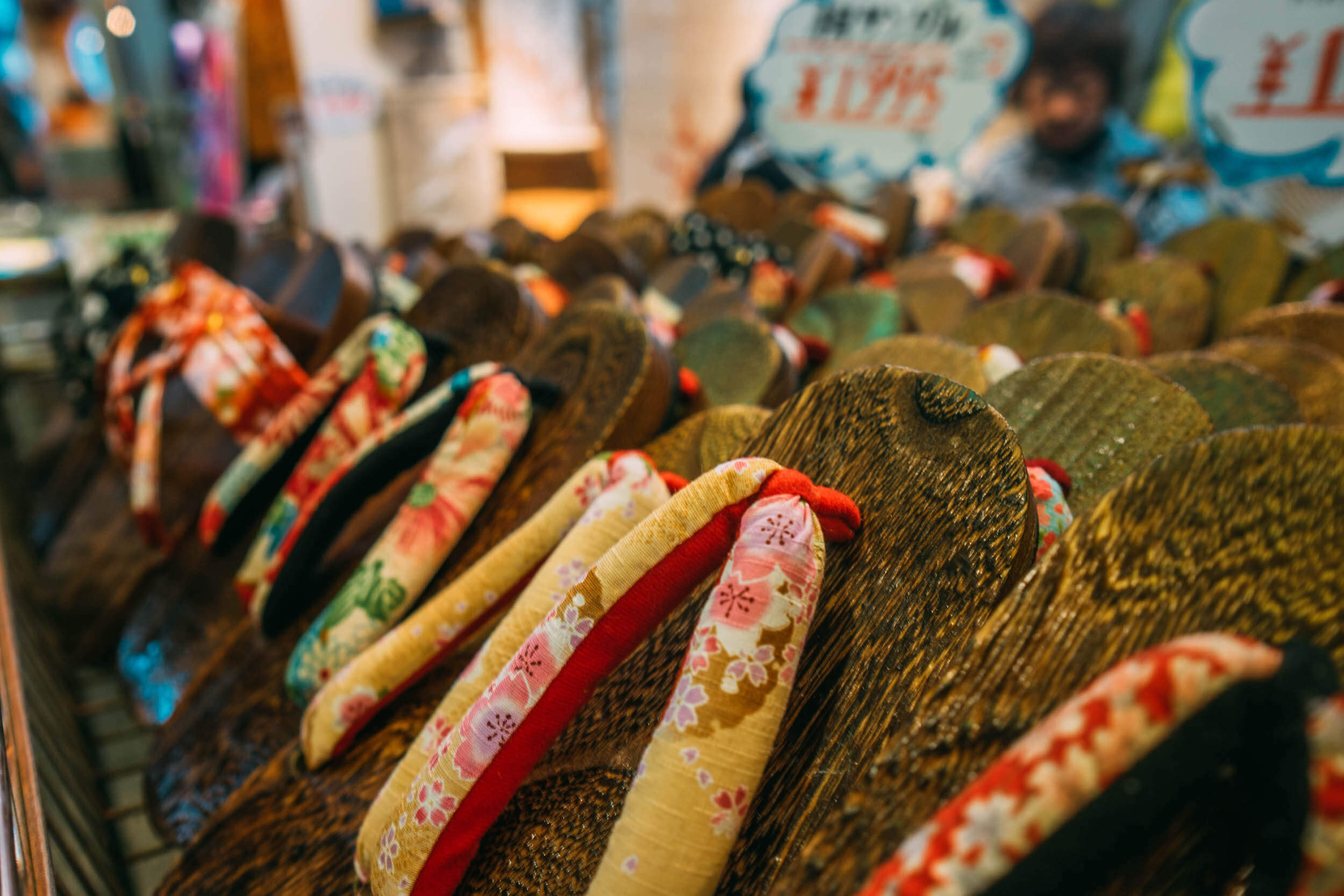
You’ll find everything from Japenese fans, to wooden sandals, coin purses, chopsticks, and my personal favorite – all sorts of cat trinkets!
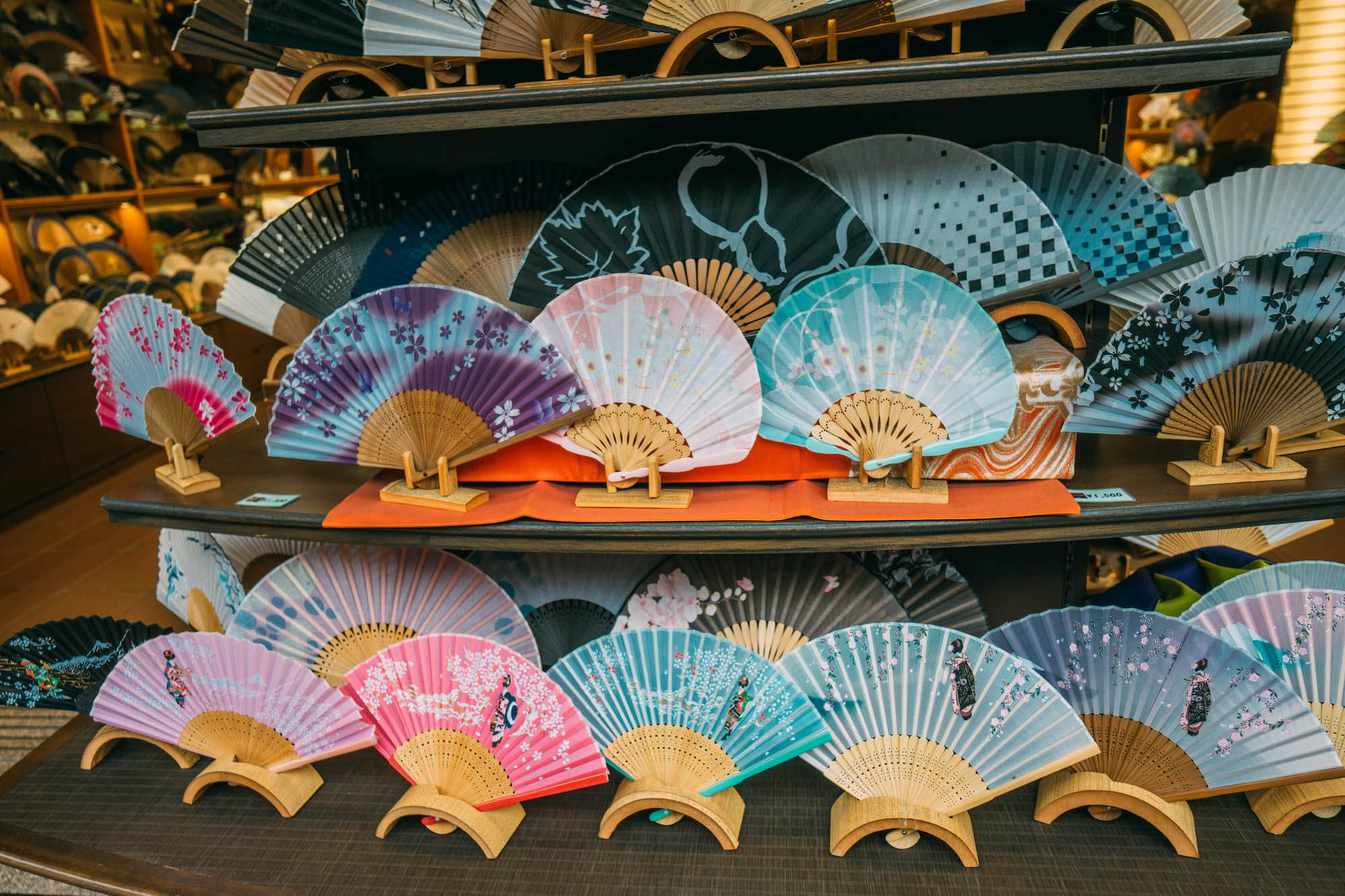
I learned that in Japan, cats are known to bring good luck and that’s why so many restaurants and shops display the Japanese cat figurine “maneki-neko”, also known as the beckoning cat which is a little figure of a cat with its paw in the air. Also, don’t forget that Hello Kitty originated in Japan
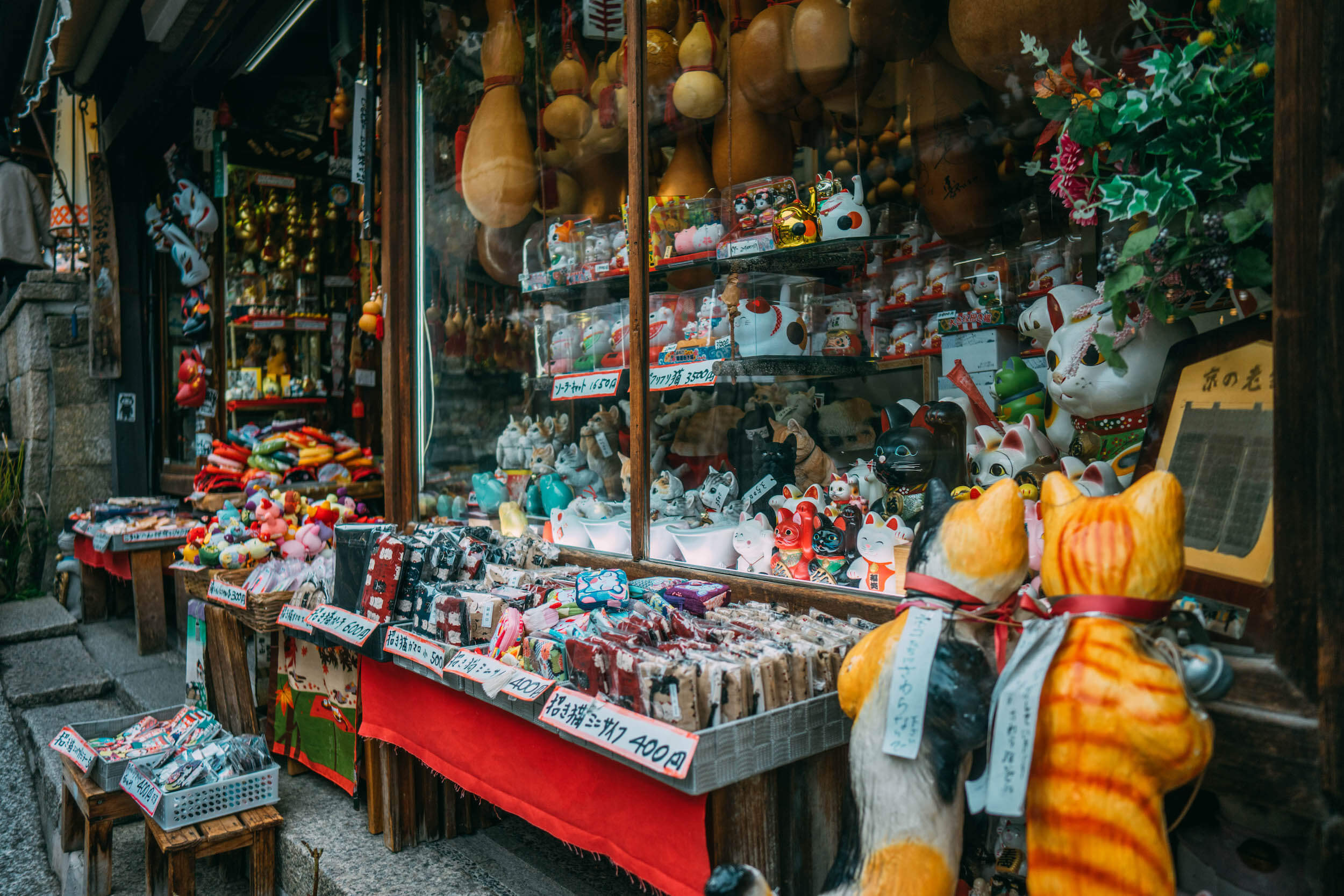
While strolling this bustling pedestrian hillside path, make sure to take your time observing all the little details and admiring the Japanese architecture – it truly is a special place.
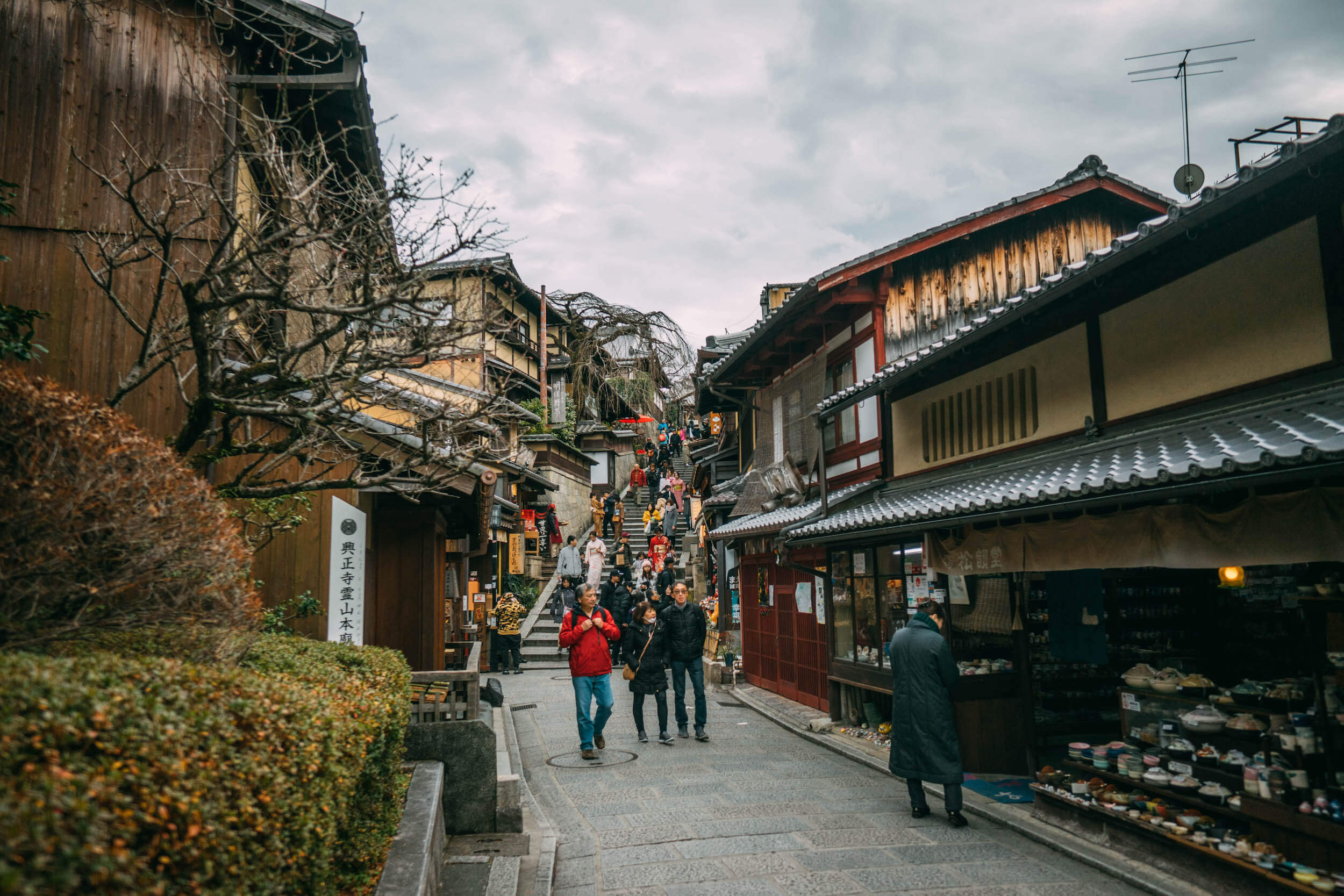
4. Admire the beautiful Kiyomizu Temple grounds
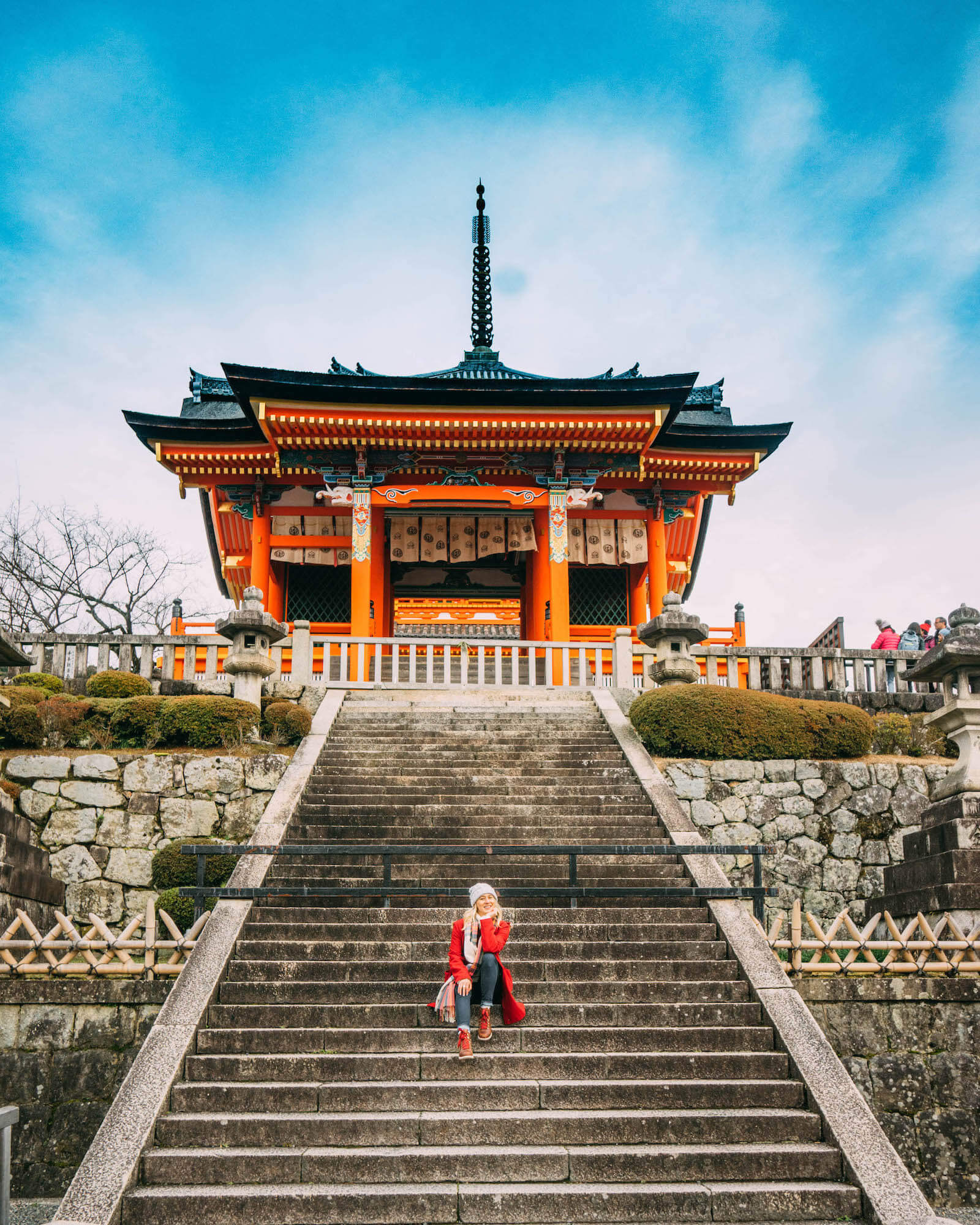
Some of the fun in visiting these grounds are actually in how you must get there – you need to walk up bustling Sanneizaka Street and as you climb the last few stairs, the Kiyomizu Temple grounds emerge before your eyes!
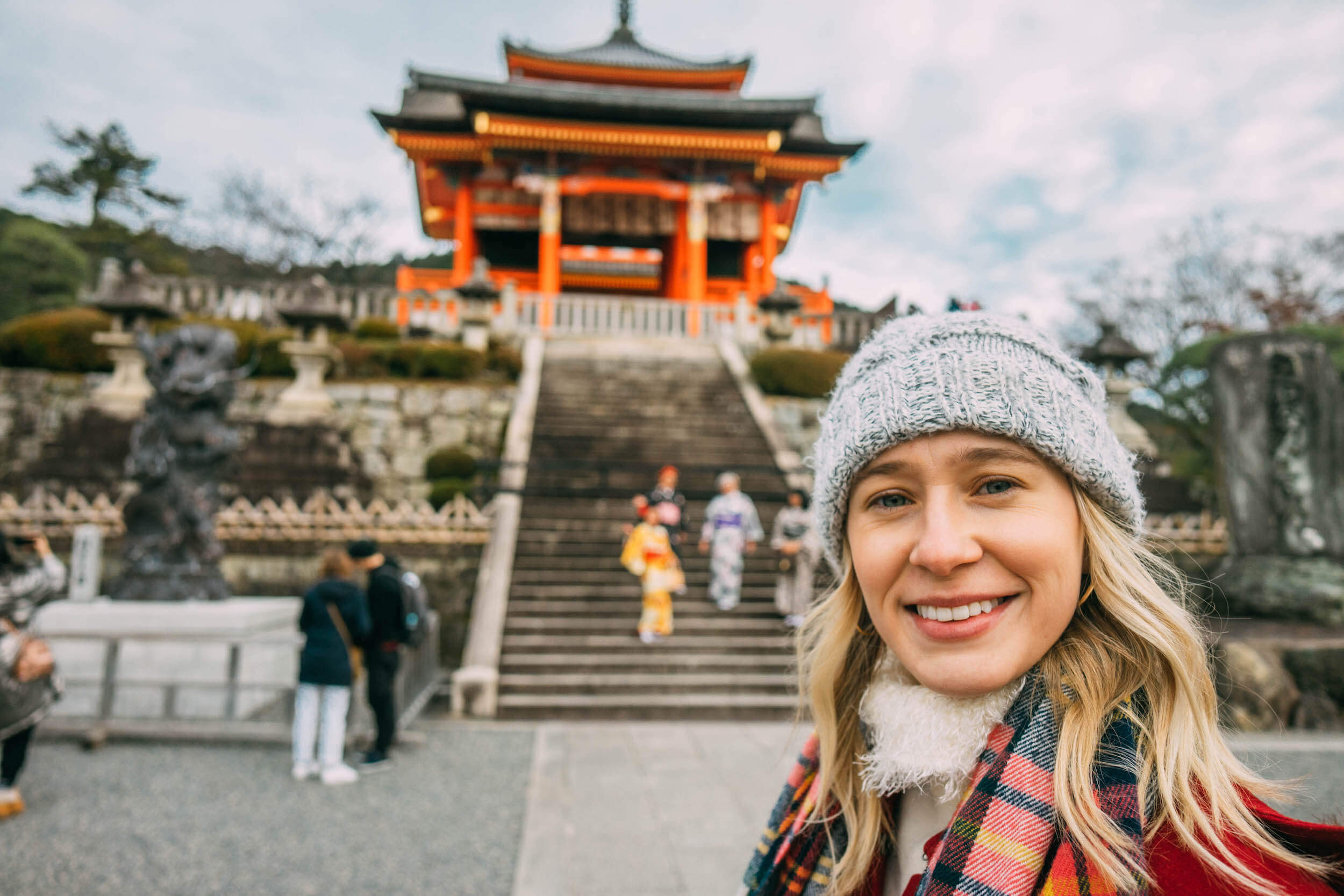
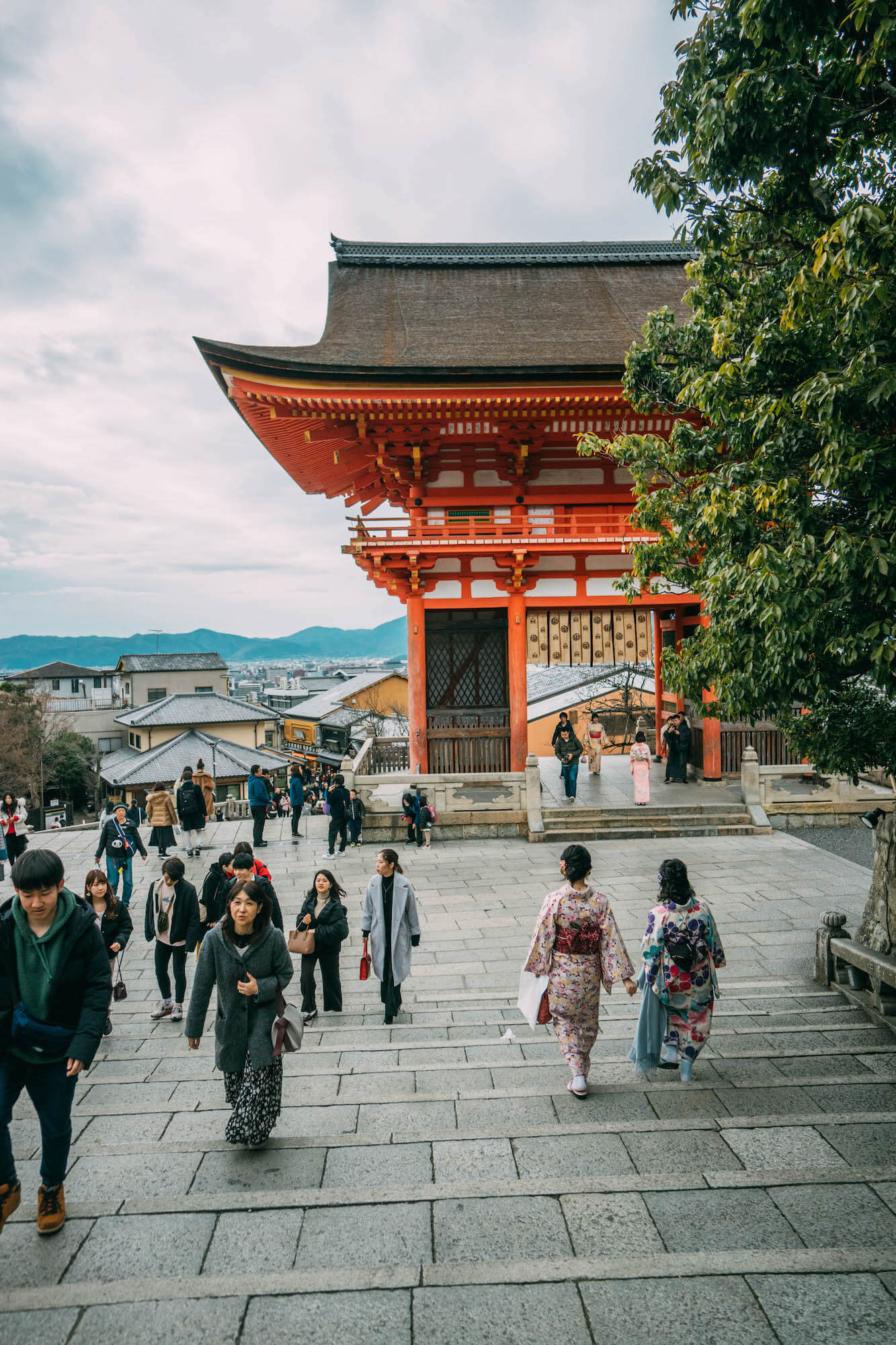
Unfortunately, a lot of the buildings that make up this complex were under construction, including the famous main hall and wooden stage. However, we were still able to see so many of the other beautiful shrines, stages, and pagodas in the area, making it more than worthy of this 2-day itinerary in Kyoto.
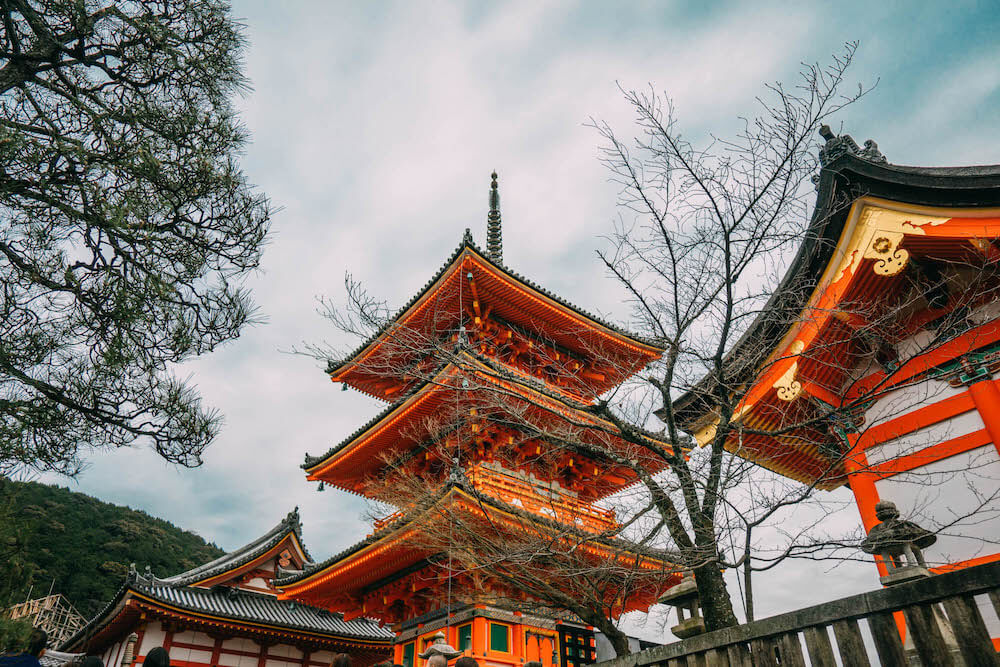
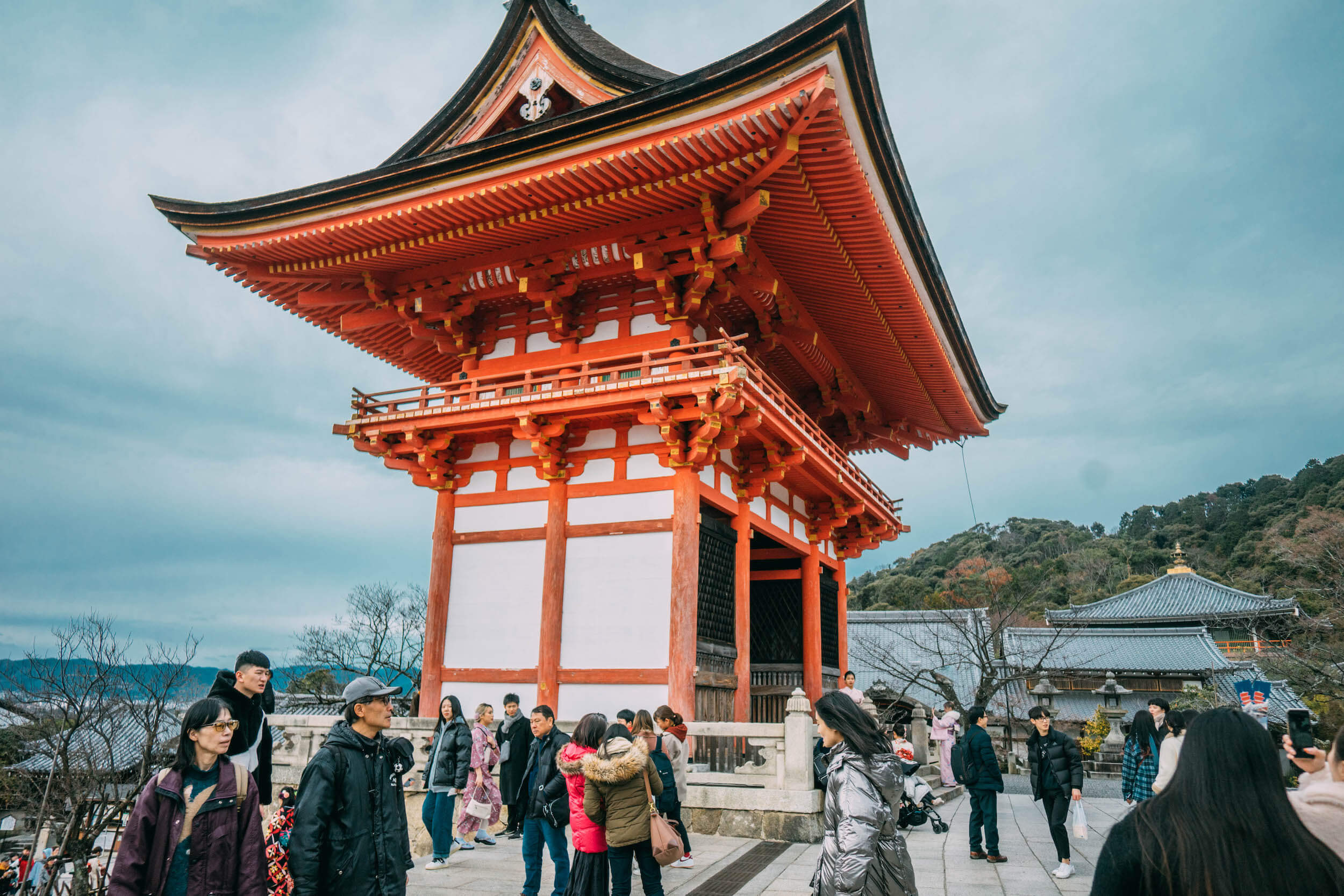
The most enjoyable part of visiting these grounds besides admiring all of the incredible Japanese architecture is the view! From up here, you get a pretty great view of Kyoto below you.
5. Hike up Fushimi Inari Shrine for sunset
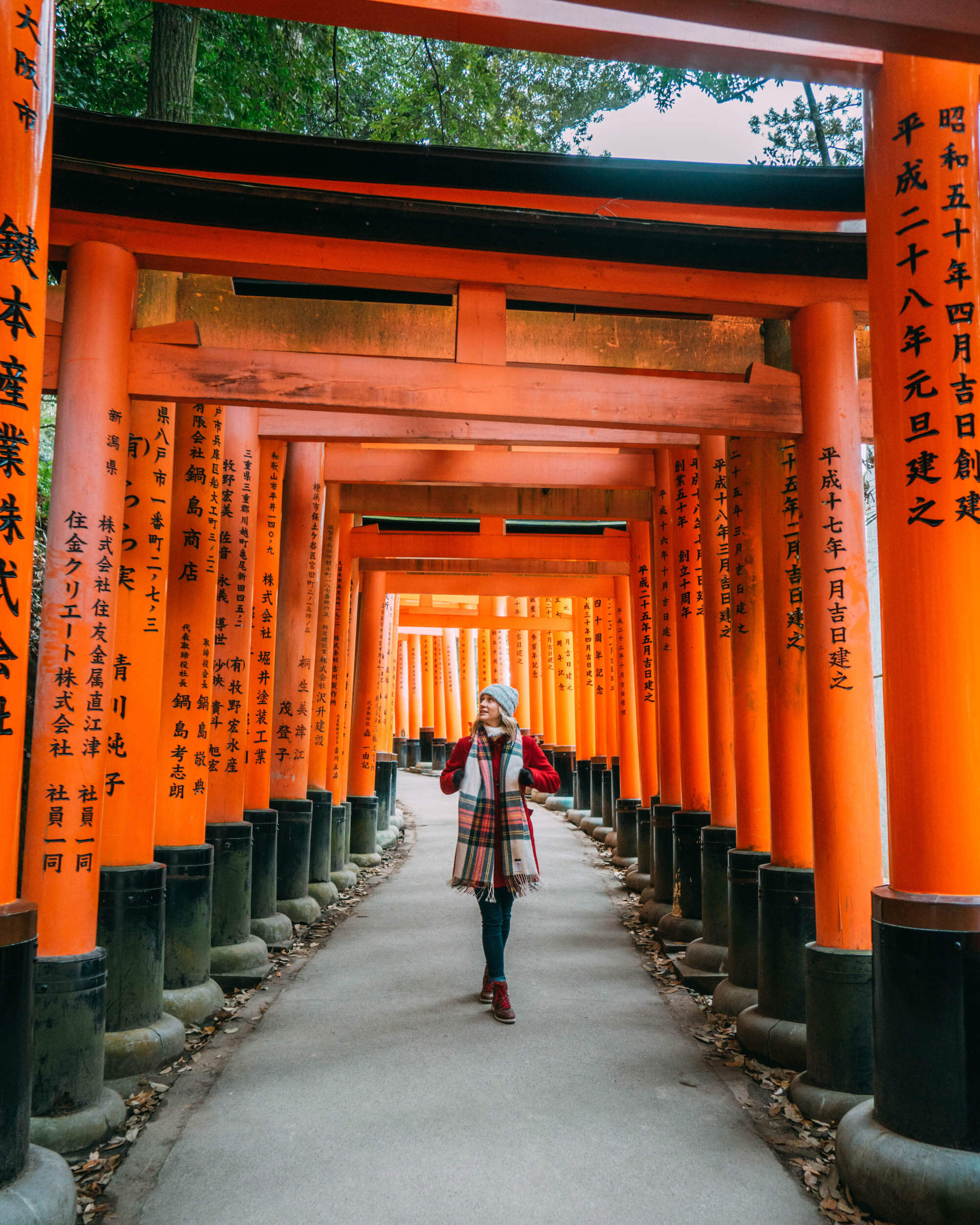
One of my favorite places to visit was the famous Fushimi Inari Shrine, a Shinto shrine that sits at the base of Inari Mountain. Perhaps you have seen these famous orange columns (which are actually called torii gates) all over Instagram, but did you know that there are thousands of them that line hiking paths up the mountain, and each one has been donated by someone?
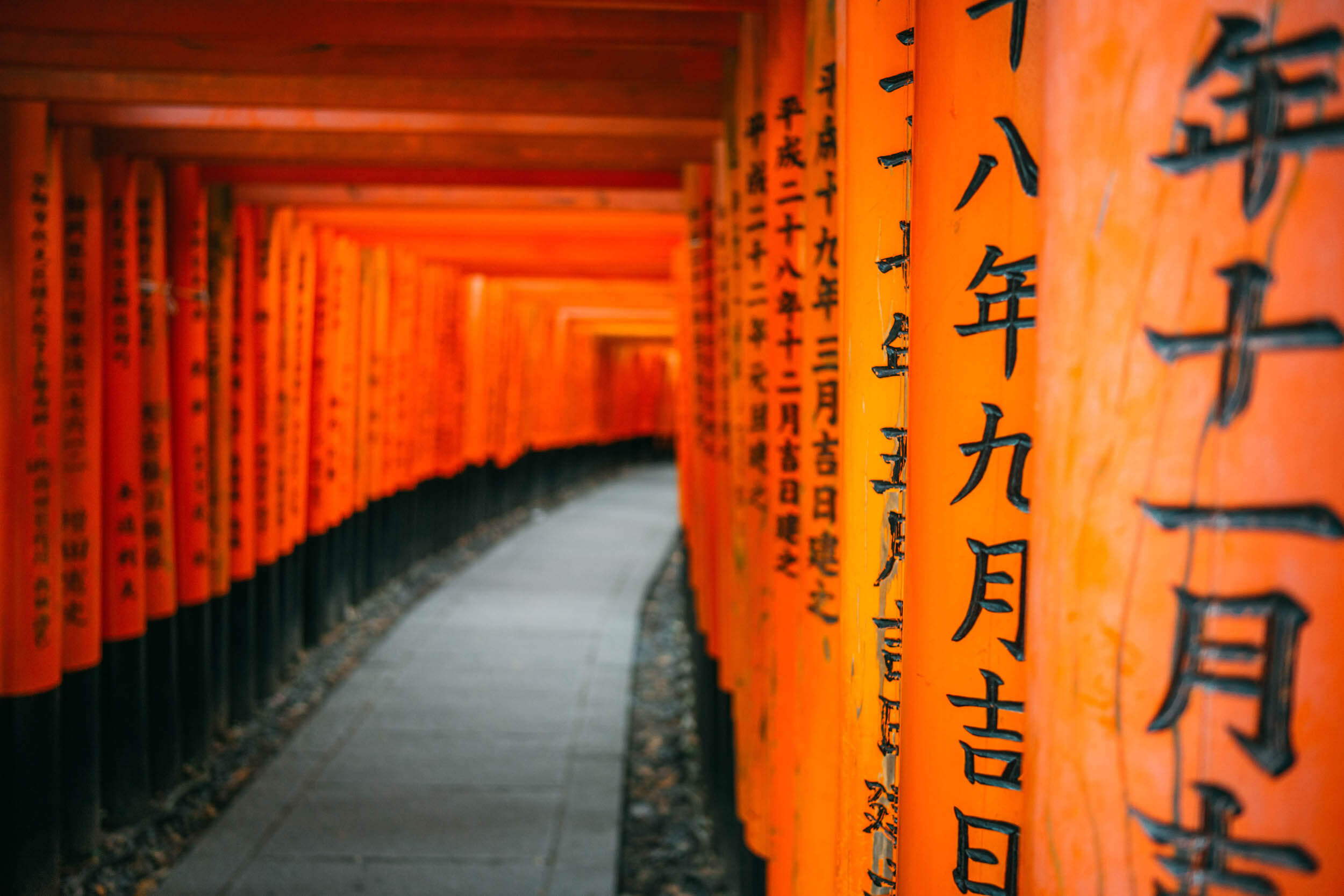
On the back of each torii is the name of the donor and the date it was donated. While walking forward along the path they just look like orange painted columns, but if you turn around, you can see the black inscriptions
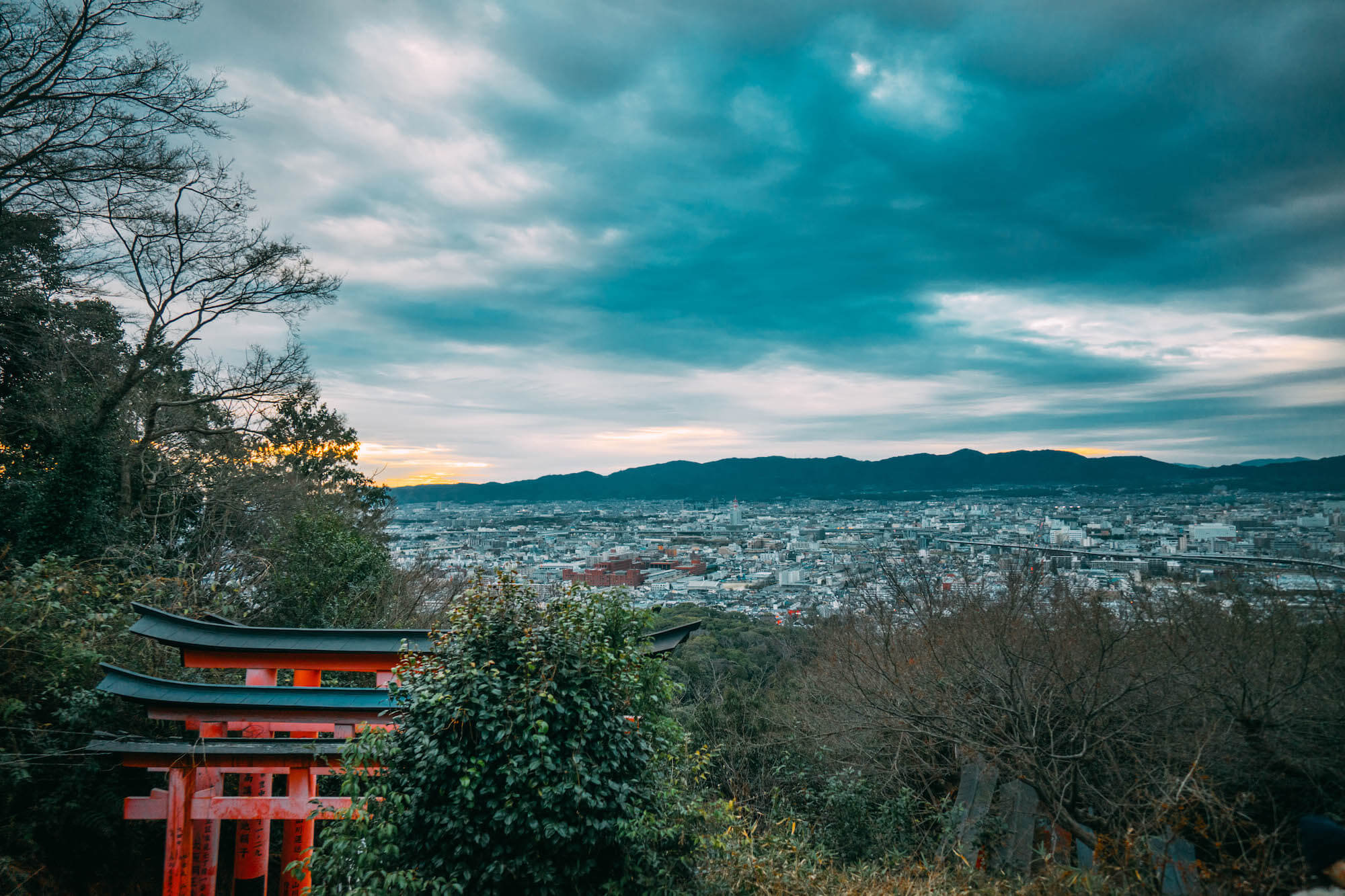
When hiking up Fushimi Inari Shrine, try to time your visit with the sunset. We did this by accident and it turned out to be such a blessing! It took us about 40 minutes to hike up to the viewing area (pictured above) and by then the sun was just starting to go down. It’s so gorgeous to not only see the sunset but to see it set over the city below.
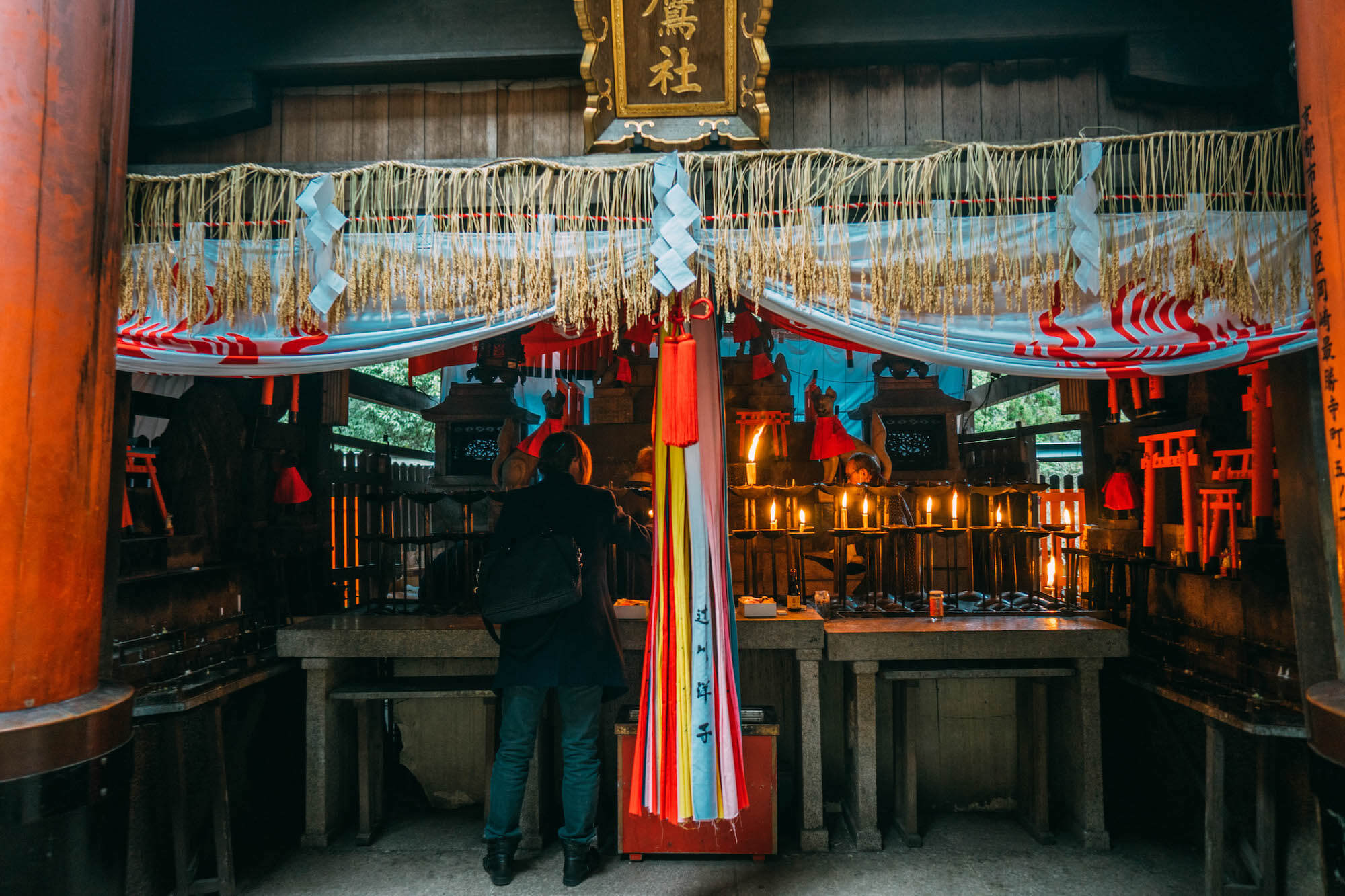
I also recommend hiking up around sunset because there are fewer tourists AND you’ll get the opportunity to see all of the candles lit in the mini shrines on your way back down. I loved how bright the orange torii gates within Fushimi Inari Shrine and the burning candles contrasted against the quickly darkening night sky.
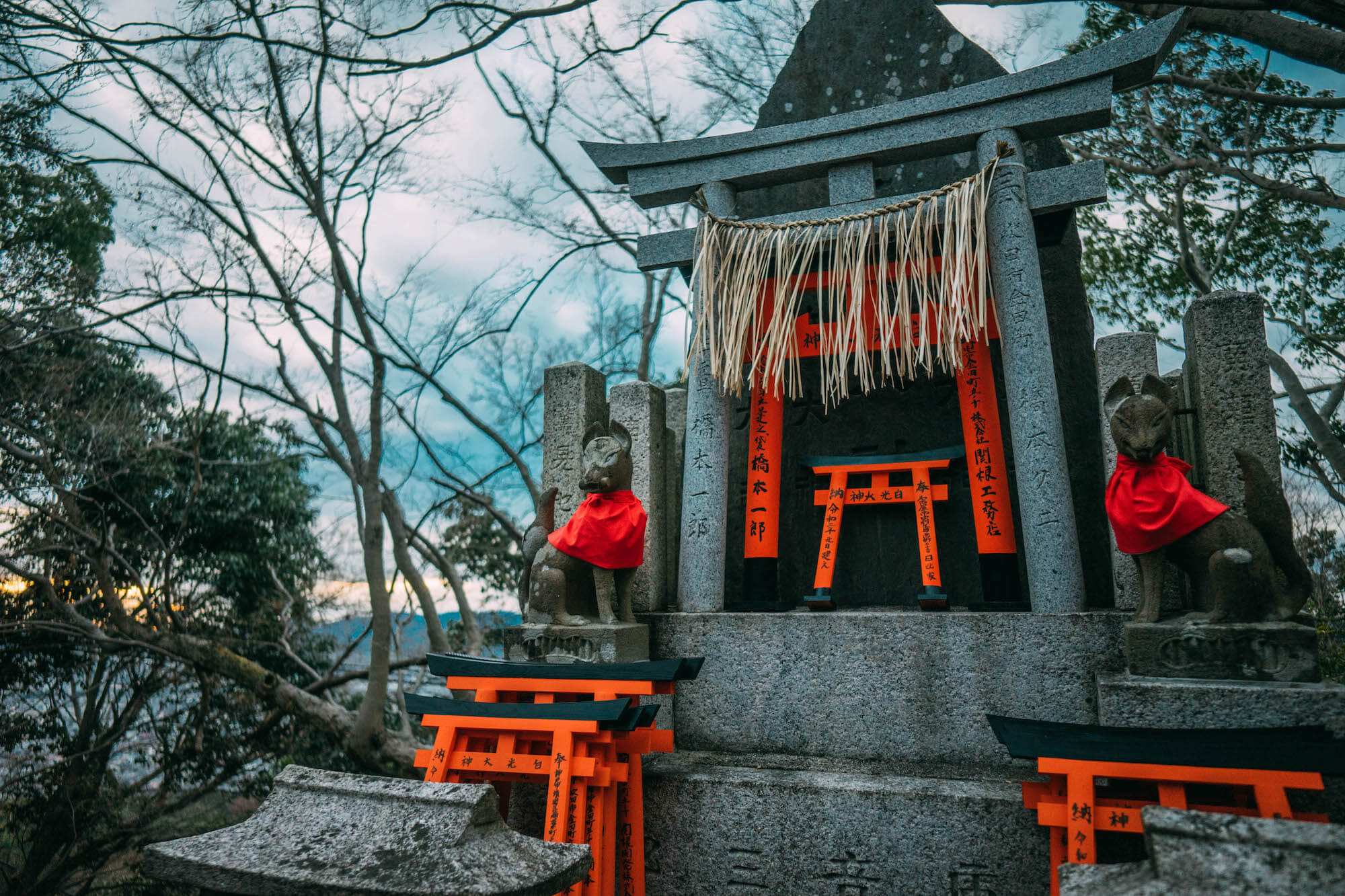
Upon observing these shrines, you’ll notice a pair of guardian foxes found on each side of any Inari Shrine’s entrance, called Komainu. Komainu are meant to ward off evil spirits and protect the shrines.
This was such a highlight to my visit and is not to be missed!
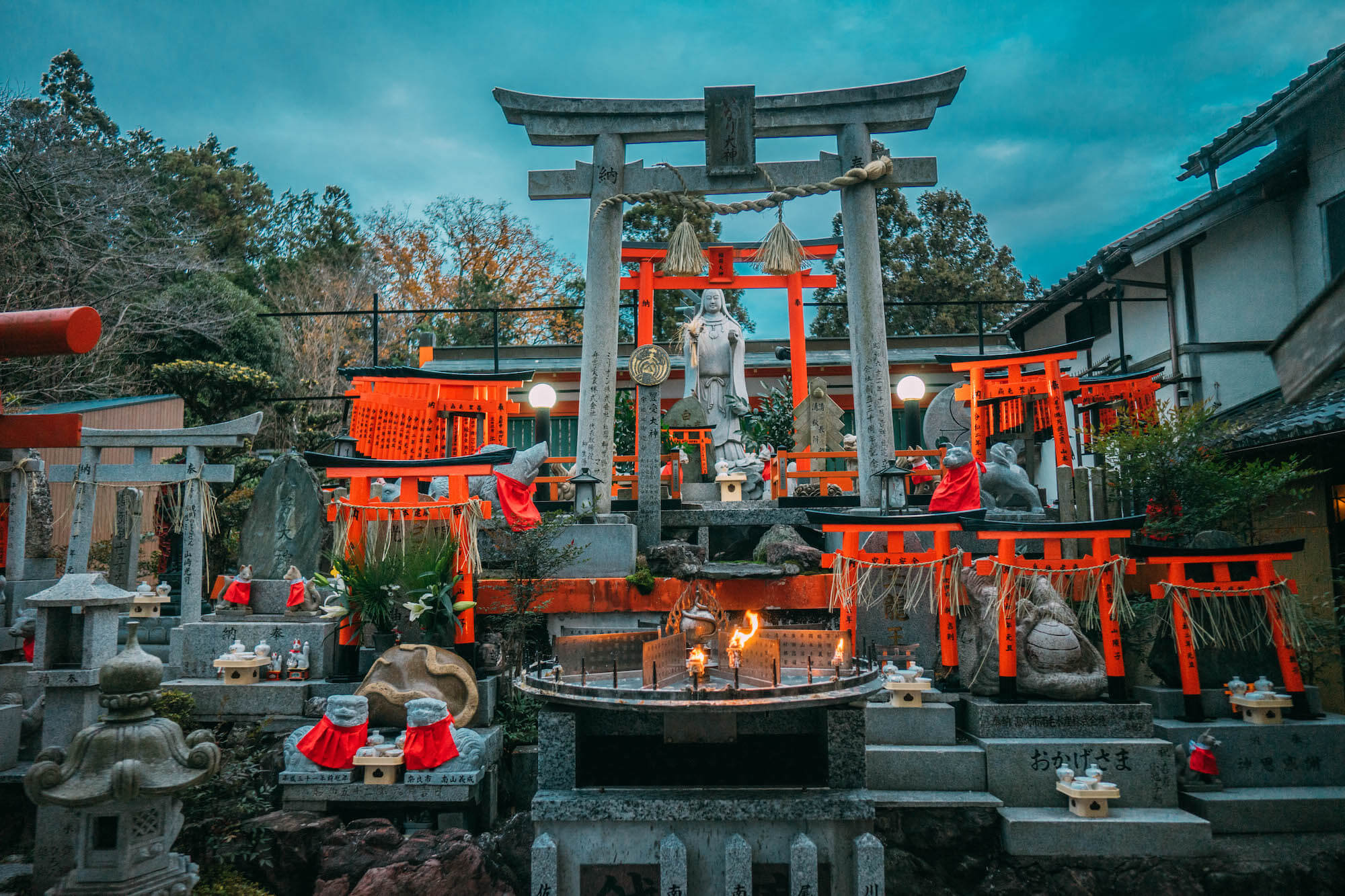
6. Relax and enjoy some contemporary Japanese art at BnA Alter Museum
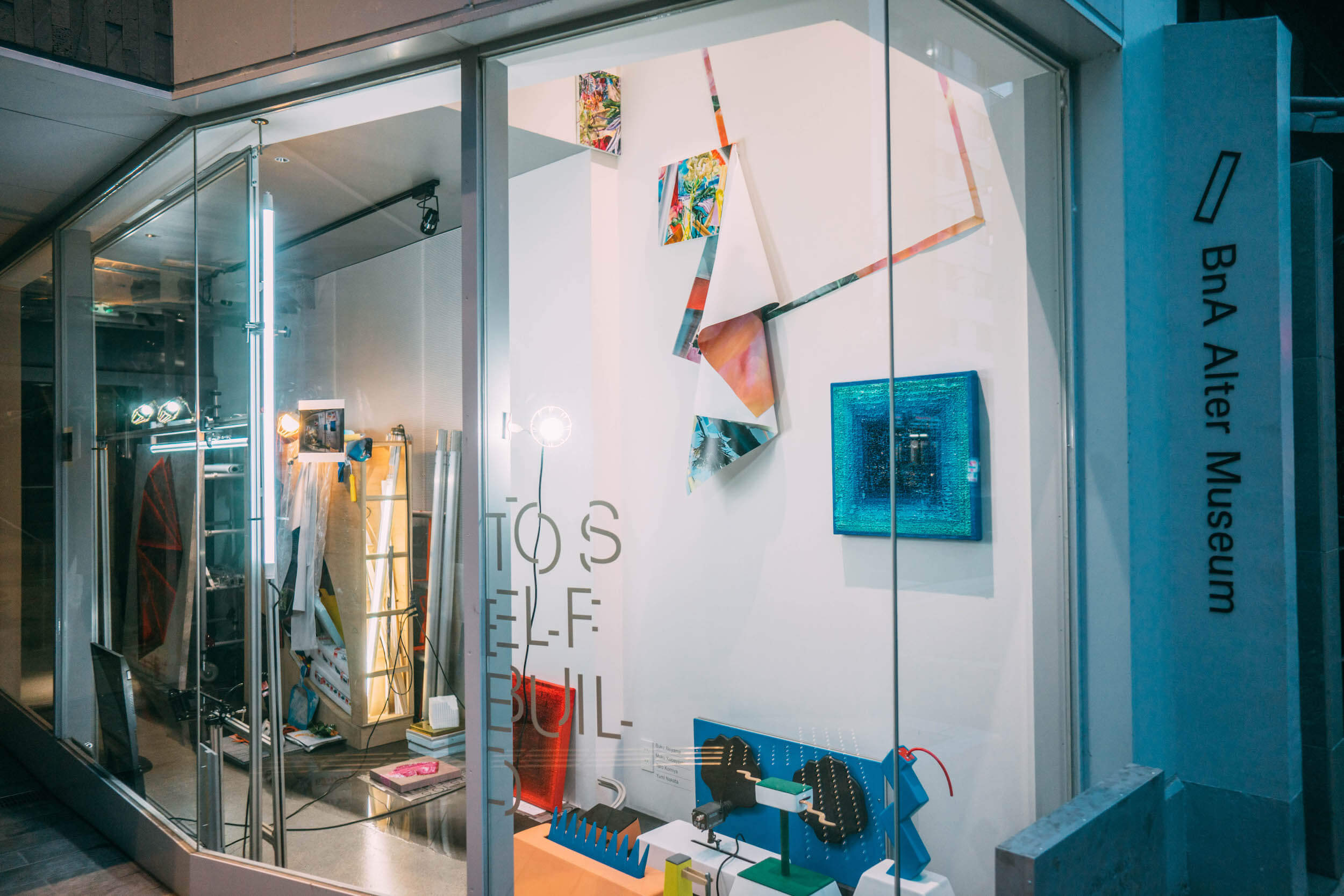
I had mentioned the BnA Alter Museum hotel bar, Untitled, in yesterday’s itinerary, but I recommend returning to in order to check out this place in more detail. Not only is it an art hotel and trendy bar hosting live art events and DJs, it’s also a 10-story vertical art gallery showcasing the best of Japanese contemporary art.
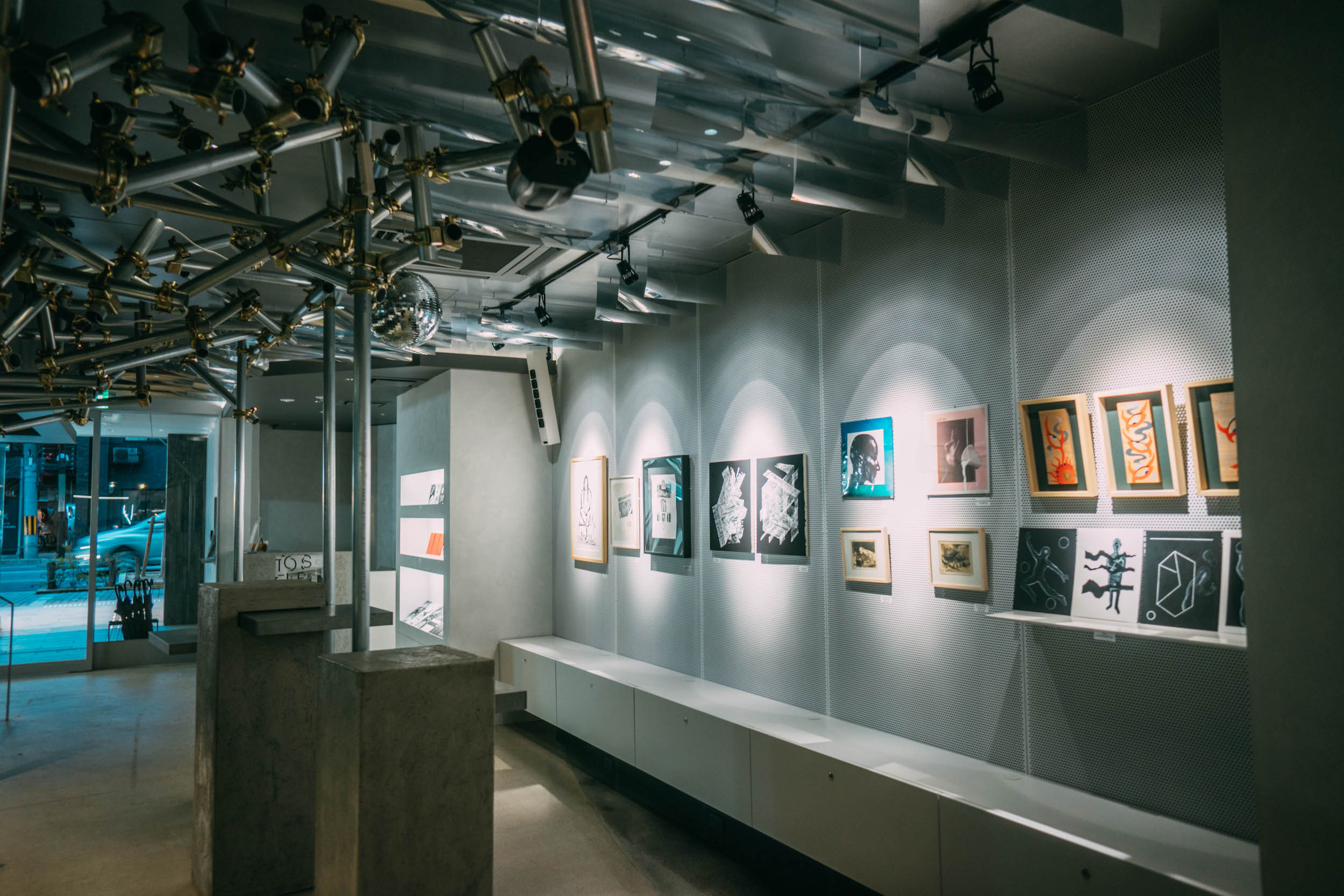
Lose yourself amongst the many floors of art in the 30-meter vertical Staircase Gallery open to the public.
They are determined to provide an alternative, radical and truly authentic experience by exhibiting dynamic, provocative and engaging art, artists, and creators.
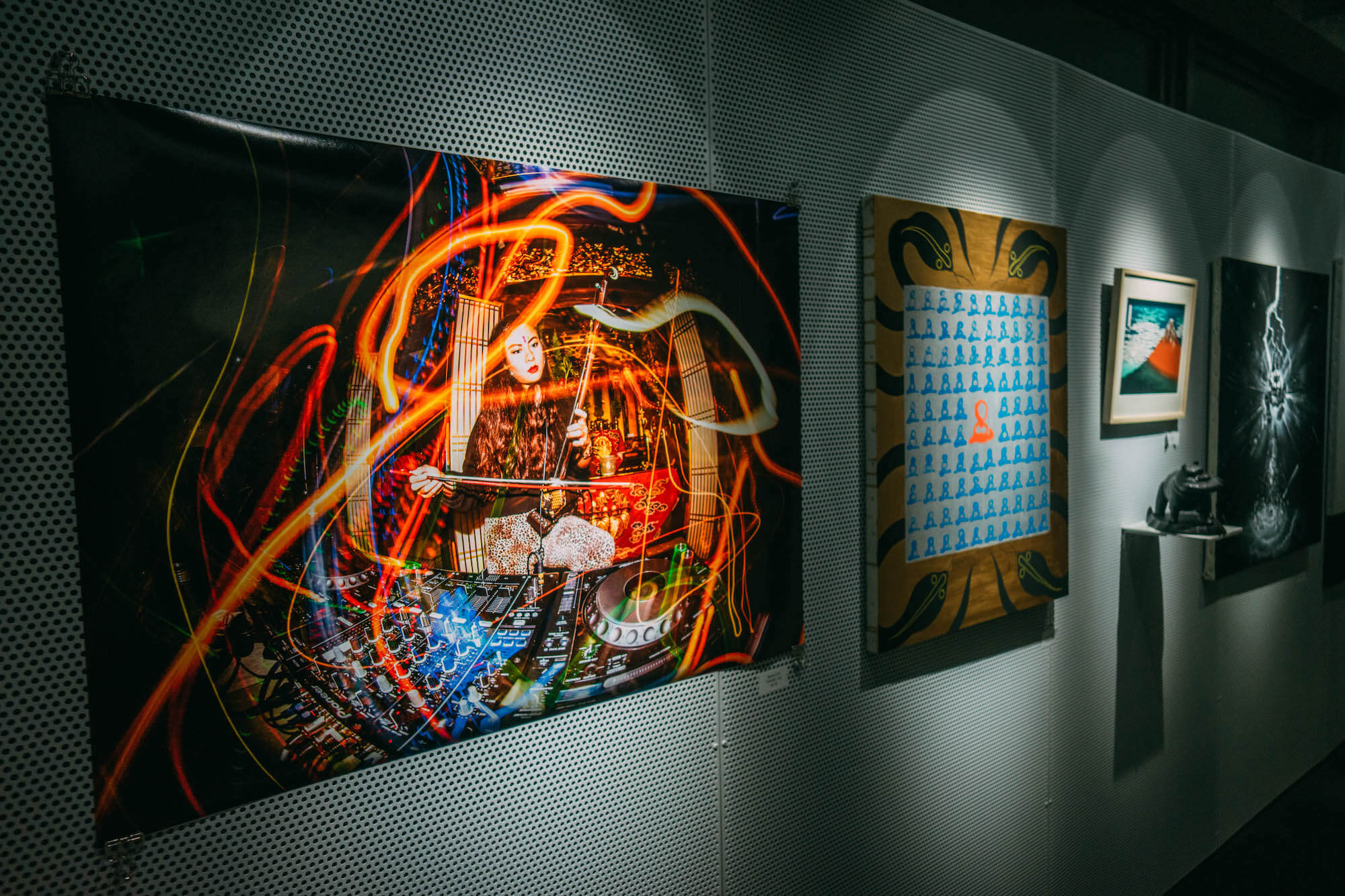
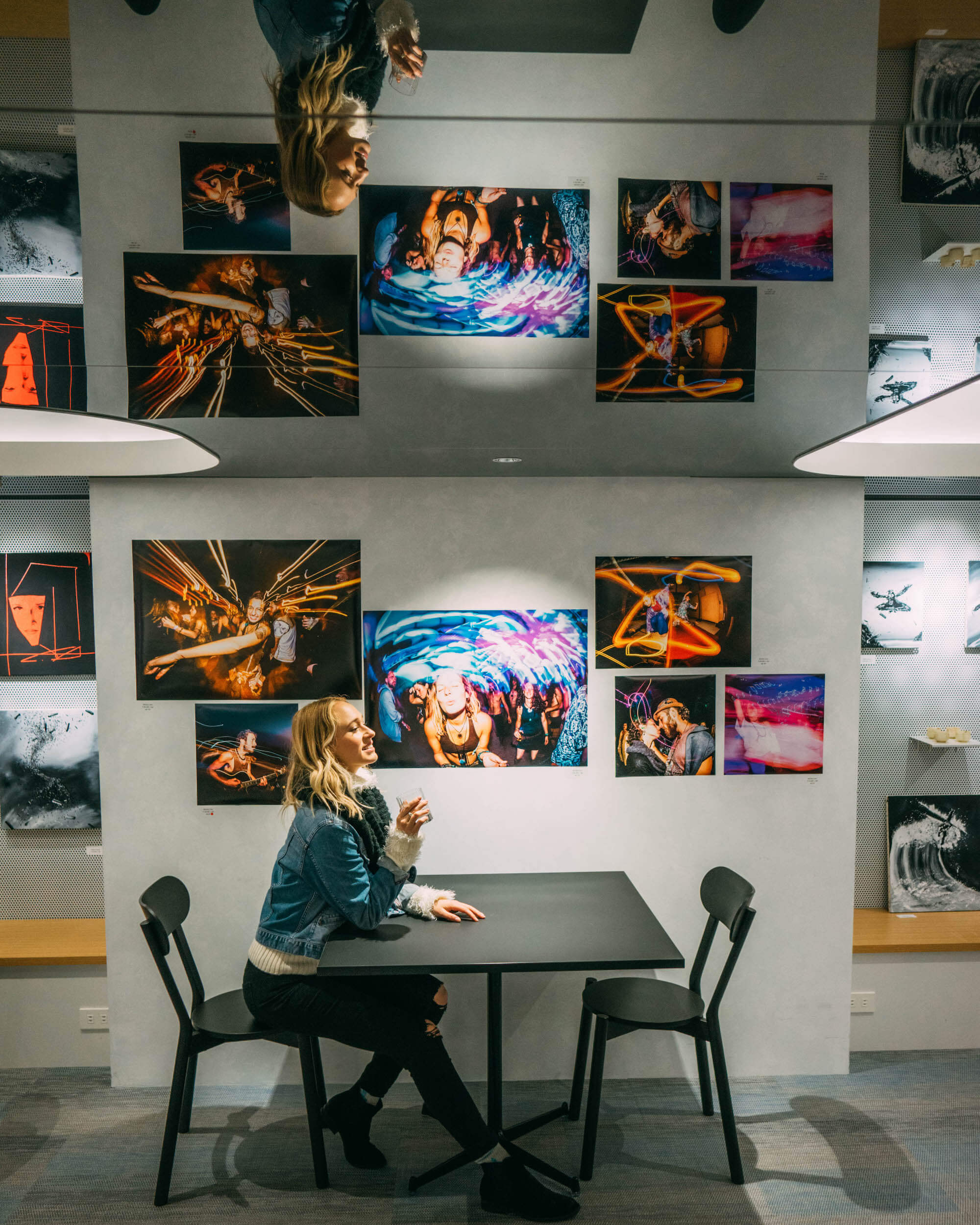
On the second floor you’ll find exhibitions by local, talented, up and coming artists which change monthly. They also host a number of events, tours, workshops, and talks here, and even have a cafe and lounge here so you can sip your coffee an admire the various art pieces! I took it upon myself to sub out the coffee for a whiskey in the evening
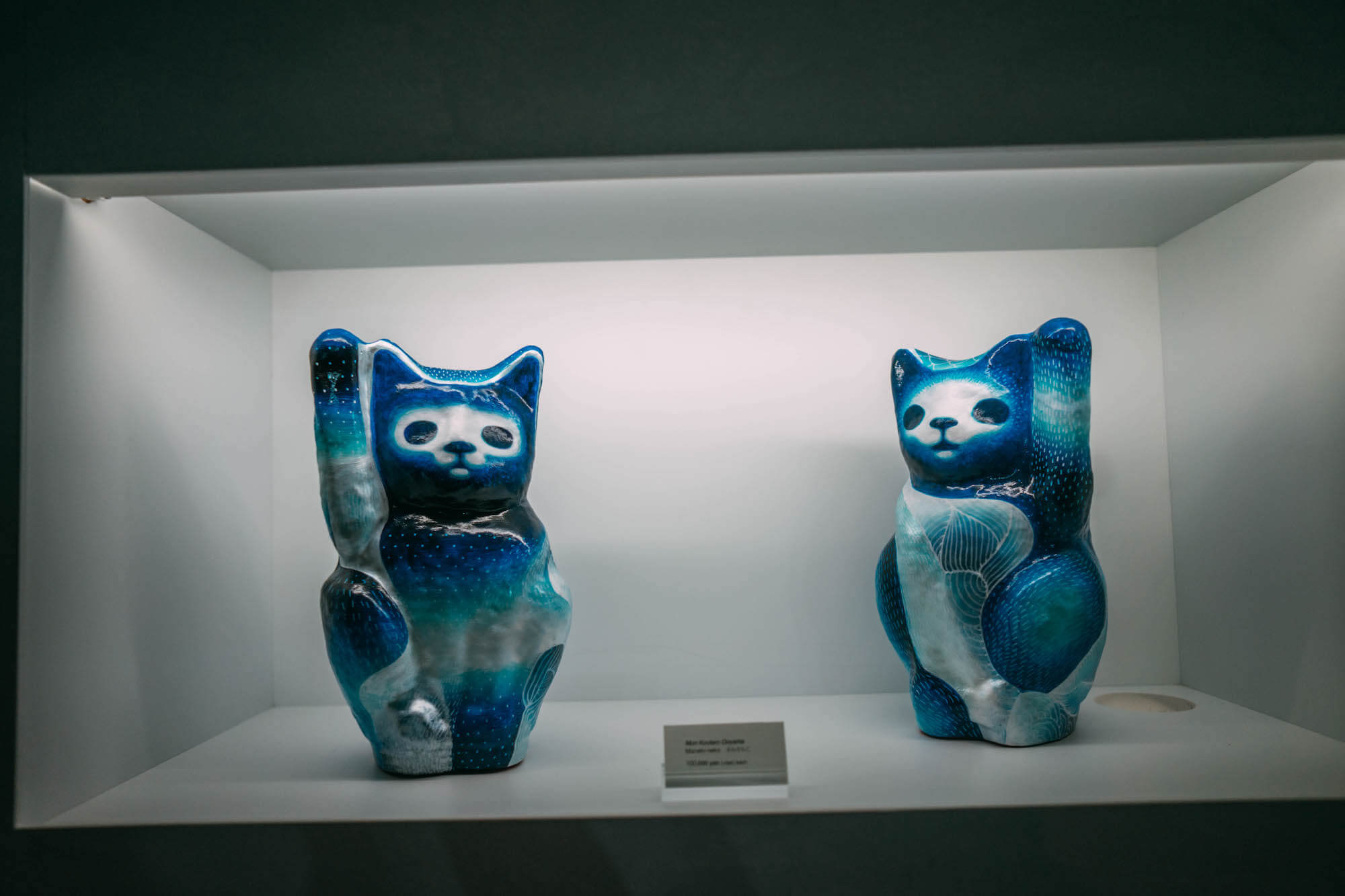
Even if you’re not staying at BnA Alter Museum (though I totally recommend it!) make sure you drop by to check out their incredible art galleries.
7. Treat yourself to a traditional Kaiseki-style Japanese dinner at Hanasaki Nishikiten
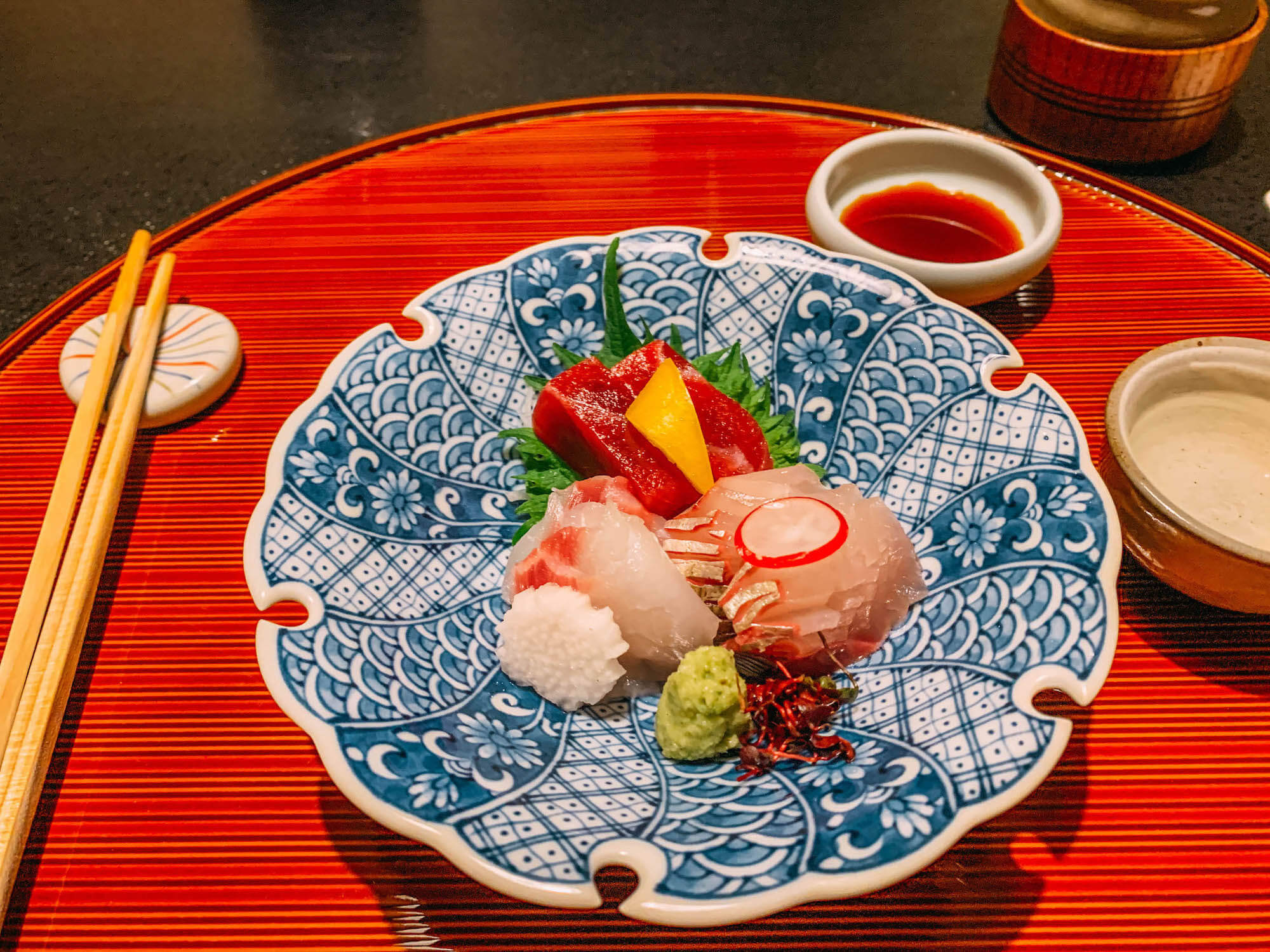
With only a 2-day itinerary in Kyoto to follow, you’ll want to choose your meals wisely. If there’s one meal you’re going to want to really splurge on during your visit – it’s this! Hanasaki Nishikiten offers Kaiseki style dining which is a traditional multi-course Japanese dinner made with the finest skill and technique. It is the most refined form of Japanese dining and pricing can get up to hundreds of USD per person.
We called ahead to reserve a private dining room and also alert the chef of which Kaiseki set we’d be choosing.
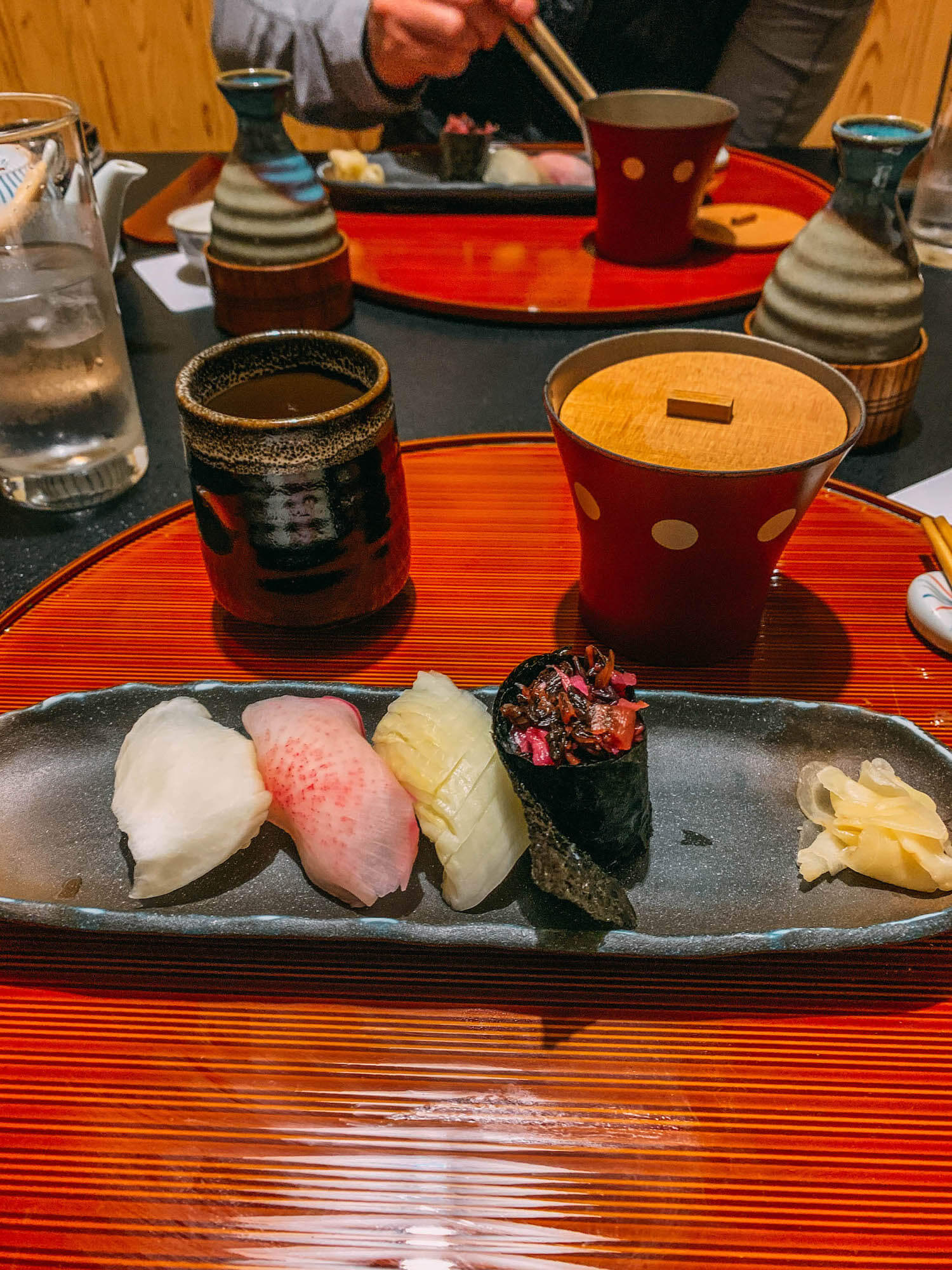
You see, Kaiseki dining is broken out into tiers – you first choose how many courses you want (for example, at Hanasaki Nishikiten offers 7, 10, or 11-course meals). We opted for the 11-course set (because, when in Japan…) but saw that there were three options within the 11-course set ranging from 9,000 to 15,000 yen ($84-$140 USD) per person. To my understanding, the exact same dishes are offered amongst these three options, with the only difference being the more expensive the set, the higher quality ingredients and the finer dishes and bowls used.
Here is a breakdown of the 11-course Kaiseki set:
- Small bowl
- Appetizer
- Sashimi
- Soup
- Grilled dish
- Boiled dish
- Tempura
- Red soup stock
- Sushi
- Miso soup
- Dessert
First off let me start by saying that each dish brought out is meticulously prepared and is like a culinary work of art. I wish I had taken better photos but I was too busy enjoying this beautiful dining experience! I guess that’s a pretty good reason
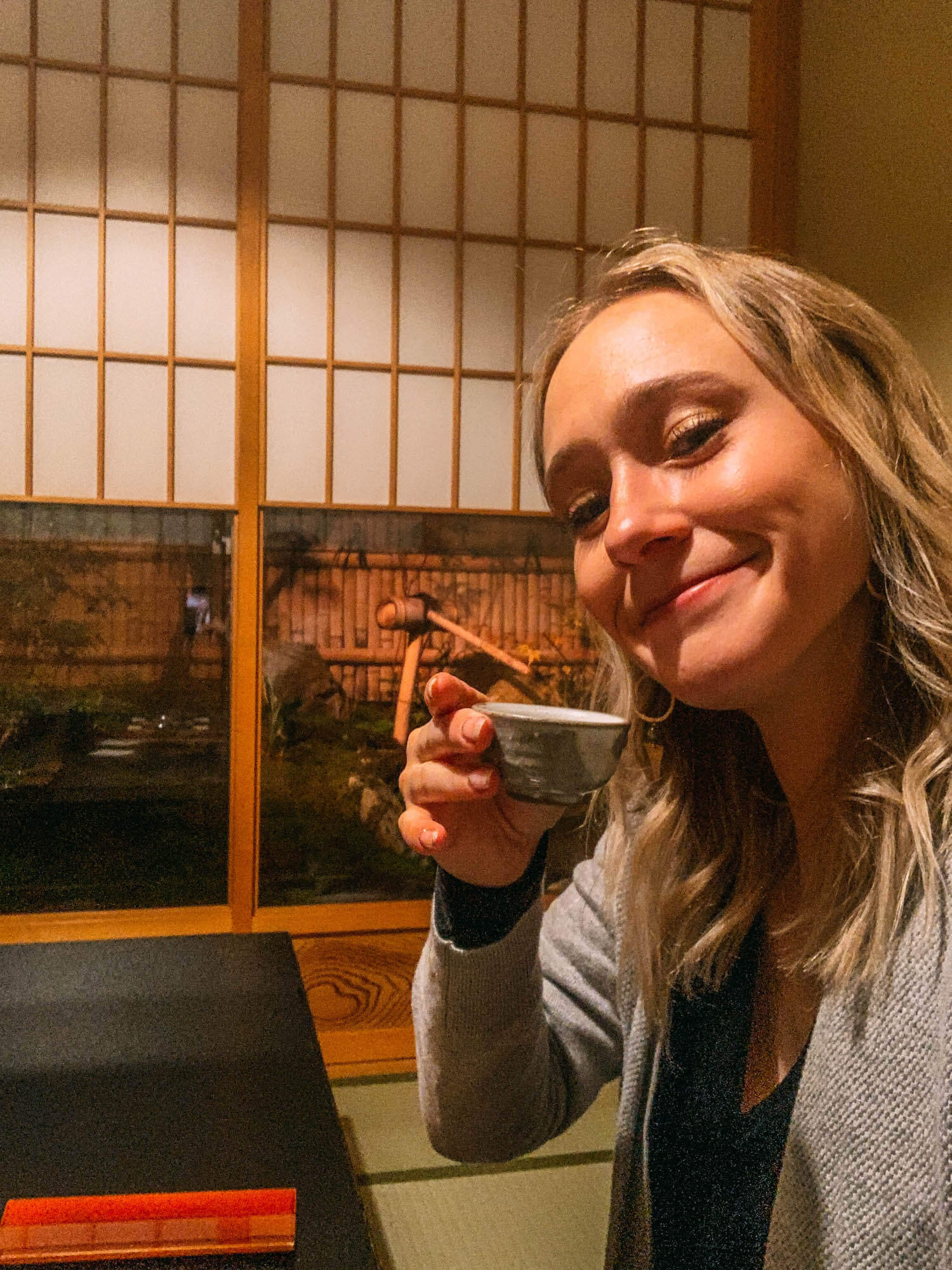
Secondly, there was something so special about having our own private dining room! The room was lined with traditional tatami mats, but they had a cutout in the floor so your legs could dangle vs having to sit on the floor cross-legged the entire meal. The private room was situated next to a Japanese zen garden which added a magical touch to the already beautiful ambiance.
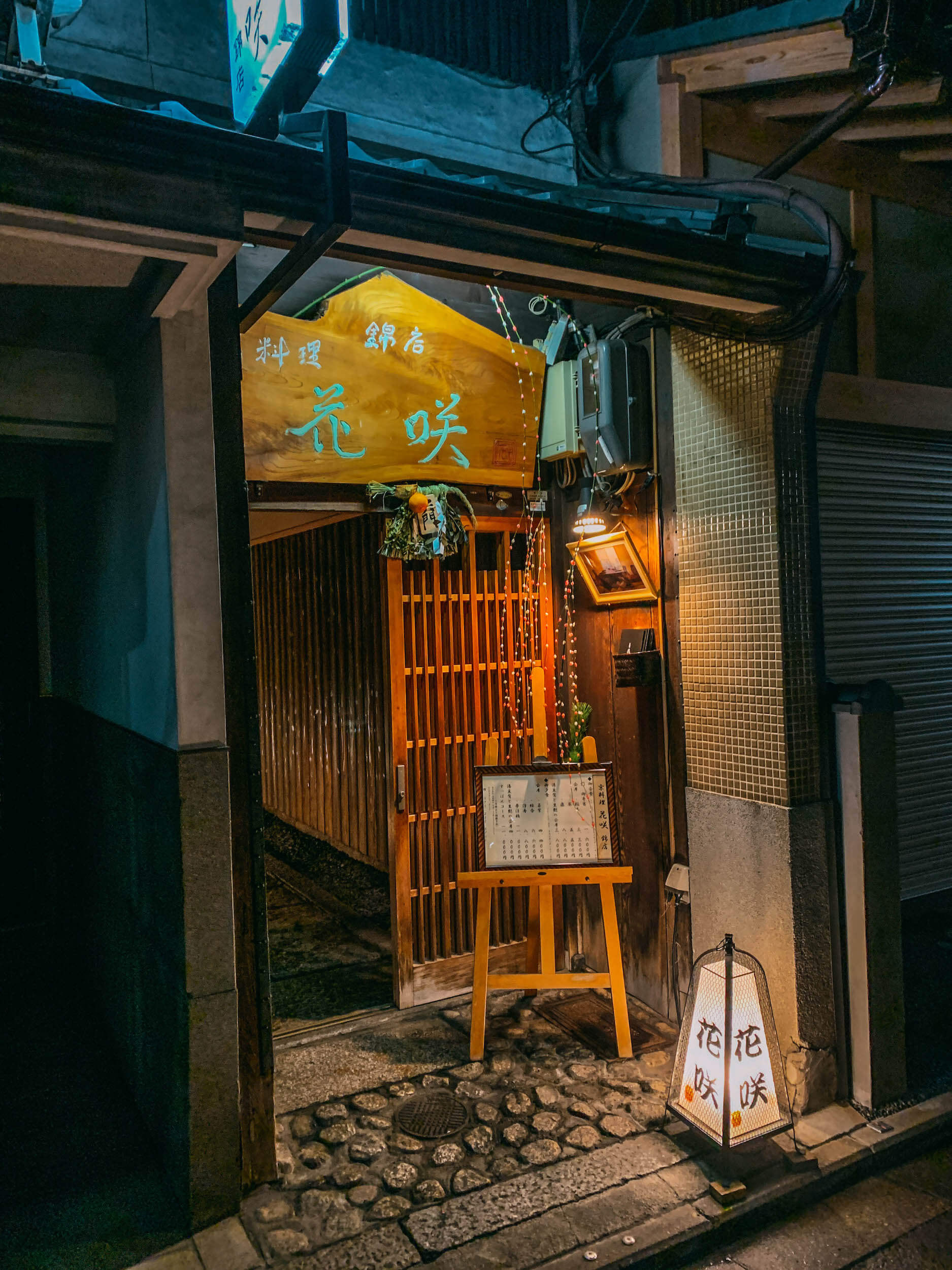
We also had a private waiter (dressed in full kimono) who explained each and every beautifully plated dish to us. If you’re on the fence about whether or not to indulge in a Kaiseki meal, I would 100% recommend it if you’re able. We are so grateful for the recommendation to try Hanasaki Nishikiten as it was relatively affordable for a Kaiseki meal and greatly exceeded our expectations. Well worth it!
Where to Stay in Kyoto
BnA Alter Musem
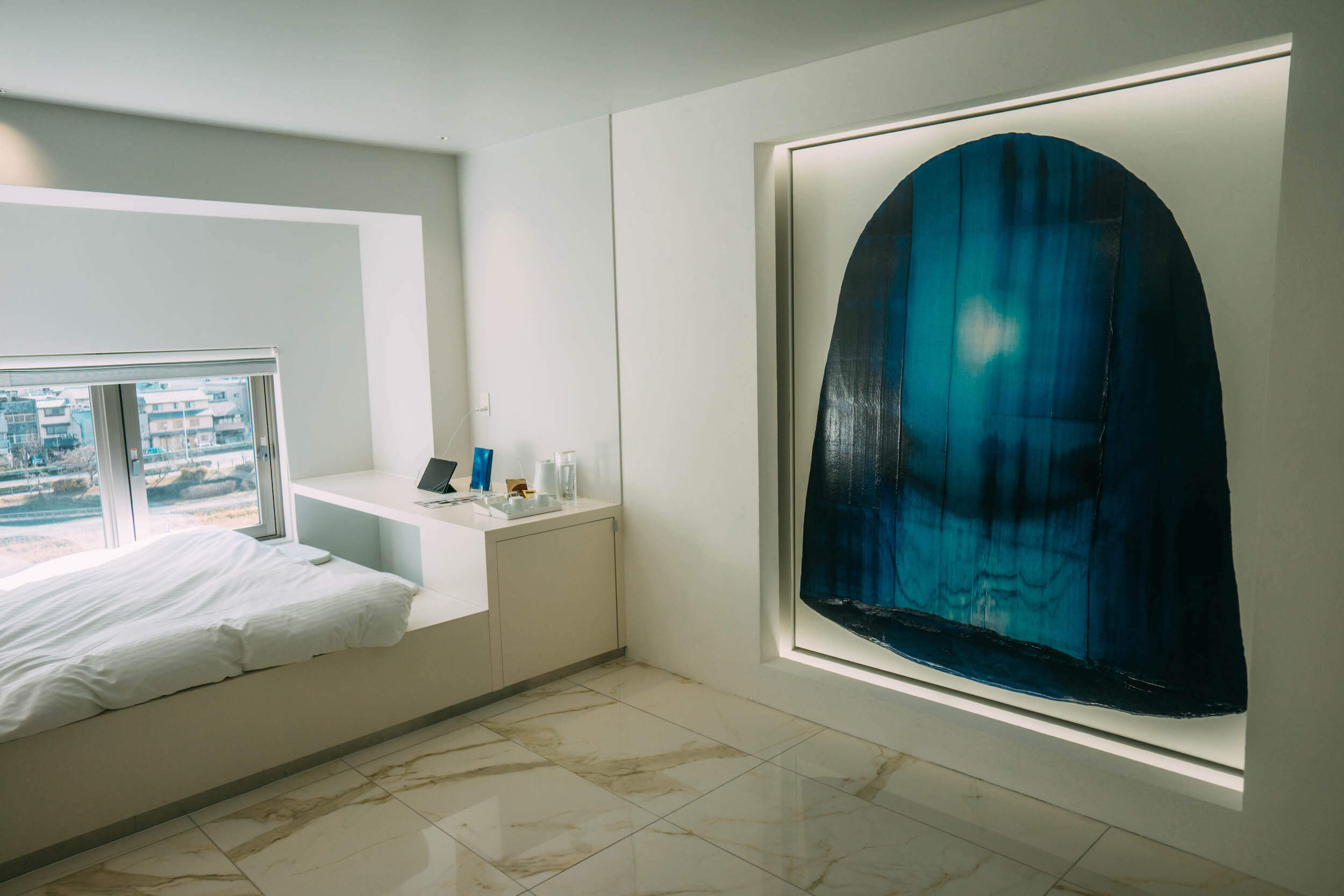
Ever dreamed of sleeping in an Art Museum? Welcome to BnA Alter Museum, a boutique art hotel in Kyoto featuring 31 unique art rooms you can sleep in! I stayed in the art room “From One Stroke: created by @mina_katsuki.
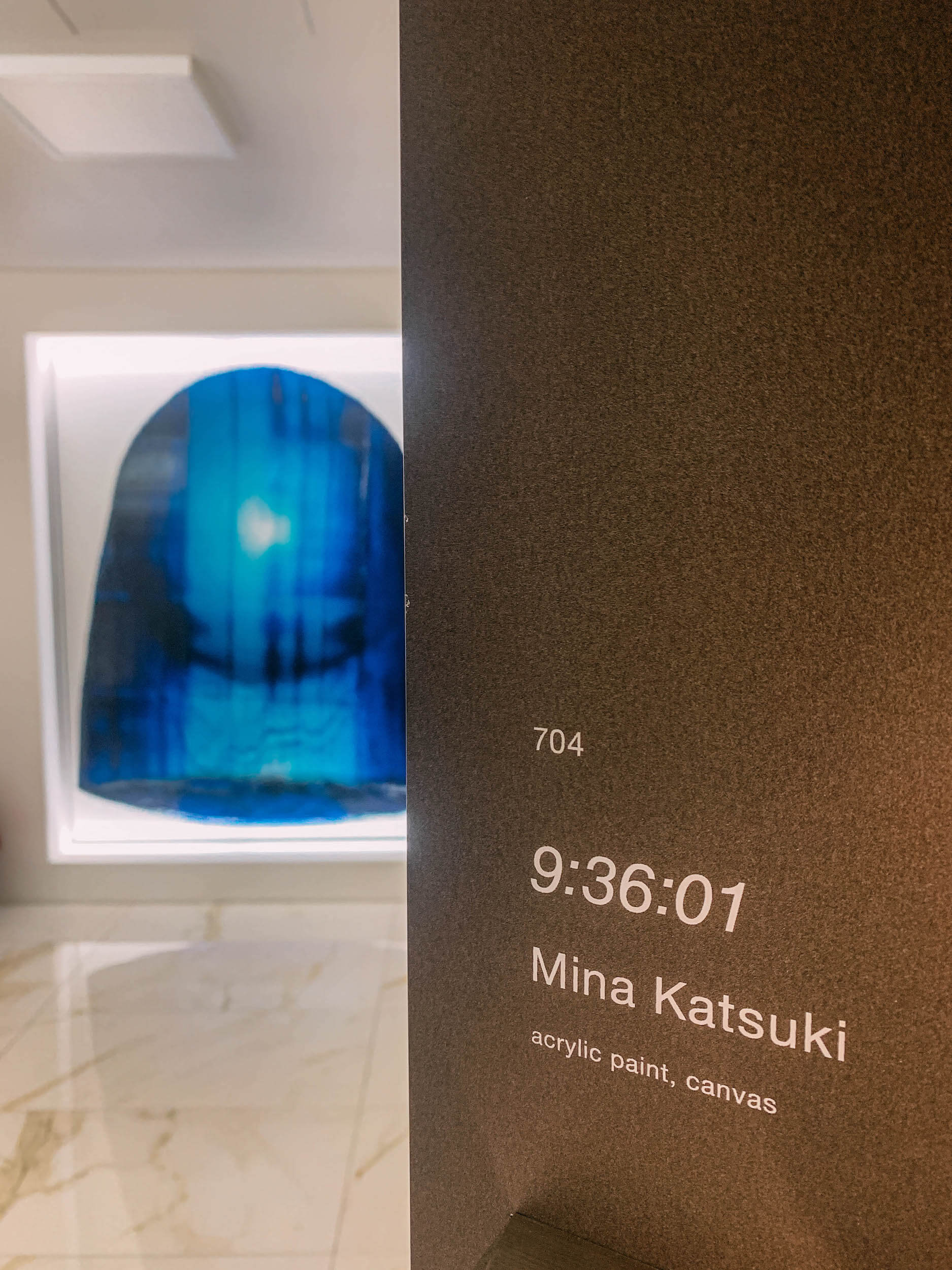
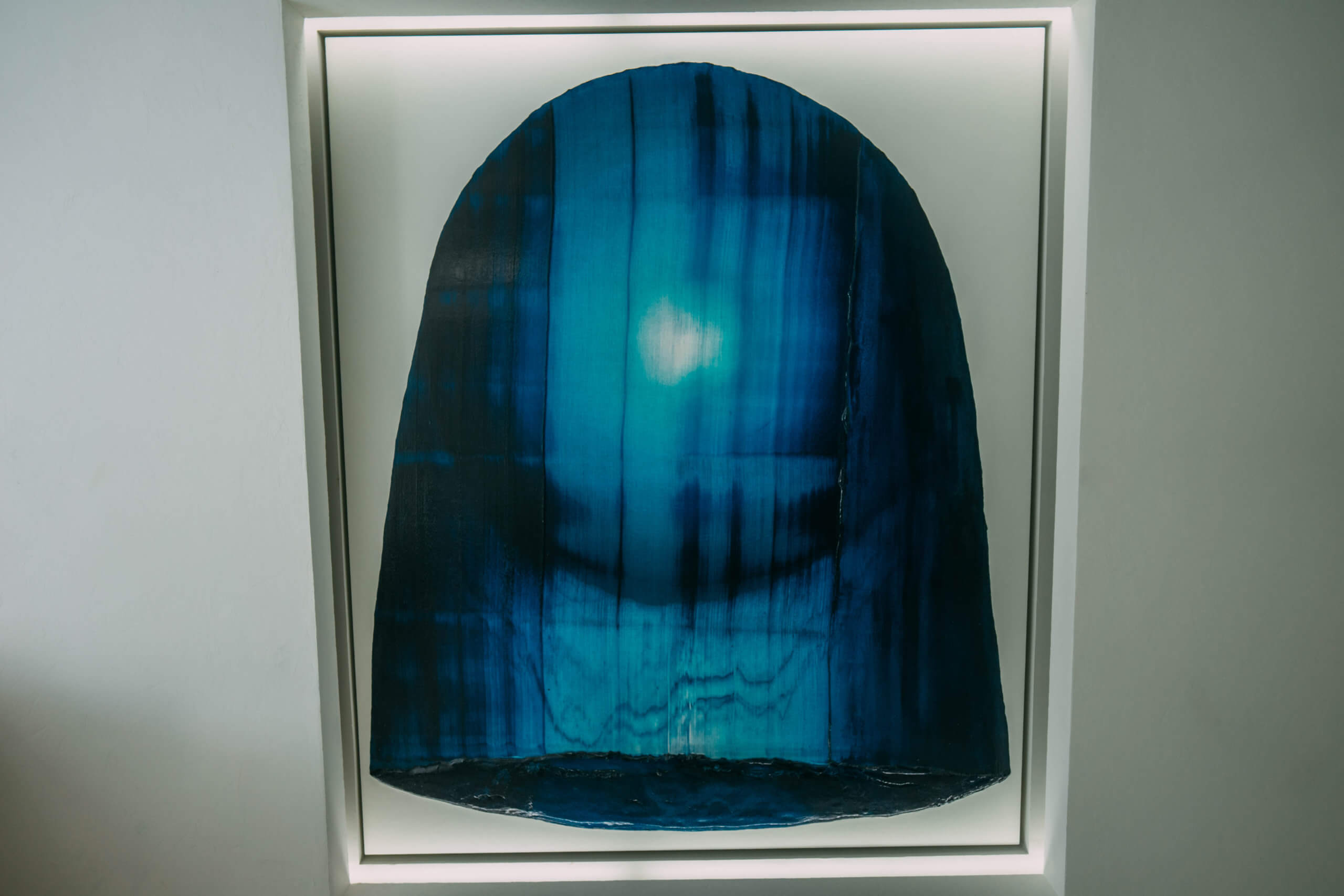
The Concept (from the BnA Alter Museum website): Katsuki’s minimalist paintings pay homage to their most fundamental elements, the paint and the single stroke. The paint is the protagonist in this story, with the single stroke plays the antagonist, asking to be repeated, to be fixed, to thin out the paint, reduce its potency. However, Katsuki has tamed the single stroke. The vibrant blue paint used in Katsuki’s work is an ancient Egyptian pigment known as lapis lazuli.
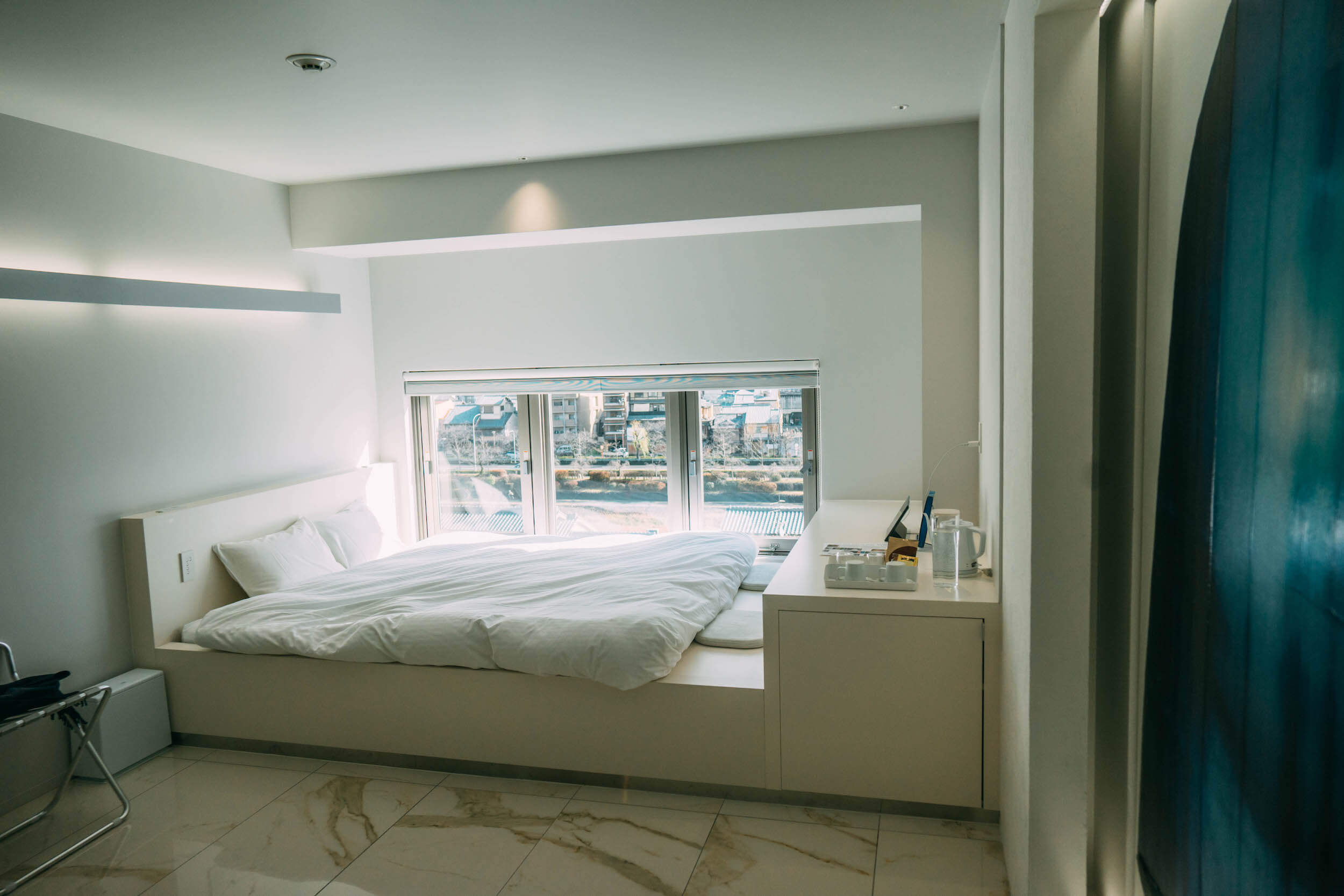
Not only did the room boast one-of-a-kind artwork but it also offered beautiful views of the Kamo River and quaint neighborhood which was perfect for people watching from the comfort of our own room!
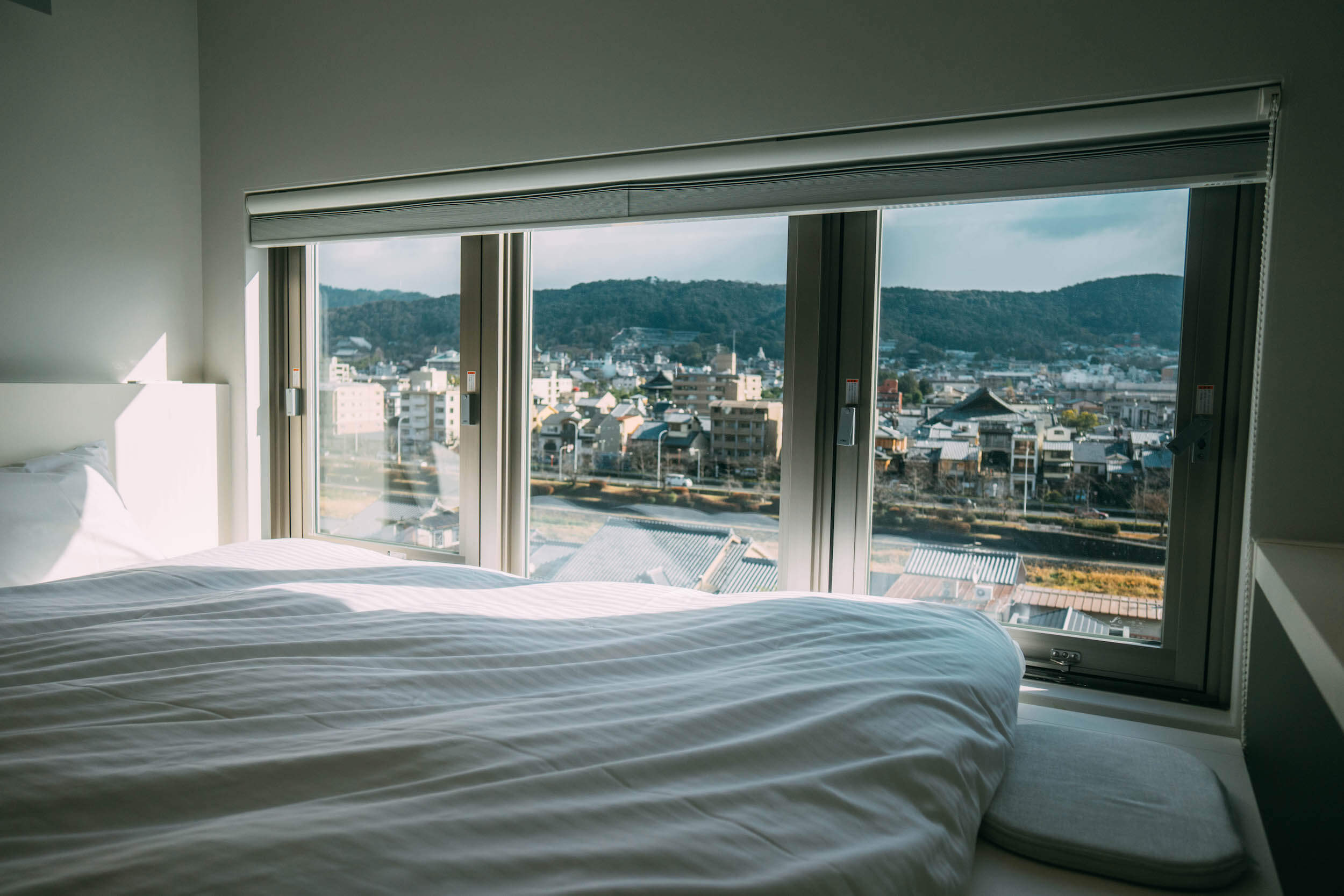
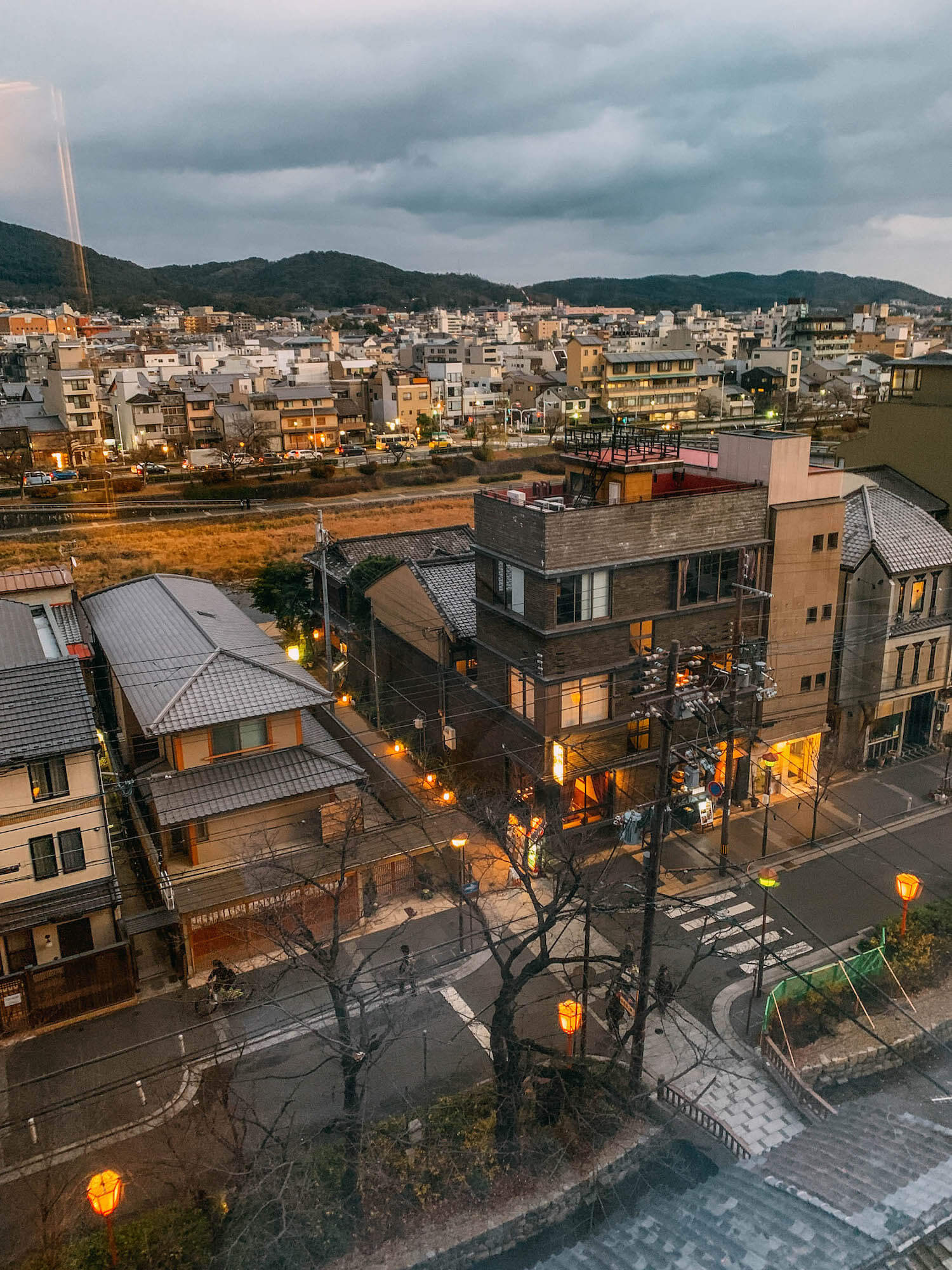
The art rooms in combination with the 10-story art gallery and ultra-cool warehouse-like bar make the BnA Alter Museum one of the most interesting (and definitely the most artistic!) places I’ve ever stayed.
BOOK YOUR STAY WITH BnA Alter Museum HERE!
Disclaimer: I received a complimentary stay with BnA Alter Museum in exchange for my opinions, but all opinions are my own. I only recommend places that I love!
Wander On,
Wanderluluu xx

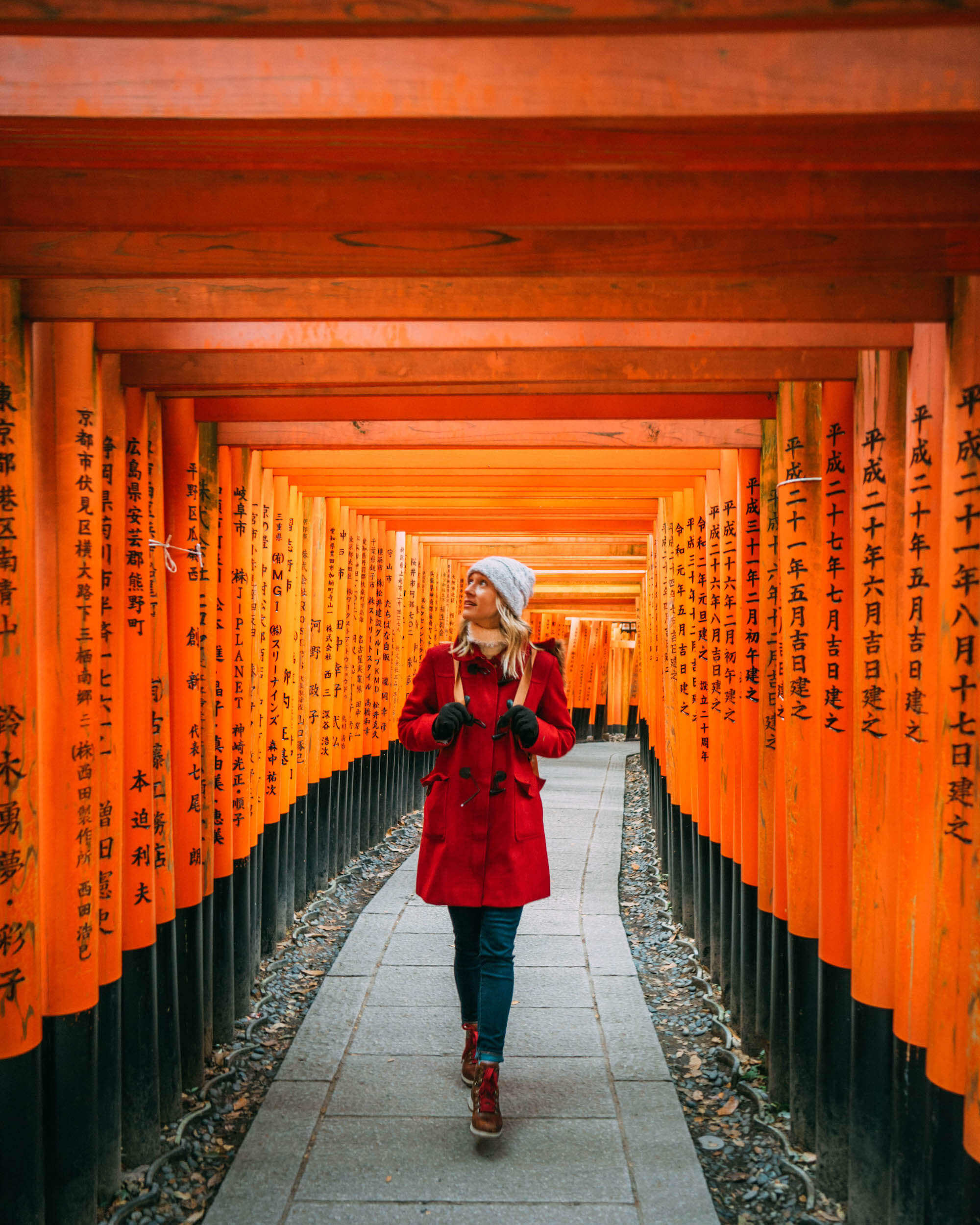
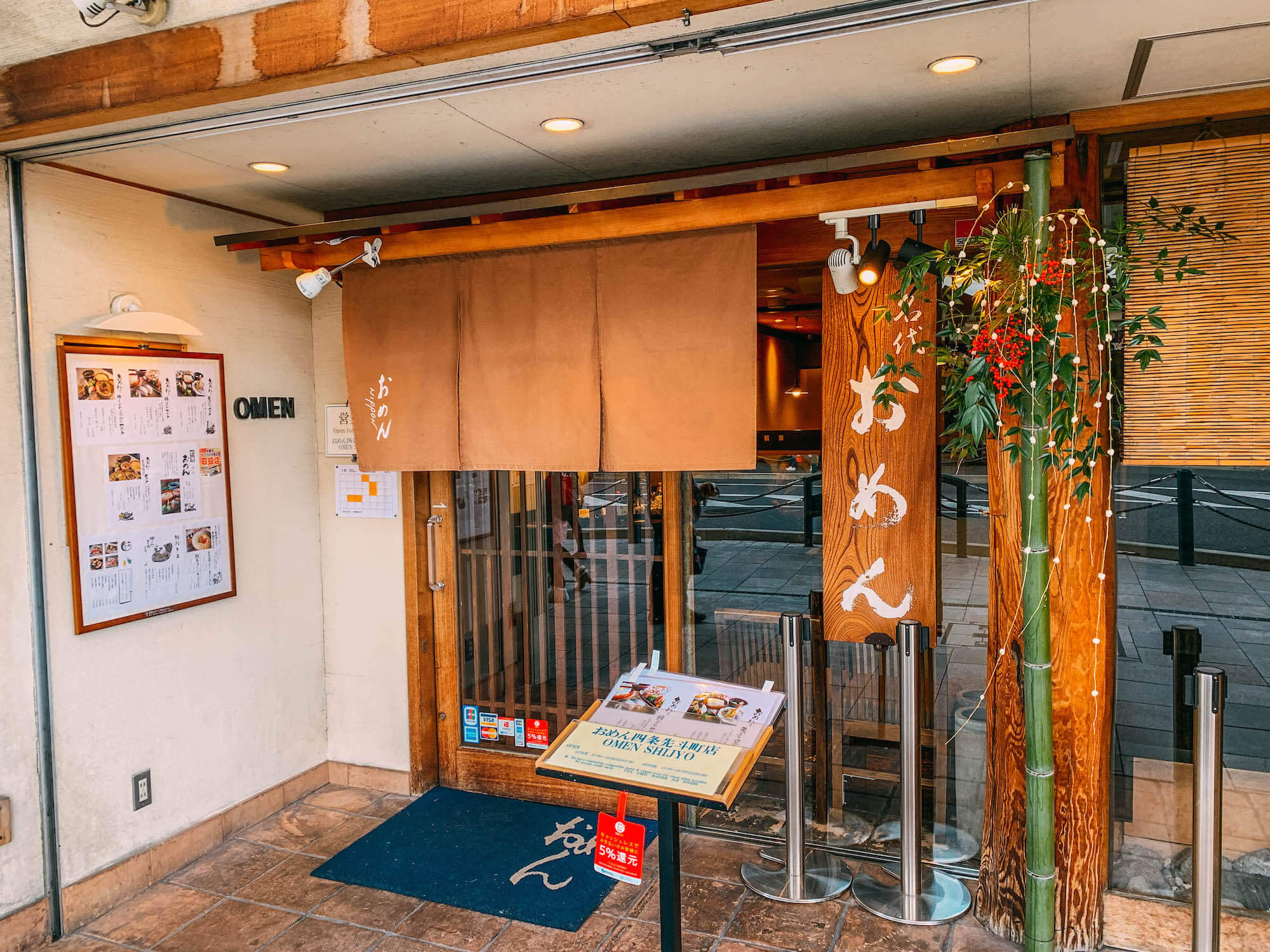
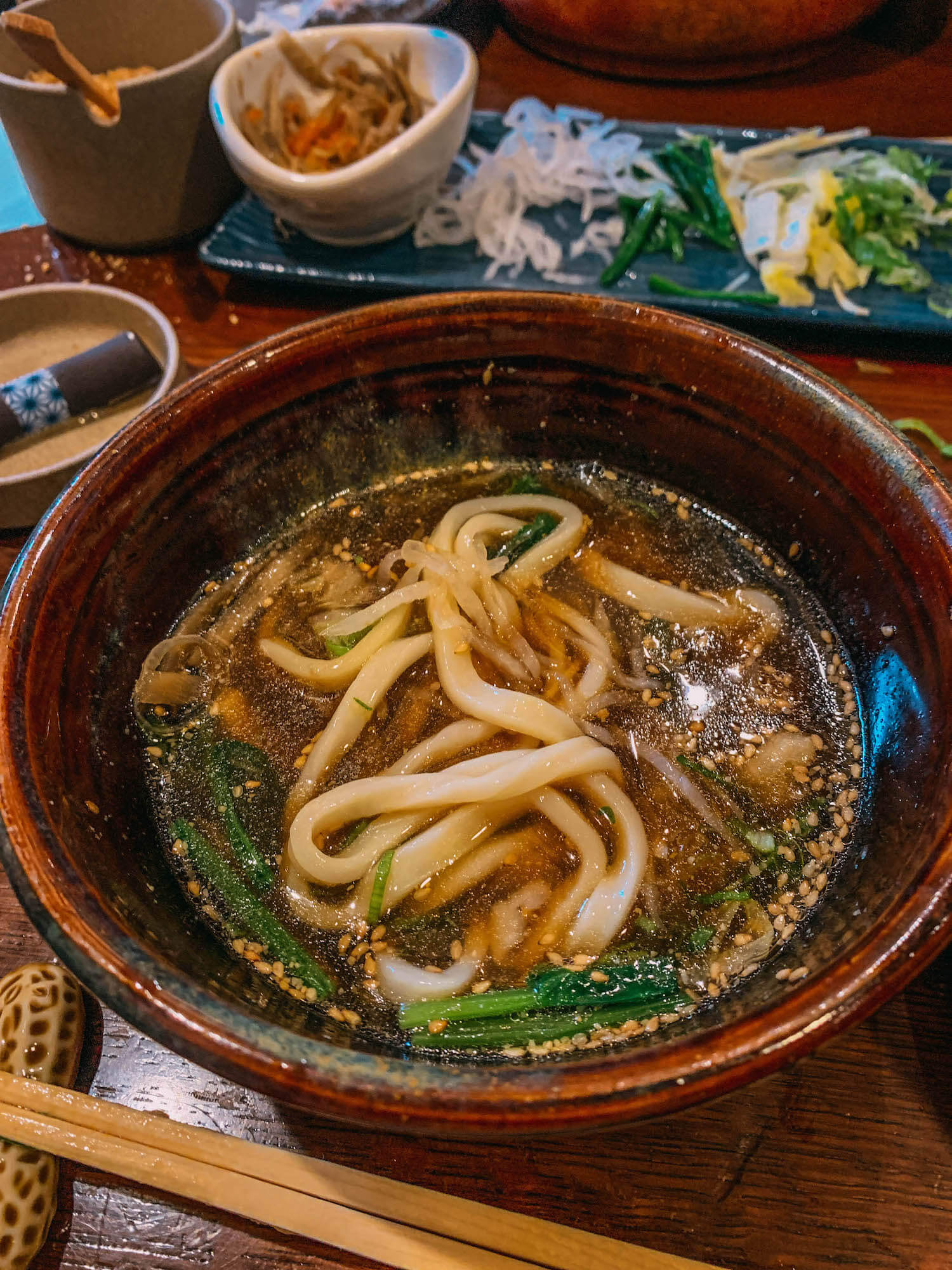

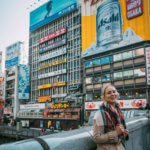
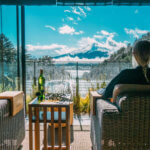
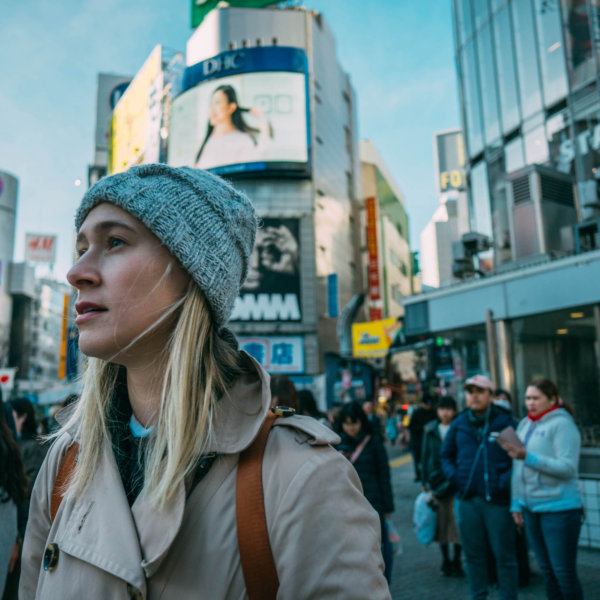
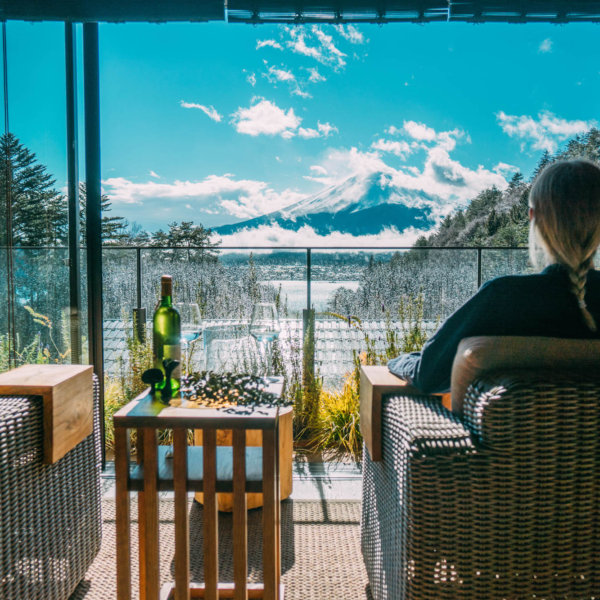
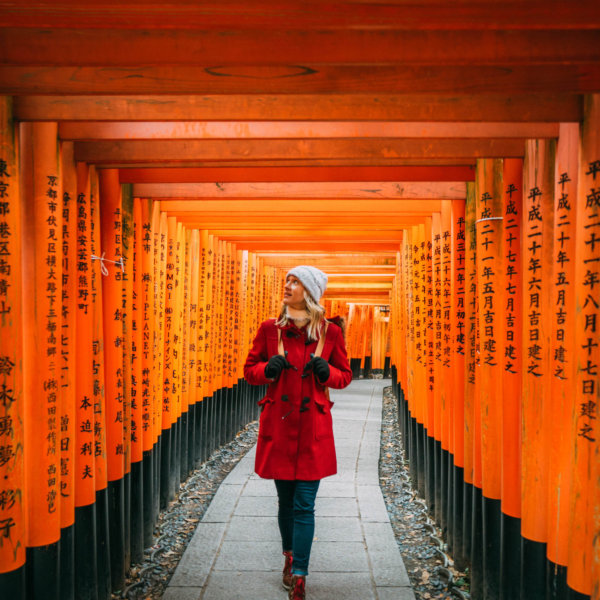



2 comments
Jennifer
This post is amazing Lauren!! I was supposed to go to Japan this year for my birthday, but with covid-19 and all we had to postpone. I cannot wait to visit Japan one day soon! Memories of a Geisha is also my all time favourite book!
Lauren Mae Pelkey
Hi Jennifer – thank you so much for the kind feedback! I am so sorry that you had to postpone your bday trip but you know what, it’s going to make next year’s visit even that much sweeter!!! Ps. Love that MOAG is one of your favorites too. Sending you love and hope you are safe & healthy!